BSBINM501 Manage an Information or Knowledge Management System Learner Workbook
VerifiedAdded on 2023/06/07
|50
|8538
|79
AI Summary
This is a learner workbook for BSBINM501 Manage an Information or Knowledge Management System. It includes instructions to the learner, assessment requirements, candidate details, observation/demonstration guide, and third party guide. The assessment can be done through direct observation, product-based methods, portfolios, questioning, or third party evidence. The third party guide provides details on how to nominate a third party for observations or demonstrations.
Contribute Materials
Your contribution can guide someone’s learning journey. Share your
documents today.
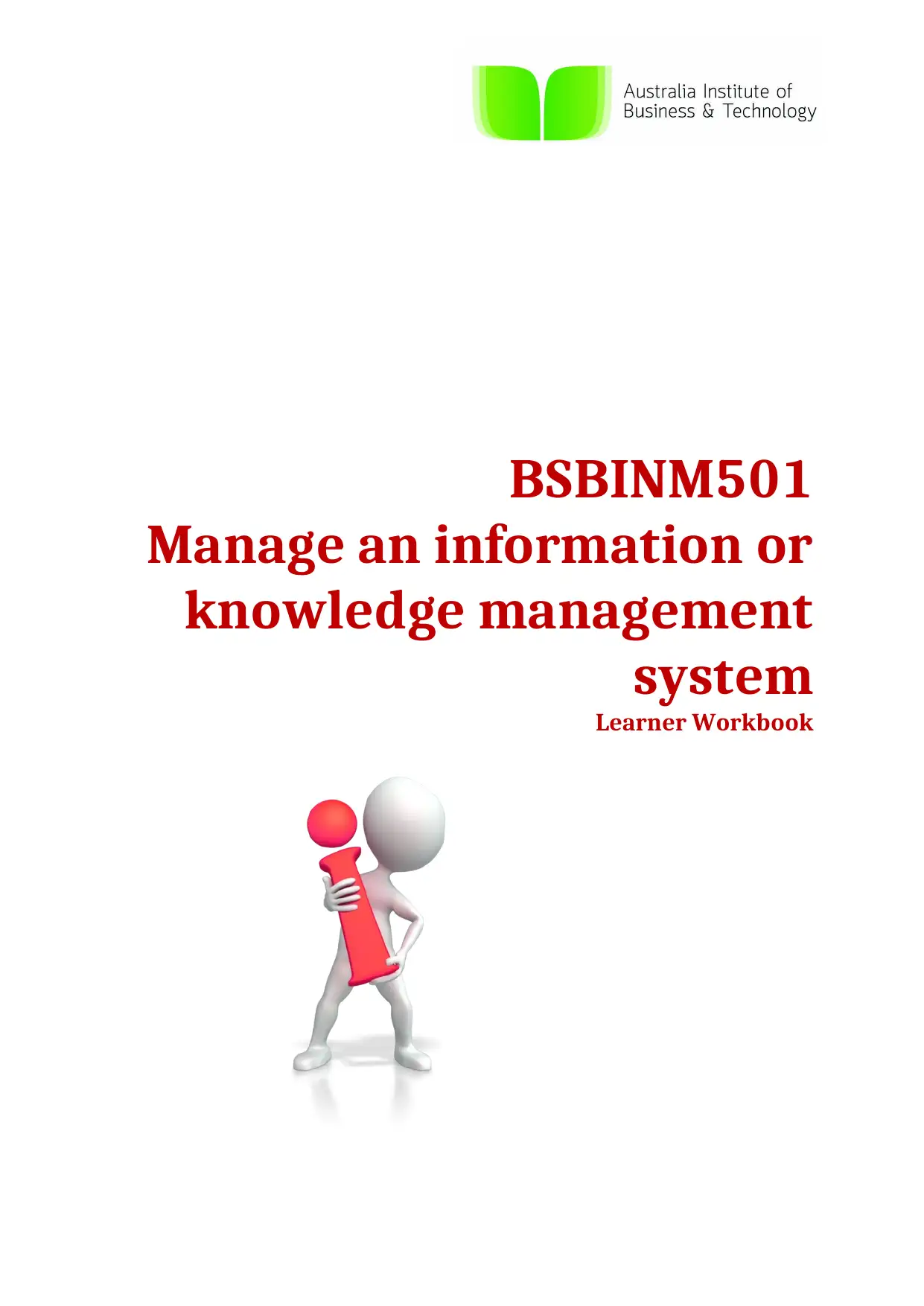
BSBINM501
Manage an information or
knowledge management
system
Learner Workbook
Manage an information or
knowledge management
system
Learner Workbook
Secure Best Marks with AI Grader
Need help grading? Try our AI Grader for instant feedback on your assignments.
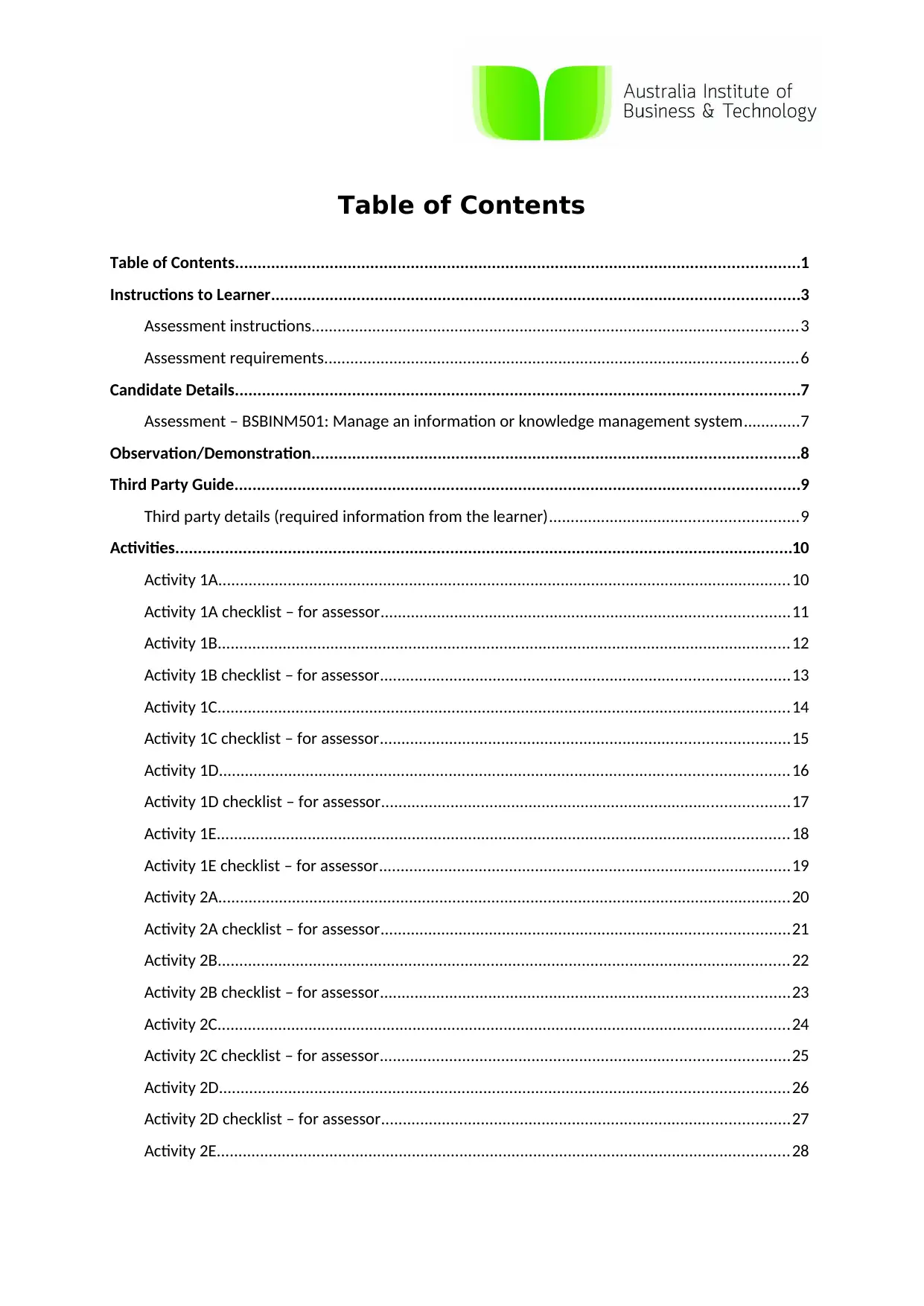
Table of Contents
Table of Contents.............................................................................................................................1
Instructions to Learner.....................................................................................................................3
Assessment instructions................................................................................................................3
Assessment requirements.............................................................................................................6
Candidate Details.............................................................................................................................7
Assessment – BSBINM501: Manage an information or knowledge management system.............7
Observation/Demonstration............................................................................................................8
Third Party Guide.............................................................................................................................9
Third party details (required information from the learner).........................................................9
Activities.........................................................................................................................................10
Activity 1A....................................................................................................................................10
Activity 1A checklist – for assessor..............................................................................................11
Activity 1B....................................................................................................................................12
Activity 1B checklist – for assessor..............................................................................................13
Activity 1C....................................................................................................................................14
Activity 1C checklist – for assessor..............................................................................................15
Activity 1D...................................................................................................................................16
Activity 1D checklist – for assessor..............................................................................................17
Activity 1E....................................................................................................................................18
Activity 1E checklist – for assessor...............................................................................................19
Activity 2A....................................................................................................................................20
Activity 2A checklist – for assessor..............................................................................................21
Activity 2B....................................................................................................................................22
Activity 2B checklist – for assessor..............................................................................................23
Activity 2C....................................................................................................................................24
Activity 2C checklist – for assessor..............................................................................................25
Activity 2D...................................................................................................................................26
Activity 2D checklist – for assessor..............................................................................................27
Activity 2E....................................................................................................................................28
Table of Contents.............................................................................................................................1
Instructions to Learner.....................................................................................................................3
Assessment instructions................................................................................................................3
Assessment requirements.............................................................................................................6
Candidate Details.............................................................................................................................7
Assessment – BSBINM501: Manage an information or knowledge management system.............7
Observation/Demonstration............................................................................................................8
Third Party Guide.............................................................................................................................9
Third party details (required information from the learner).........................................................9
Activities.........................................................................................................................................10
Activity 1A....................................................................................................................................10
Activity 1A checklist – for assessor..............................................................................................11
Activity 1B....................................................................................................................................12
Activity 1B checklist – for assessor..............................................................................................13
Activity 1C....................................................................................................................................14
Activity 1C checklist – for assessor..............................................................................................15
Activity 1D...................................................................................................................................16
Activity 1D checklist – for assessor..............................................................................................17
Activity 1E....................................................................................................................................18
Activity 1E checklist – for assessor...............................................................................................19
Activity 2A....................................................................................................................................20
Activity 2A checklist – for assessor..............................................................................................21
Activity 2B....................................................................................................................................22
Activity 2B checklist – for assessor..............................................................................................23
Activity 2C....................................................................................................................................24
Activity 2C checklist – for assessor..............................................................................................25
Activity 2D...................................................................................................................................26
Activity 2D checklist – for assessor..............................................................................................27
Activity 2E....................................................................................................................................28
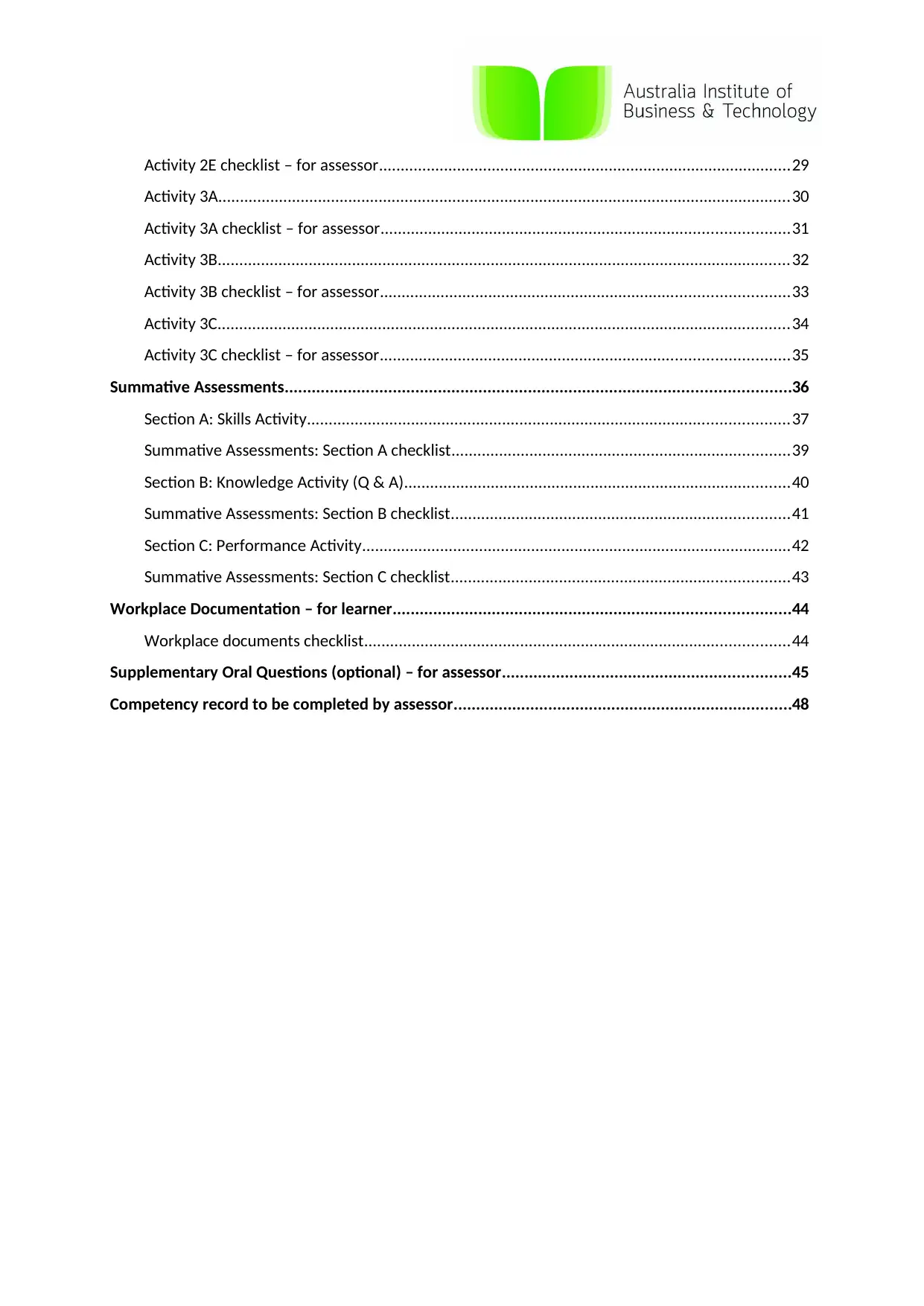
Activity 2E checklist – for assessor...............................................................................................29
Activity 3A....................................................................................................................................30
Activity 3A checklist – for assessor..............................................................................................31
Activity 3B....................................................................................................................................32
Activity 3B checklist – for assessor..............................................................................................33
Activity 3C....................................................................................................................................34
Activity 3C checklist – for assessor..............................................................................................35
Summative Assessments................................................................................................................36
Section A: Skills Activity...............................................................................................................37
Summative Assessments: Section A checklist..............................................................................39
Section B: Knowledge Activity (Q & A).........................................................................................40
Summative Assessments: Section B checklist..............................................................................41
Section C: Performance Activity...................................................................................................42
Summative Assessments: Section C checklist..............................................................................43
Workplace Documentation – for learner........................................................................................44
Workplace documents checklist..................................................................................................44
Supplementary Oral Questions (optional) – for assessor................................................................45
Competency record to be completed by assessor...........................................................................48
Activity 3A....................................................................................................................................30
Activity 3A checklist – for assessor..............................................................................................31
Activity 3B....................................................................................................................................32
Activity 3B checklist – for assessor..............................................................................................33
Activity 3C....................................................................................................................................34
Activity 3C checklist – for assessor..............................................................................................35
Summative Assessments................................................................................................................36
Section A: Skills Activity...............................................................................................................37
Summative Assessments: Section A checklist..............................................................................39
Section B: Knowledge Activity (Q & A).........................................................................................40
Summative Assessments: Section B checklist..............................................................................41
Section C: Performance Activity...................................................................................................42
Summative Assessments: Section C checklist..............................................................................43
Workplace Documentation – for learner........................................................................................44
Workplace documents checklist..................................................................................................44
Supplementary Oral Questions (optional) – for assessor................................................................45
Competency record to be completed by assessor...........................................................................48
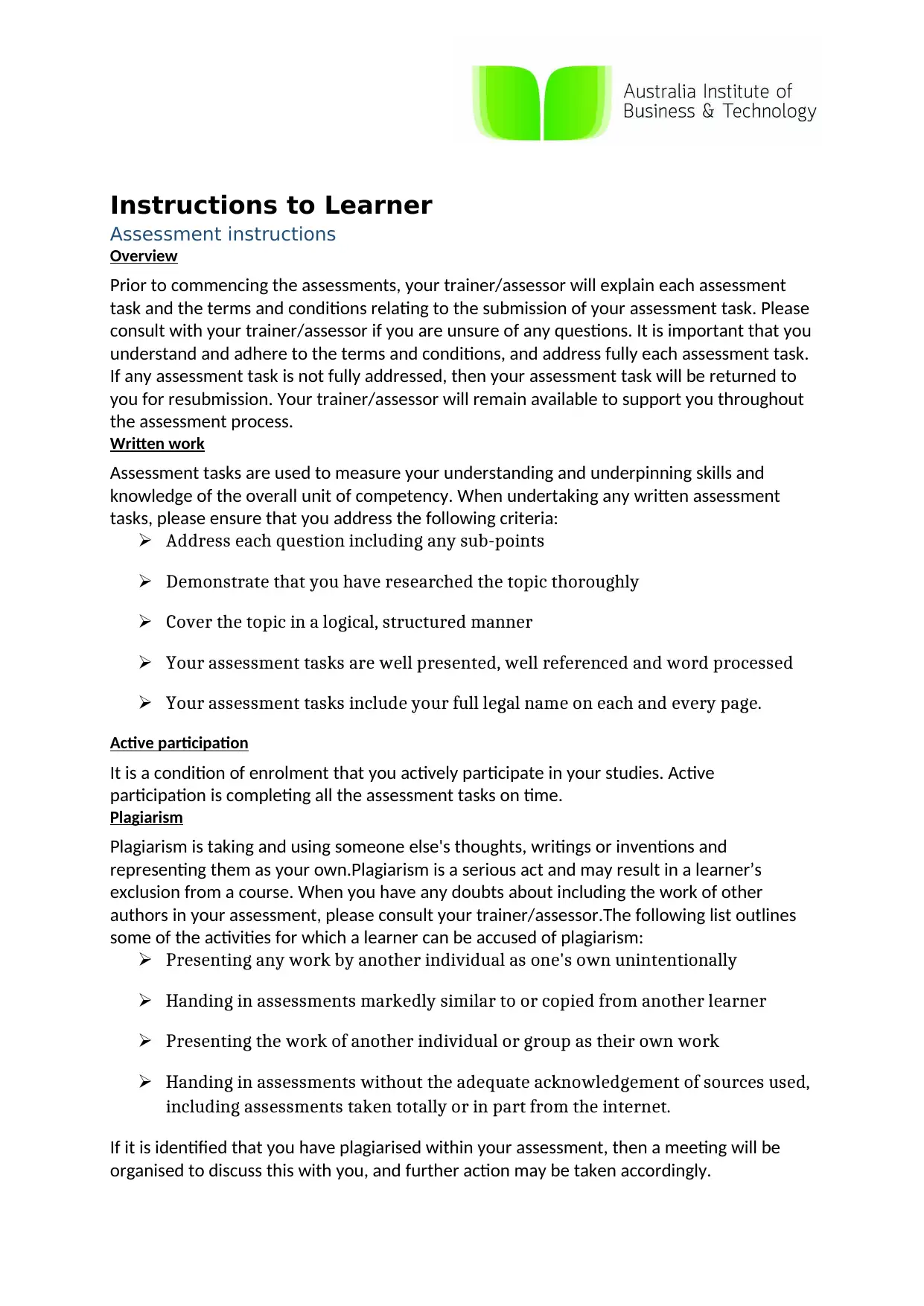
Instructions to Learner
Assessment instructions
Overview
Prior to commencing the assessments, your trainer/assessor will explain each assessment
task and the terms and conditions relating to the submission of your assessment task. Please
consult with your trainer/assessor if you are unsure of any questions. It is important that you
understand and adhere to the terms and conditions, and address fully each assessment task.
If any assessment task is not fully addressed, then your assessment task will be returned to
you for resubmission. Your trainer/assessor will remain available to support you throughout
the assessment process.
Written work
Assessment tasks are used to measure your understanding and underpinning skills and
knowledge of the overall unit of competency. When undertaking any written assessment
tasks, please ensure that you address the following criteria:
Address each question including any sub-points
Demonstrate that you have researched the topic thoroughly
Cover the topic in a logical, structured manner
Your assessment tasks are well presented, well referenced and word processed
Your assessment tasks include your full legal name on each and every page.
Active participation
It is a condition of enrolment that you actively participate in your studies. Active
participation is completing all the assessment tasks on time.
Plagiarism
Plagiarism is taking and using someone else's thoughts, writings or inventions and
representing them as your own.Plagiarism is a serious act and may result in a learner’s
exclusion from a course. When you have any doubts about including the work of other
authors in your assessment, please consult your trainer/assessor.The following list outlines
some of the activities for which a learner can be accused of plagiarism:
Presenting any work by another individual as one's own unintentionally
Handing in assessments markedly similar to or copied from another learner
Presenting the work of another individual or group as their own work
Handing in assessments without the adequate acknowledgement of sources used,
including assessments taken totally or in part from the internet.
If it is identified that you have plagiarised within your assessment, then a meeting will be
organised to discuss this with you, and further action may be taken accordingly.
Assessment instructions
Overview
Prior to commencing the assessments, your trainer/assessor will explain each assessment
task and the terms and conditions relating to the submission of your assessment task. Please
consult with your trainer/assessor if you are unsure of any questions. It is important that you
understand and adhere to the terms and conditions, and address fully each assessment task.
If any assessment task is not fully addressed, then your assessment task will be returned to
you for resubmission. Your trainer/assessor will remain available to support you throughout
the assessment process.
Written work
Assessment tasks are used to measure your understanding and underpinning skills and
knowledge of the overall unit of competency. When undertaking any written assessment
tasks, please ensure that you address the following criteria:
Address each question including any sub-points
Demonstrate that you have researched the topic thoroughly
Cover the topic in a logical, structured manner
Your assessment tasks are well presented, well referenced and word processed
Your assessment tasks include your full legal name on each and every page.
Active participation
It is a condition of enrolment that you actively participate in your studies. Active
participation is completing all the assessment tasks on time.
Plagiarism
Plagiarism is taking and using someone else's thoughts, writings or inventions and
representing them as your own.Plagiarism is a serious act and may result in a learner’s
exclusion from a course. When you have any doubts about including the work of other
authors in your assessment, please consult your trainer/assessor.The following list outlines
some of the activities for which a learner can be accused of plagiarism:
Presenting any work by another individual as one's own unintentionally
Handing in assessments markedly similar to or copied from another learner
Presenting the work of another individual or group as their own work
Handing in assessments without the adequate acknowledgement of sources used,
including assessments taken totally or in part from the internet.
If it is identified that you have plagiarised within your assessment, then a meeting will be
organised to discuss this with you, and further action may be taken accordingly.
Secure Best Marks with AI Grader
Need help grading? Try our AI Grader for instant feedback on your assignments.
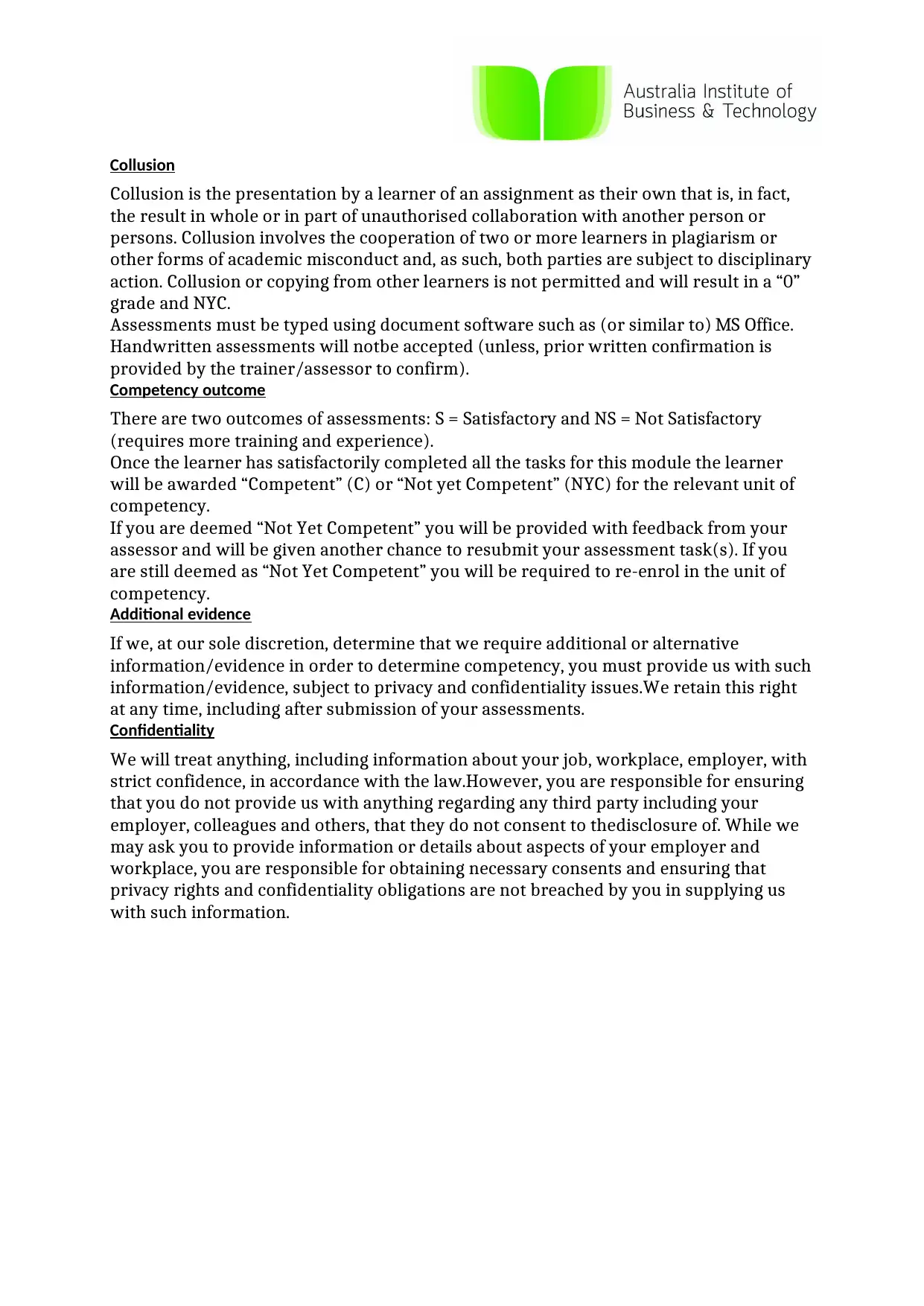
Collusion
Collusion is the presentation by a learner of an assignment as their own that is, in fact,
the result in whole or in part of unauthorised collaboration with another person or
persons. Collusion involves the cooperation of two or more learners in plagiarism or
other forms of academic misconduct and, as such, both parties are subject to disciplinary
action. Collusion or copying from other learners is not permitted and will result in a “0”
grade and NYC.
Assessments must be typed using document software such as (or similar to) MS Office.
Handwritten assessments will notbe accepted (unless, prior written confirmation is
provided by the trainer/assessor to confirm).
Competency outcome
There are two outcomes of assessments: S = Satisfactory and NS = Not Satisfactory
(requires more training and experience).
Once the learner has satisfactorily completed all the tasks for this module the learner
will be awarded “Competent” (C) or “Not yet Competent” (NYC) for the relevant unit of
competency.
If you are deemed “Not Yet Competent” you will be provided with feedback from your
assessor and will be given another chance to resubmit your assessment task(s). If you
are still deemed as “Not Yet Competent” you will be required to re-enrol in the unit of
competency.
Additional evidence
If we, at our sole discretion, determine that we require additional or alternative
information/evidence in order to determine competency, you must provide us with such
information/evidence, subject to privacy and confidentiality issues.We retain this right
at any time, including after submission of your assessments.
Confidentiality
We will treat anything, including information about your job, workplace, employer, with
strict confidence, in accordance with the law.However, you are responsible for ensuring
that you do not provide us with anything regarding any third party including your
employer, colleagues and others, that they do not consent to thedisclosure of. While we
may ask you to provide information or details about aspects of your employer and
workplace, you are responsible for obtaining necessary consents and ensuring that
privacy rights and confidentiality obligations are not breached by you in supplying us
with such information.
Collusion is the presentation by a learner of an assignment as their own that is, in fact,
the result in whole or in part of unauthorised collaboration with another person or
persons. Collusion involves the cooperation of two or more learners in plagiarism or
other forms of academic misconduct and, as such, both parties are subject to disciplinary
action. Collusion or copying from other learners is not permitted and will result in a “0”
grade and NYC.
Assessments must be typed using document software such as (or similar to) MS Office.
Handwritten assessments will notbe accepted (unless, prior written confirmation is
provided by the trainer/assessor to confirm).
Competency outcome
There are two outcomes of assessments: S = Satisfactory and NS = Not Satisfactory
(requires more training and experience).
Once the learner has satisfactorily completed all the tasks for this module the learner
will be awarded “Competent” (C) or “Not yet Competent” (NYC) for the relevant unit of
competency.
If you are deemed “Not Yet Competent” you will be provided with feedback from your
assessor and will be given another chance to resubmit your assessment task(s). If you
are still deemed as “Not Yet Competent” you will be required to re-enrol in the unit of
competency.
Additional evidence
If we, at our sole discretion, determine that we require additional or alternative
information/evidence in order to determine competency, you must provide us with such
information/evidence, subject to privacy and confidentiality issues.We retain this right
at any time, including after submission of your assessments.
Confidentiality
We will treat anything, including information about your job, workplace, employer, with
strict confidence, in accordance with the law.However, you are responsible for ensuring
that you do not provide us with anything regarding any third party including your
employer, colleagues and others, that they do not consent to thedisclosure of. While we
may ask you to provide information or details about aspects of your employer and
workplace, you are responsible for obtaining necessary consents and ensuring that
privacy rights and confidentiality obligations are not breached by you in supplying us
with such information.
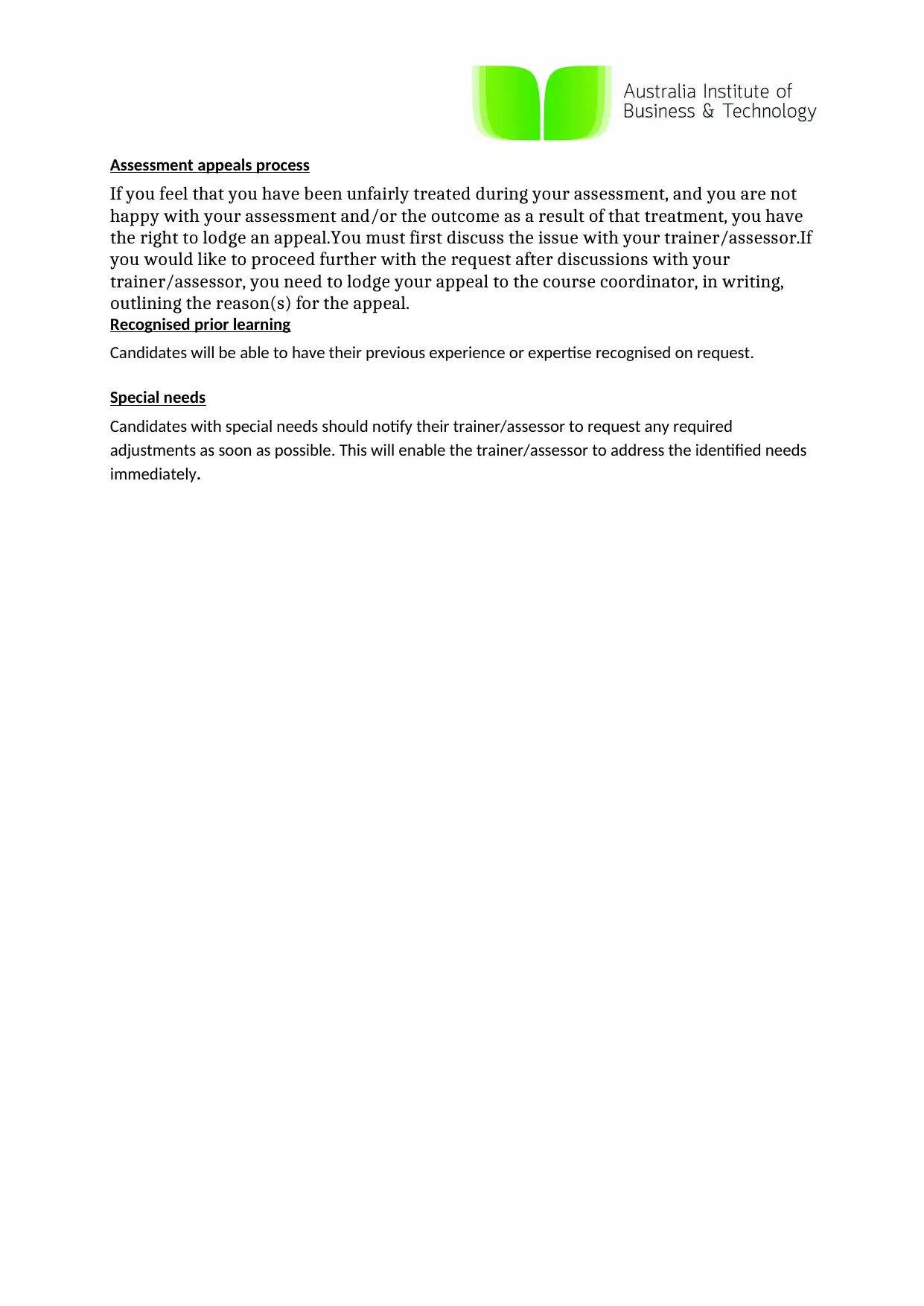
Assessment appeals process
If you feel that you have been unfairly treated during your assessment, and you are not
happy with your assessment and/or the outcome as a result of that treatment, you have
the right to lodge an appeal.You must first discuss the issue with your trainer/assessor.If
you would like to proceed further with the request after discussions with your
trainer/assessor, you need to lodge your appeal to the course coordinator, in writing,
outlining the reason(s) for the appeal.
Recognised prior learning
Candidates will be able to have their previous experience or expertise recognised on request.
Special needs
Candidates with special needs should notify their trainer/assessor to request any required
adjustments as soon as possible. This will enable the trainer/assessor to address the identified needs
immediately .
If you feel that you have been unfairly treated during your assessment, and you are not
happy with your assessment and/or the outcome as a result of that treatment, you have
the right to lodge an appeal.You must first discuss the issue with your trainer/assessor.If
you would like to proceed further with the request after discussions with your
trainer/assessor, you need to lodge your appeal to the course coordinator, in writing,
outlining the reason(s) for the appeal.
Recognised prior learning
Candidates will be able to have their previous experience or expertise recognised on request.
Special needs
Candidates with special needs should notify their trainer/assessor to request any required
adjustments as soon as possible. This will enable the trainer/assessor to address the identified needs
immediately .
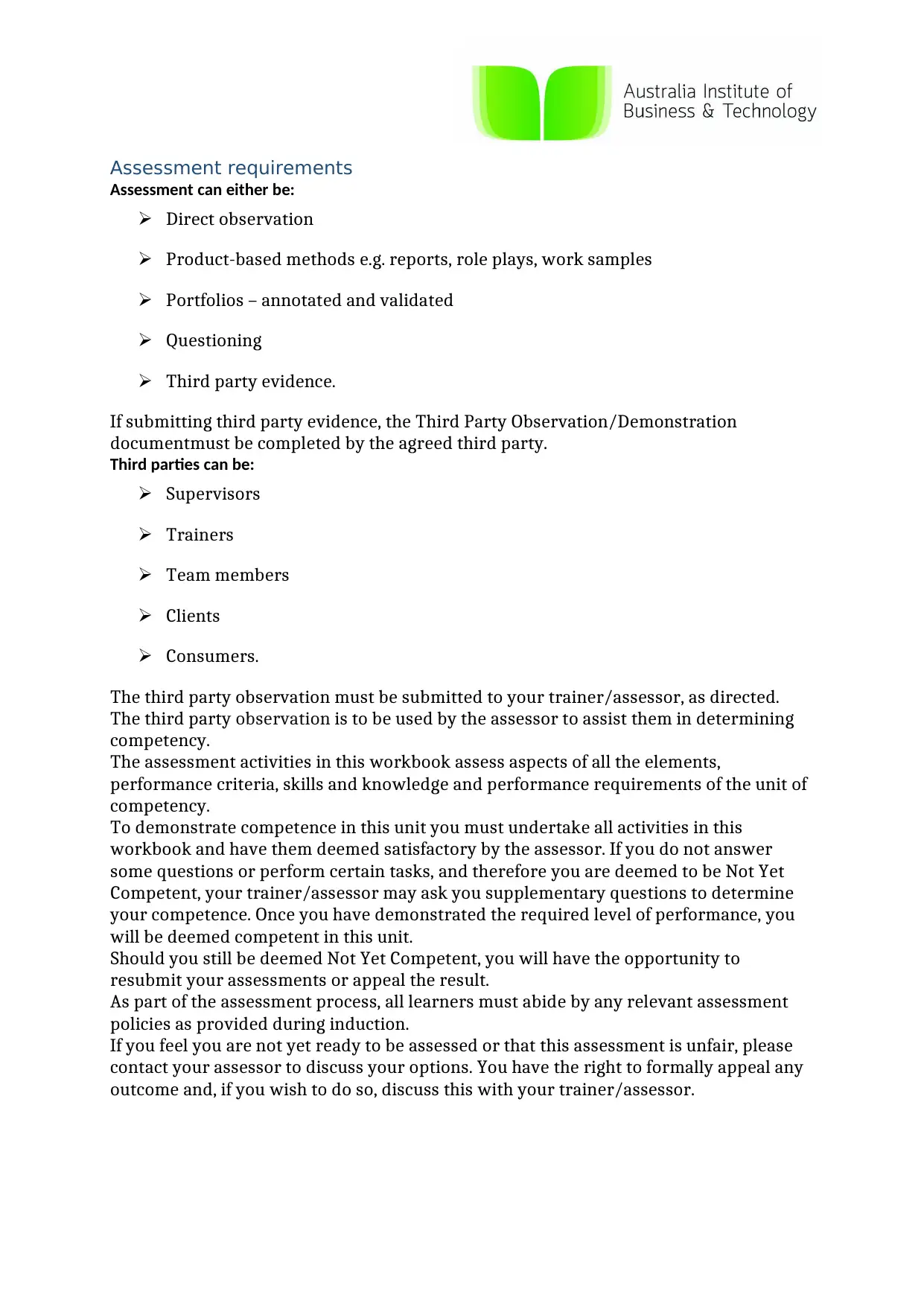
Assessment requirements
Assessment can either be:
Direct observation
Product-based methods e.g. reports, role plays, work samples
Portfolios – annotated and validated
Questioning
Third party evidence.
If submitting third party evidence, the Third Party Observation/Demonstration
documentmust be completed by the agreed third party.
Third parties can be:
Supervisors
Trainers
Team members
Clients
Consumers.
The third party observation must be submitted to your trainer/assessor, as directed.
The third party observation is to be used by the assessor to assist them in determining
competency.
The assessment activities in this workbook assess aspects of all the elements,
performance criteria, skills and knowledge and performance requirements of the unit of
competency.
To demonstrate competence in this unit you must undertake all activities in this
workbook and have them deemed satisfactory by the assessor. If you do not answer
some questions or perform certain tasks, and therefore you are deemed to be Not Yet
Competent, your trainer/assessor may ask you supplementary questions to determine
your competence. Once you have demonstrated the required level of performance, you
will be deemed competent in this unit.
Should you still be deemed Not Yet Competent, you will have the opportunity to
resubmit your assessments or appeal the result.
As part of the assessment process, all learners must abide by any relevant assessment
policies as provided during induction.
If you feel you are not yet ready to be assessed or that this assessment is unfair, please
contact your assessor to discuss your options. You have the right to formally appeal any
outcome and, if you wish to do so, discuss this with your trainer/assessor.
Assessment can either be:
Direct observation
Product-based methods e.g. reports, role plays, work samples
Portfolios – annotated and validated
Questioning
Third party evidence.
If submitting third party evidence, the Third Party Observation/Demonstration
documentmust be completed by the agreed third party.
Third parties can be:
Supervisors
Trainers
Team members
Clients
Consumers.
The third party observation must be submitted to your trainer/assessor, as directed.
The third party observation is to be used by the assessor to assist them in determining
competency.
The assessment activities in this workbook assess aspects of all the elements,
performance criteria, skills and knowledge and performance requirements of the unit of
competency.
To demonstrate competence in this unit you must undertake all activities in this
workbook and have them deemed satisfactory by the assessor. If you do not answer
some questions or perform certain tasks, and therefore you are deemed to be Not Yet
Competent, your trainer/assessor may ask you supplementary questions to determine
your competence. Once you have demonstrated the required level of performance, you
will be deemed competent in this unit.
Should you still be deemed Not Yet Competent, you will have the opportunity to
resubmit your assessments or appeal the result.
As part of the assessment process, all learners must abide by any relevant assessment
policies as provided during induction.
If you feel you are not yet ready to be assessed or that this assessment is unfair, please
contact your assessor to discuss your options. You have the right to formally appeal any
outcome and, if you wish to do so, discuss this with your trainer/assessor.
Paraphrase This Document
Need a fresh take? Get an instant paraphrase of this document with our AI Paraphraser
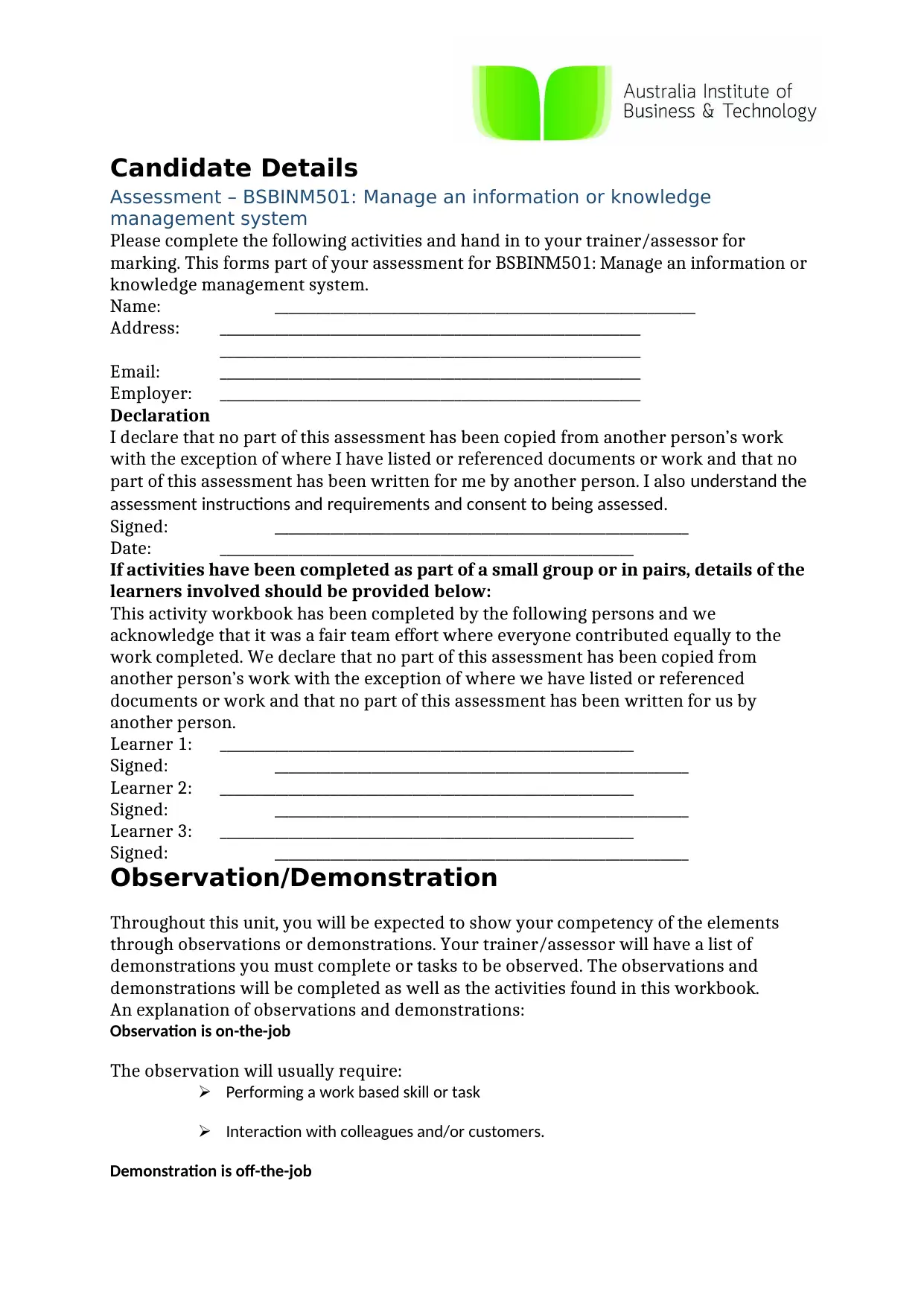
Candidate Details
Assessment – BSBINM501: Manage an information or knowledge
management system
Please complete the following activities and hand in to your trainer/assessor for
marking. This forms part of your assessment for BSBINM501: Manage an information or
knowledge management system.
Name: _____________________________________________________________
Address: _____________________________________________________________
_____________________________________________________________
Email: _____________________________________________________________
Employer: _____________________________________________________________
Declaration
I declare that no part of this assessment has been copied from another person’s work
with the exception of where I have listed or referenced documents or work and that no
part of this assessment has been written for me by another person. I also understand the
assessment instructions and requirements and consent to being assessed.
Signed: ____________________________________________________________
Date: ____________________________________________________________
If activities have been completed as part of a small group or in pairs, details of the
learners involved should be provided below:
This activity workbook has been completed by the following persons and we
acknowledge that it was a fair team effort where everyone contributed equally to the
work completed. We declare that no part of this assessment has been copied from
another person’s work with the exception of where we have listed or referenced
documents or work and that no part of this assessment has been written for us by
another person.
Learner 1: ____________________________________________________________
Signed: ____________________________________________________________
Learner 2: ____________________________________________________________
Signed: ____________________________________________________________
Learner 3: ____________________________________________________________
Signed: ____________________________________________________________
Observation/Demonstration
Throughout this unit, you will be expected to show your competency of the elements
through observations or demonstrations. Your trainer/assessor will have a list of
demonstrations you must complete or tasks to be observed. The observations and
demonstrations will be completed as well as the activities found in this workbook.
An explanation of observations and demonstrations:
Observation is on-the-job
The observation will usually require:
Performing a work based skill or task
Interaction with colleagues and/or customers.
Demonstration is off-the-job
Assessment – BSBINM501: Manage an information or knowledge
management system
Please complete the following activities and hand in to your trainer/assessor for
marking. This forms part of your assessment for BSBINM501: Manage an information or
knowledge management system.
Name: _____________________________________________________________
Address: _____________________________________________________________
_____________________________________________________________
Email: _____________________________________________________________
Employer: _____________________________________________________________
Declaration
I declare that no part of this assessment has been copied from another person’s work
with the exception of where I have listed or referenced documents or work and that no
part of this assessment has been written for me by another person. I also understand the
assessment instructions and requirements and consent to being assessed.
Signed: ____________________________________________________________
Date: ____________________________________________________________
If activities have been completed as part of a small group or in pairs, details of the
learners involved should be provided below:
This activity workbook has been completed by the following persons and we
acknowledge that it was a fair team effort where everyone contributed equally to the
work completed. We declare that no part of this assessment has been copied from
another person’s work with the exception of where we have listed or referenced
documents or work and that no part of this assessment has been written for us by
another person.
Learner 1: ____________________________________________________________
Signed: ____________________________________________________________
Learner 2: ____________________________________________________________
Signed: ____________________________________________________________
Learner 3: ____________________________________________________________
Signed: ____________________________________________________________
Observation/Demonstration
Throughout this unit, you will be expected to show your competency of the elements
through observations or demonstrations. Your trainer/assessor will have a list of
demonstrations you must complete or tasks to be observed. The observations and
demonstrations will be completed as well as the activities found in this workbook.
An explanation of observations and demonstrations:
Observation is on-the-job
The observation will usually require:
Performing a work based skill or task
Interaction with colleagues and/or customers.
Demonstration is off-the-job
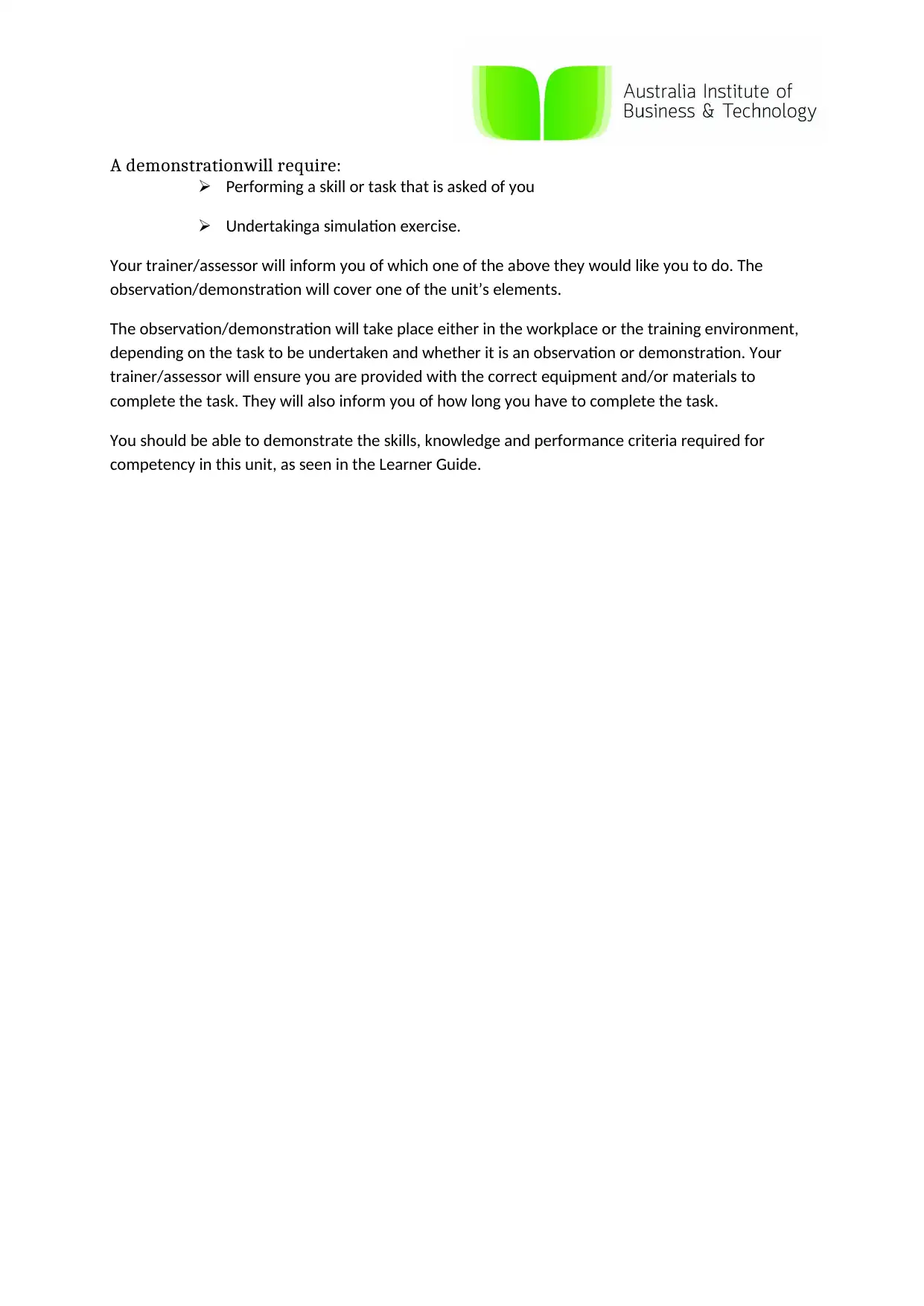
A demonstrationwill require:
Performing a skill or task that is asked of you
Undertakinga simulation exercise.
Your trainer/assessor will inform you of which one of the above they would like you to do. The
observation/demonstration will cover one of the unit’s elements.
The observation/demonstration will take place either in the workplace or the training environment,
depending on the task to be undertaken and whether it is an observation or demonstration. Your
trainer/assessor will ensure you are provided with the correct equipment and/or materials to
complete the task. They will also inform you of how long you have to complete the task.
You should be able to demonstrate the skills, knowledge and performance criteria required for
competency in this unit, as seen in the Learner Guide.
Performing a skill or task that is asked of you
Undertakinga simulation exercise.
Your trainer/assessor will inform you of which one of the above they would like you to do. The
observation/demonstration will cover one of the unit’s elements.
The observation/demonstration will take place either in the workplace or the training environment,
depending on the task to be undertaken and whether it is an observation or demonstration. Your
trainer/assessor will ensure you are provided with the correct equipment and/or materials to
complete the task. They will also inform you of how long you have to complete the task.
You should be able to demonstrate the skills, knowledge and performance criteria required for
competency in this unit, as seen in the Learner Guide.

Third Party Guide
You should supply details of the third party to the assessor before you commence the
activities (see below), unless the assessor has already selected a third party themselves.
The assessor can then contact the third party in instances where they require more
evidence to determine competency, or they cannot observe certain tasks themselves.
The reasons to use a third party may include:
Assessment is required in the workplace
Where there are health and safety issues related to observation
Patient confidentiality and privacy issues are involved.
If you are not employed, or able to complete demonstrative tasks in the workplace, you
will need to inform the assessor. They will be able to provide you with a simulated
environment in which to complete these tasks.
We would prefer that, wherever possible, these be “live” issues for your industry and
require application of the principles that you are learning as part of your training.Where
this is not possible, you and your third party should simulate the activity tasks and
demonstrations that you believe would be likely to arise in your organisation or job role.
Third party evidence can also be used to provide “everyday evidence” of tasks included
in your work role that relate to the unit of competency but are not a part of the formal
assessment process.
The third party is not to be used as a co-assessor – the assessor must make the final
decision on competency themselves.
Documents relevant to collection of third party evidence are included in the Third Party
section in the Observations/Demonstrations document.
Third party details (required information from the learner)
A third party may be required for observations or demonstrations; please provide
details below of your nominated third party and obtain their signature to confirm their
agreement to participate. This information will be required by your trainer/assessor in
advance of arranging any future observations or demonstrations.
Third party name: ______________________________________________________________
Position of third party: ______________________________________________________________
Telephone number: ______________________________________________________________
Email address: ______________________________________________________________
Declaration for nominated third party
I declare my intention to act as third party for (learner’s name here)
__________________________
Third party signature: _____________________________________ Date: ___________________
Activities
Complete the following activities individually or in a group (as applicable to the specific activity and
the assessment environment).
Where applicable, a signed observation by either an approved third party or the assessor will need
to be included in these activities as proof of completion.
You should supply details of the third party to the assessor before you commence the
activities (see below), unless the assessor has already selected a third party themselves.
The assessor can then contact the third party in instances where they require more
evidence to determine competency, or they cannot observe certain tasks themselves.
The reasons to use a third party may include:
Assessment is required in the workplace
Where there are health and safety issues related to observation
Patient confidentiality and privacy issues are involved.
If you are not employed, or able to complete demonstrative tasks in the workplace, you
will need to inform the assessor. They will be able to provide you with a simulated
environment in which to complete these tasks.
We would prefer that, wherever possible, these be “live” issues for your industry and
require application of the principles that you are learning as part of your training.Where
this is not possible, you and your third party should simulate the activity tasks and
demonstrations that you believe would be likely to arise in your organisation or job role.
Third party evidence can also be used to provide “everyday evidence” of tasks included
in your work role that relate to the unit of competency but are not a part of the formal
assessment process.
The third party is not to be used as a co-assessor – the assessor must make the final
decision on competency themselves.
Documents relevant to collection of third party evidence are included in the Third Party
section in the Observations/Demonstrations document.
Third party details (required information from the learner)
A third party may be required for observations or demonstrations; please provide
details below of your nominated third party and obtain their signature to confirm their
agreement to participate. This information will be required by your trainer/assessor in
advance of arranging any future observations or demonstrations.
Third party name: ______________________________________________________________
Position of third party: ______________________________________________________________
Telephone number: ______________________________________________________________
Email address: ______________________________________________________________
Declaration for nominated third party
I declare my intention to act as third party for (learner’s name here)
__________________________
Third party signature: _____________________________________ Date: ___________________
Activities
Complete the following activities individually or in a group (as applicable to the specific activity and
the assessment environment).
Where applicable, a signed observation by either an approved third party or the assessor will need
to be included in these activities as proof of completion.
Secure Best Marks with AI Grader
Need help grading? Try our AI Grader for instant feedback on your assignments.
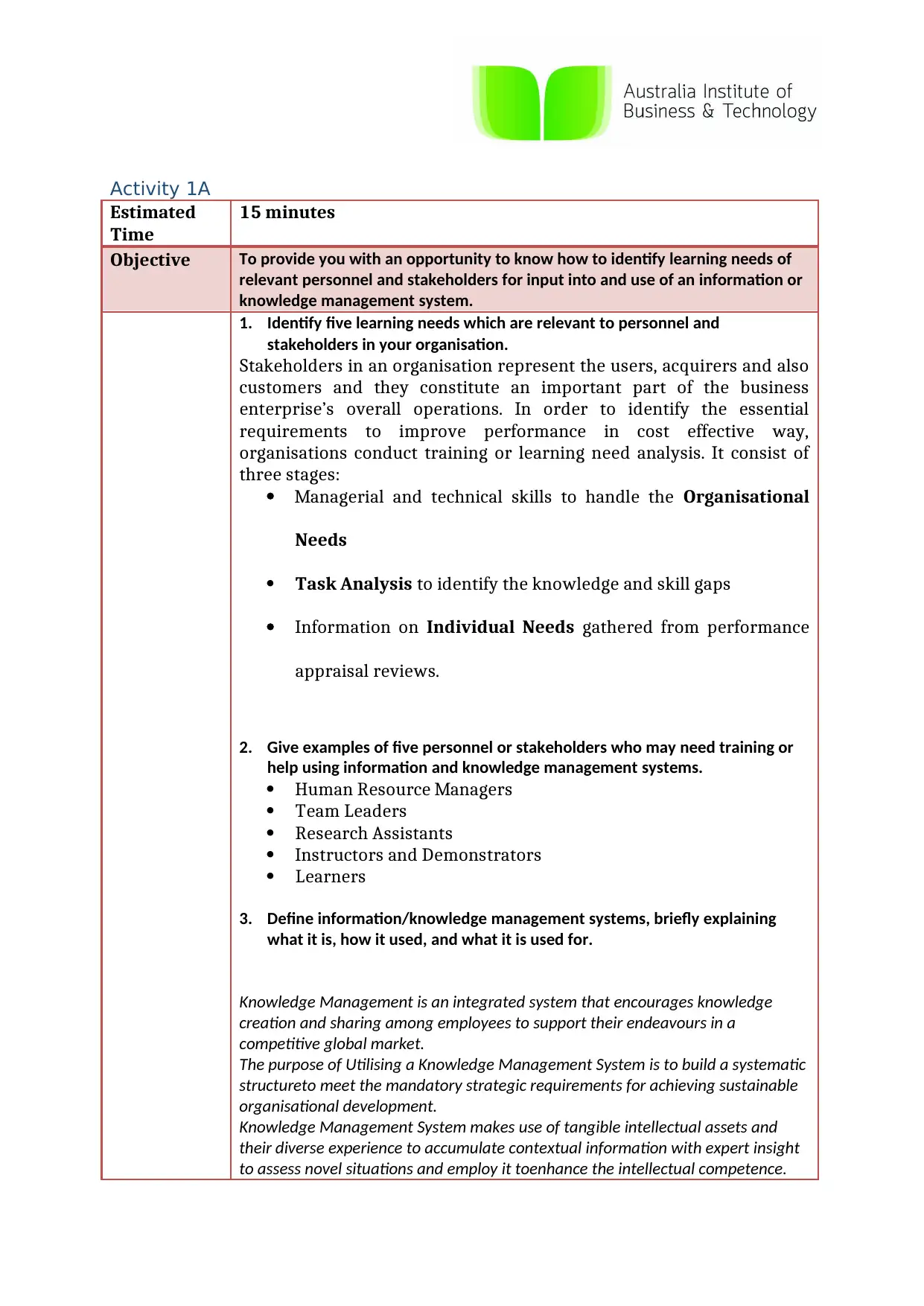
Activity 1A
Estimated
Time
15 minutes
Objective To provide you with an opportunity to know how to identify learning needs of
relevant personnel and stakeholders for input into and use of an information or
knowledge management system.
1. Identify five learning needs which are relevant to personnel and
stakeholders in your organisation.
Stakeholders in an organisation represent the users, acquirers and also
customers and they constitute an important part of the business
enterprise’s overall operations. In order to identify the essential
requirements to improve performance in cost effective way,
organisations conduct training or learning need analysis. It consist of
three stages:
Managerial and technical skills to handle the Organisational
Needs
Task Analysis to identify the knowledge and skill gaps
Information on Individual Needs gathered from performance
appraisal reviews.
2. Give examples of five personnel or stakeholders who may need training or
help using information and knowledge management systems.
Human Resource Managers
Team Leaders
Research Assistants
Instructors and Demonstrators
Learners
3. Define information/knowledge management systems, briefly explaining
what it is, how it used, and what it is used for.
Knowledge Management is an integrated system that encourages knowledge
creation and sharing among employees to support their endeavours in a
competitive global market.
The purpose of Utilising a Knowledge Management System is to build a systematic
structureto meet the mandatory strategic requirements for achieving sustainable
organisational development.
Knowledge Management System makes use of tangible intellectual assets and
their diverse experience to accumulate contextual information with expert insight
to assess novel situations and employ it toenhance the intellectual competence.
Estimated
Time
15 minutes
Objective To provide you with an opportunity to know how to identify learning needs of
relevant personnel and stakeholders for input into and use of an information or
knowledge management system.
1. Identify five learning needs which are relevant to personnel and
stakeholders in your organisation.
Stakeholders in an organisation represent the users, acquirers and also
customers and they constitute an important part of the business
enterprise’s overall operations. In order to identify the essential
requirements to improve performance in cost effective way,
organisations conduct training or learning need analysis. It consist of
three stages:
Managerial and technical skills to handle the Organisational
Needs
Task Analysis to identify the knowledge and skill gaps
Information on Individual Needs gathered from performance
appraisal reviews.
2. Give examples of five personnel or stakeholders who may need training or
help using information and knowledge management systems.
Human Resource Managers
Team Leaders
Research Assistants
Instructors and Demonstrators
Learners
3. Define information/knowledge management systems, briefly explaining
what it is, how it used, and what it is used for.
Knowledge Management is an integrated system that encourages knowledge
creation and sharing among employees to support their endeavours in a
competitive global market.
The purpose of Utilising a Knowledge Management System is to build a systematic
structureto meet the mandatory strategic requirements for achieving sustainable
organisational development.
Knowledge Management System makes use of tangible intellectual assets and
their diverse experience to accumulate contextual information with expert insight
to assess novel situations and employ it toenhance the intellectual competence.

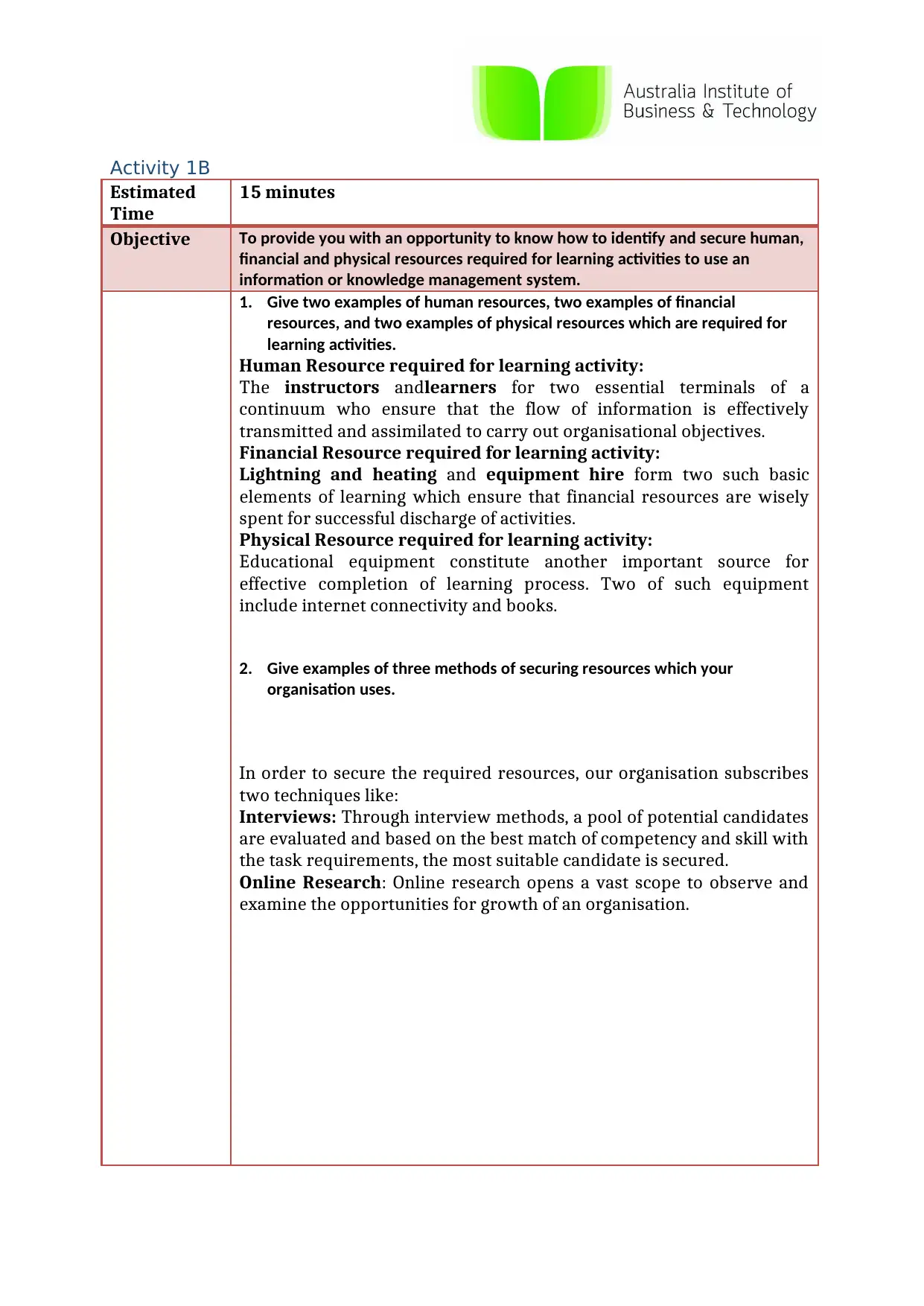
Activity 1B
Estimated
Time
15 minutes
Objective To provide you with an opportunity to know how to identify and secure human,
financial and physical resources required for learning activities to use an
information or knowledge management system.
1. Give two examples of human resources, two examples of financial
resources, and two examples of physical resources which are required for
learning activities.
Human Resource required for learning activity:
The instructors andlearners for two essential terminals of a
continuum who ensure that the flow of information is effectively
transmitted and assimilated to carry out organisational objectives.
Financial Resource required for learning activity:
Lightning and heating and equipment hire form two such basic
elements of learning which ensure that financial resources are wisely
spent for successful discharge of activities.
Physical Resource required for learning activity:
Educational equipment constitute another important source for
effective completion of learning process. Two of such equipment
include internet connectivity and books.
2. Give examples of three methods of securing resources which your
organisation uses.
In order to secure the required resources, our organisation subscribes
two techniques like:
Interviews: Through interview methods, a pool of potential candidates
are evaluated and based on the best match of competency and skill with
the task requirements, the most suitable candidate is secured.
Online Research: Online research opens a vast scope to observe and
examine the opportunities for growth of an organisation.
Estimated
Time
15 minutes
Objective To provide you with an opportunity to know how to identify and secure human,
financial and physical resources required for learning activities to use an
information or knowledge management system.
1. Give two examples of human resources, two examples of financial
resources, and two examples of physical resources which are required for
learning activities.
Human Resource required for learning activity:
The instructors andlearners for two essential terminals of a
continuum who ensure that the flow of information is effectively
transmitted and assimilated to carry out organisational objectives.
Financial Resource required for learning activity:
Lightning and heating and equipment hire form two such basic
elements of learning which ensure that financial resources are wisely
spent for successful discharge of activities.
Physical Resource required for learning activity:
Educational equipment constitute another important source for
effective completion of learning process. Two of such equipment
include internet connectivity and books.
2. Give examples of three methods of securing resources which your
organisation uses.
In order to secure the required resources, our organisation subscribes
two techniques like:
Interviews: Through interview methods, a pool of potential candidates
are evaluated and based on the best match of competency and skill with
the task requirements, the most suitable candidate is secured.
Online Research: Online research opens a vast scope to observe and
examine the opportunities for growth of an organisation.
Paraphrase This Document
Need a fresh take? Get an instant paraphrase of this document with our AI Paraphraser
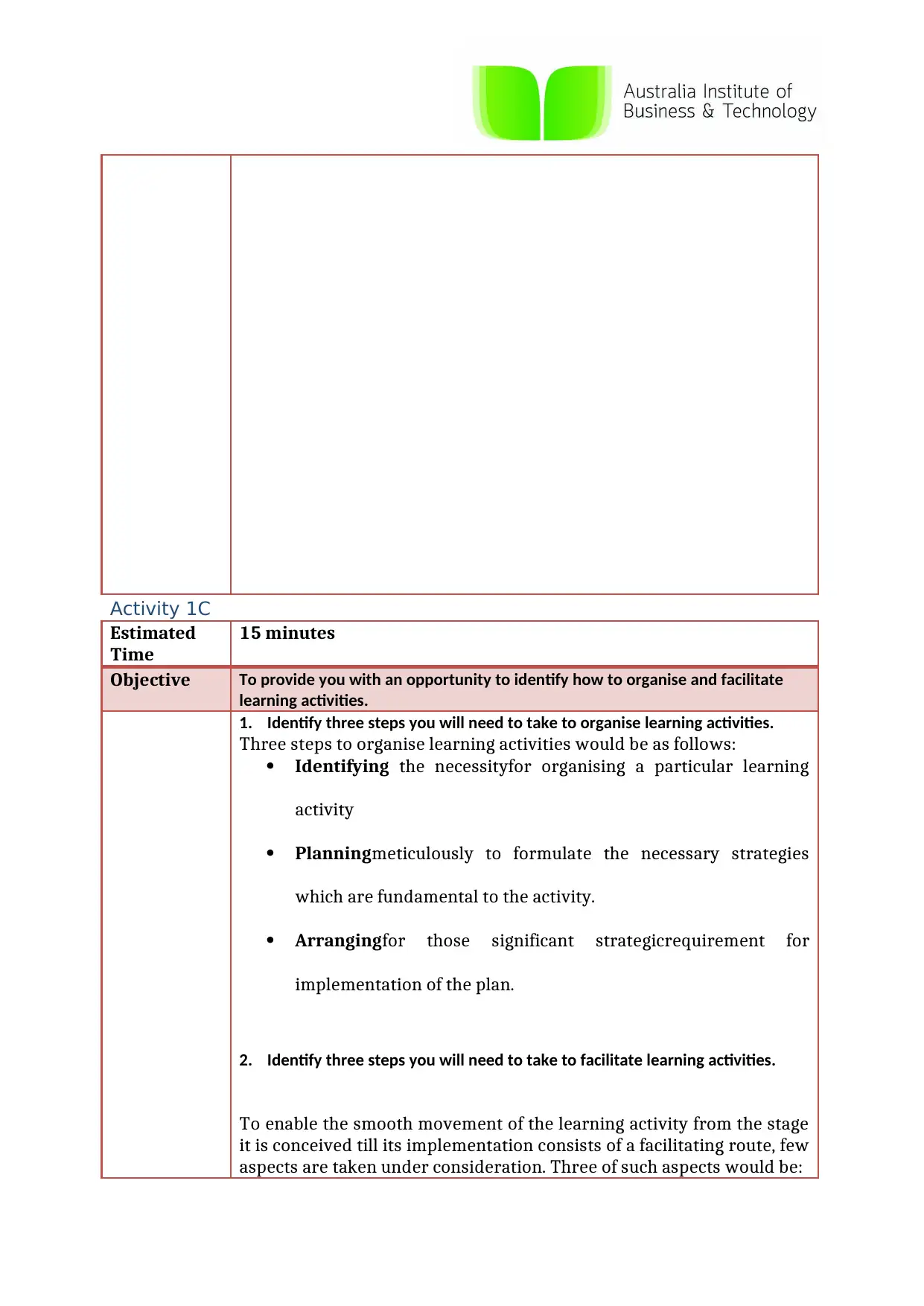
Activity 1C
Estimated
Time
15 minutes
Objective To provide you with an opportunity to identify how to organise and facilitate
learning activities.
1. Identify three steps you will need to take to organise learning activities.
Three steps to organise learning activities would be as follows:
Identifying the necessityfor organising a particular learning
activity
Planningmeticulously to formulate the necessary strategies
which are fundamental to the activity.
Arrangingfor those significant strategicrequirement for
implementation of the plan.
2. Identify three steps you will need to take to facilitate learning activities.
To enable the smooth movement of the learning activity from the stage
it is conceived till its implementation consists of a facilitating route, few
aspects are taken under consideration. Three of such aspects would be:
Estimated
Time
15 minutes
Objective To provide you with an opportunity to identify how to organise and facilitate
learning activities.
1. Identify three steps you will need to take to organise learning activities.
Three steps to organise learning activities would be as follows:
Identifying the necessityfor organising a particular learning
activity
Planningmeticulously to formulate the necessary strategies
which are fundamental to the activity.
Arrangingfor those significant strategicrequirement for
implementation of the plan.
2. Identify three steps you will need to take to facilitate learning activities.
To enable the smooth movement of the learning activity from the stage
it is conceived till its implementation consists of a facilitating route, few
aspects are taken under consideration. Three of such aspects would be:
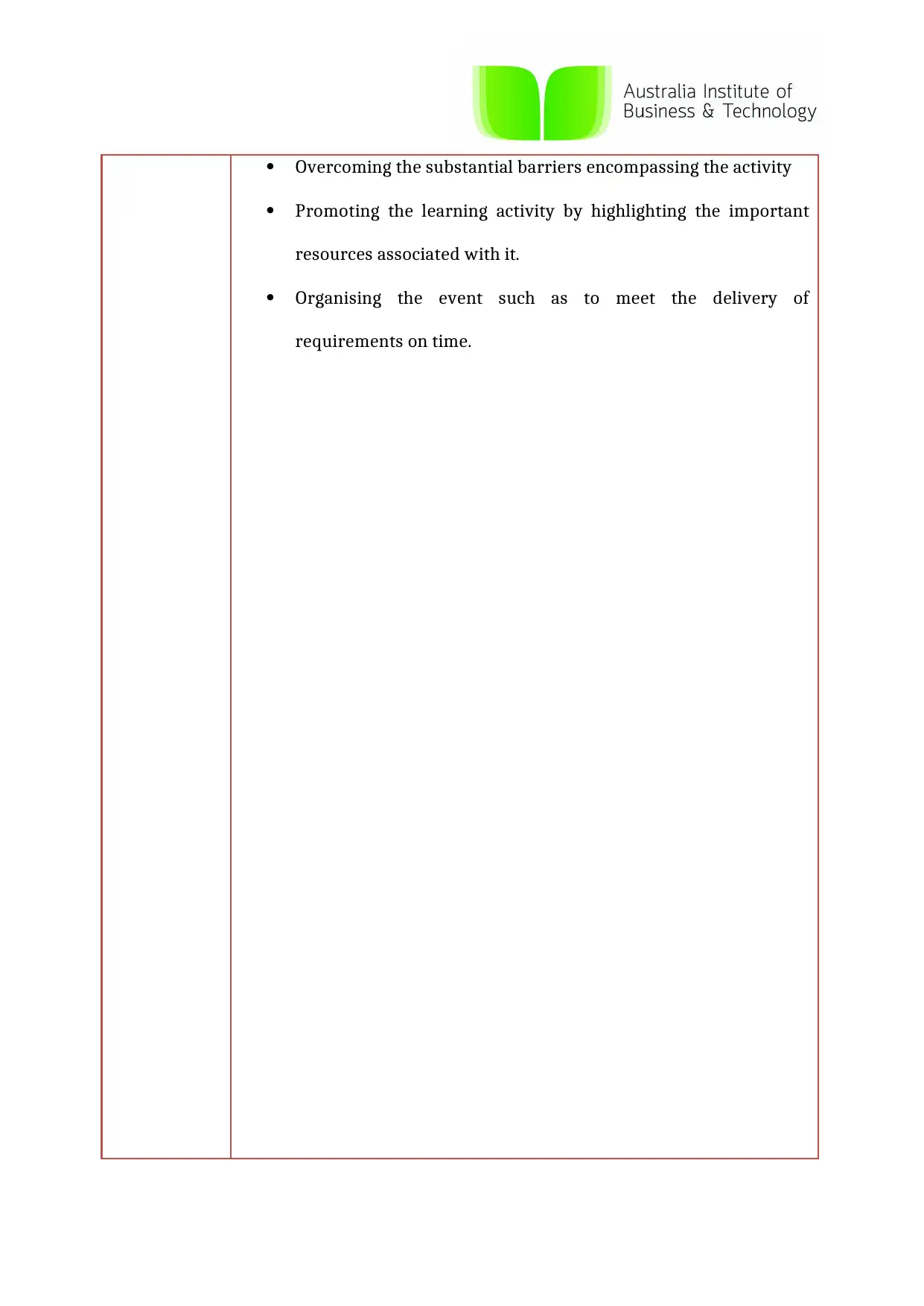
Overcoming the substantial barriers encompassing the activity
Promoting the learning activity by highlighting the important
resources associated with it.
Organising the event such as to meet the delivery of
requirements on time.
Promoting the learning activity by highlighting the important
resources associated with it.
Organising the event such as to meet the delivery of
requirements on time.
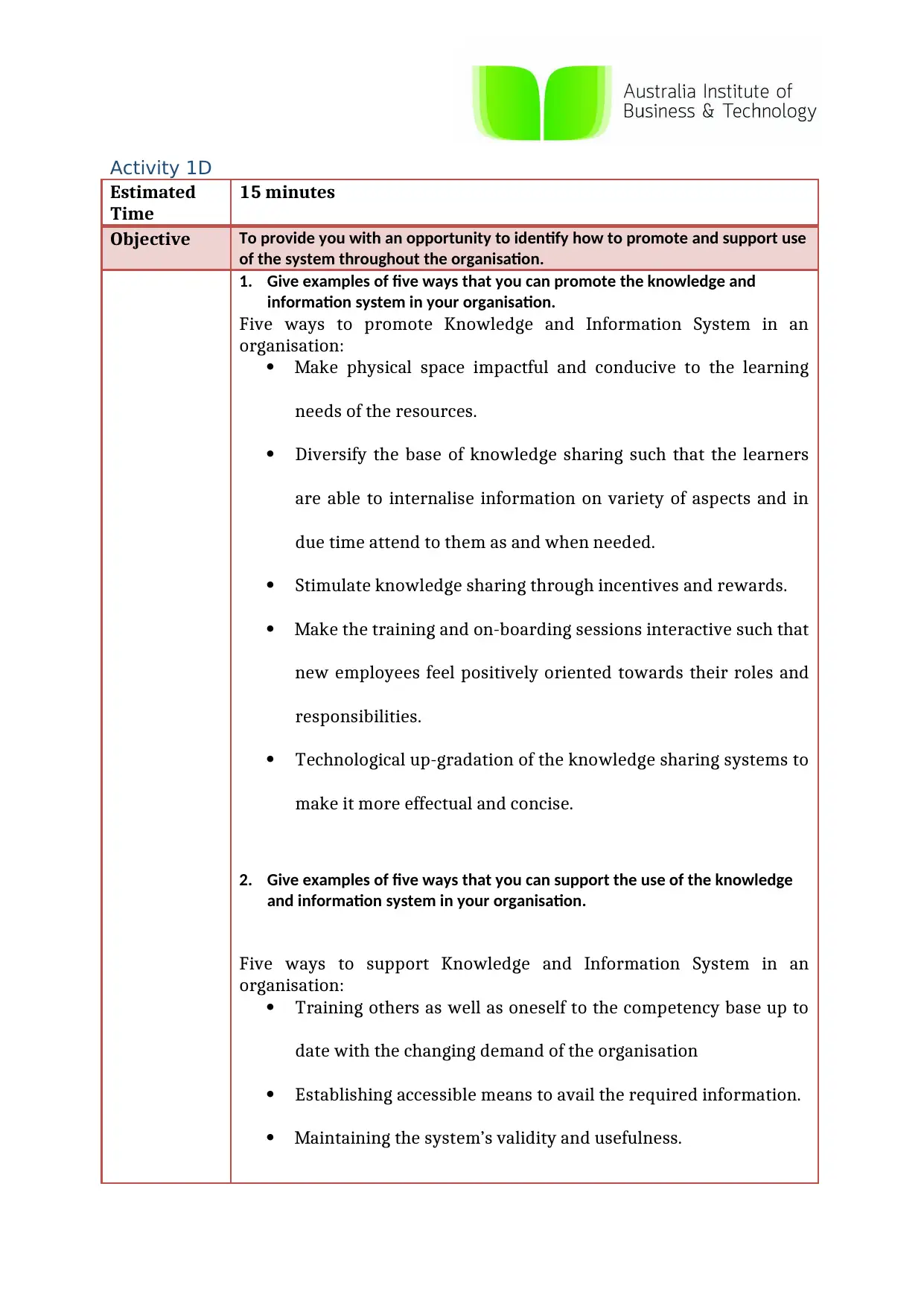
Activity 1D
Estimated
Time
15 minutes
Objective To provide you with an opportunity to identify how to promote and support use
of the system throughout the organisation.
1. Give examples of five ways that you can promote the knowledge and
information system in your organisation.
Five ways to promote Knowledge and Information System in an
organisation:
Make physical space impactful and conducive to the learning
needs of the resources.
Diversify the base of knowledge sharing such that the learners
are able to internalise information on variety of aspects and in
due time attend to them as and when needed.
Stimulate knowledge sharing through incentives and rewards.
Make the training and on-boarding sessions interactive such that
new employees feel positively oriented towards their roles and
responsibilities.
Technological up-gradation of the knowledge sharing systems to
make it more effectual and concise.
2. Give examples of five ways that you can support the use of the knowledge
and information system in your organisation.
Five ways to support Knowledge and Information System in an
organisation:
Training others as well as oneself to the competency base up to
date with the changing demand of the organisation
Establishing accessible means to avail the required information.
Maintaining the system’s validity and usefulness.
Estimated
Time
15 minutes
Objective To provide you with an opportunity to identify how to promote and support use
of the system throughout the organisation.
1. Give examples of five ways that you can promote the knowledge and
information system in your organisation.
Five ways to promote Knowledge and Information System in an
organisation:
Make physical space impactful and conducive to the learning
needs of the resources.
Diversify the base of knowledge sharing such that the learners
are able to internalise information on variety of aspects and in
due time attend to them as and when needed.
Stimulate knowledge sharing through incentives and rewards.
Make the training and on-boarding sessions interactive such that
new employees feel positively oriented towards their roles and
responsibilities.
Technological up-gradation of the knowledge sharing systems to
make it more effectual and concise.
2. Give examples of five ways that you can support the use of the knowledge
and information system in your organisation.
Five ways to support Knowledge and Information System in an
organisation:
Training others as well as oneself to the competency base up to
date with the changing demand of the organisation
Establishing accessible means to avail the required information.
Maintaining the system’s validity and usefulness.
Secure Best Marks with AI Grader
Need help grading? Try our AI Grader for instant feedback on your assignments.

Taking note of misconceptions and incorrect procedures of
assimilation and adapting positive initiatives to correct them
Tacking issues effectively when they occur.
Activity 1E
Estimated
Time
15 minutes
Objective To provide you with an opportunity to identify how to monitor and document
effectiveness of learning activities.
assimilation and adapting positive initiatives to correct them
Tacking issues effectively when they occur.
Activity 1E
Estimated
Time
15 minutes
Objective To provide you with an opportunity to identify how to monitor and document
effectiveness of learning activities.
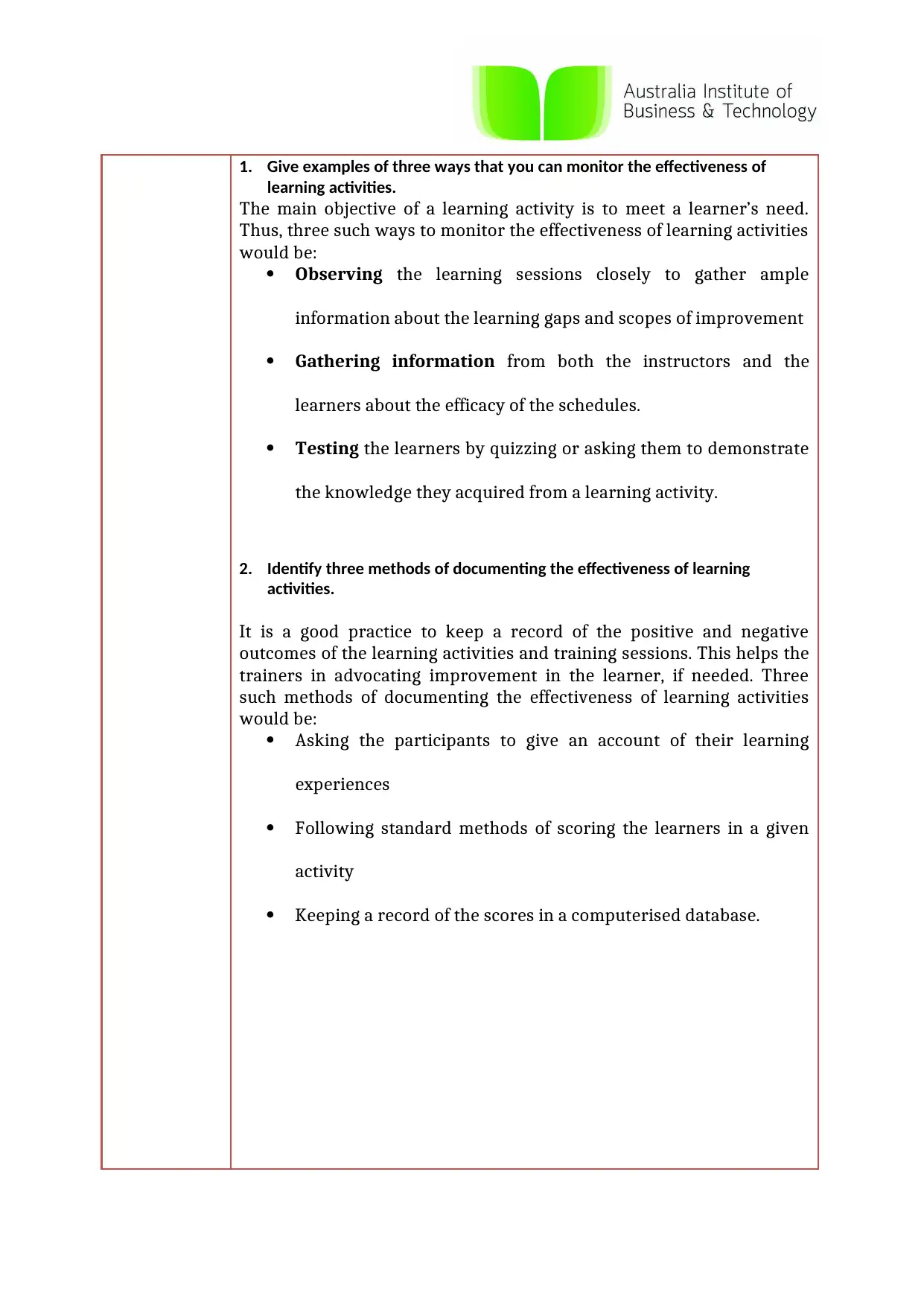
1. Give examples of three ways that you can monitor the effectiveness of
learning activities.
The main objective of a learning activity is to meet a learner’s need.
Thus, three such ways to monitor the effectiveness of learning activities
would be:
Observing the learning sessions closely to gather ample
information about the learning gaps and scopes of improvement
Gathering information from both the instructors and the
learners about the efficacy of the schedules.
Testing the learners by quizzing or asking them to demonstrate
the knowledge they acquired from a learning activity.
2. Identify three methods of documenting the effectiveness of learning
activities.
It is a good practice to keep a record of the positive and negative
outcomes of the learning activities and training sessions. This helps the
trainers in advocating improvement in the learner, if needed. Three
such methods of documenting the effectiveness of learning activities
would be:
Asking the participants to give an account of their learning
experiences
Following standard methods of scoring the learners in a given
activity
Keeping a record of the scores in a computerised database.
learning activities.
The main objective of a learning activity is to meet a learner’s need.
Thus, three such ways to monitor the effectiveness of learning activities
would be:
Observing the learning sessions closely to gather ample
information about the learning gaps and scopes of improvement
Gathering information from both the instructors and the
learners about the efficacy of the schedules.
Testing the learners by quizzing or asking them to demonstrate
the knowledge they acquired from a learning activity.
2. Identify three methods of documenting the effectiveness of learning
activities.
It is a good practice to keep a record of the positive and negative
outcomes of the learning activities and training sessions. This helps the
trainers in advocating improvement in the learner, if needed. Three
such methods of documenting the effectiveness of learning activities
would be:
Asking the participants to give an account of their learning
experiences
Following standard methods of scoring the learners in a given
activity
Keeping a record of the scores in a computerised database.

Paraphrase This Document
Need a fresh take? Get an instant paraphrase of this document with our AI Paraphraser
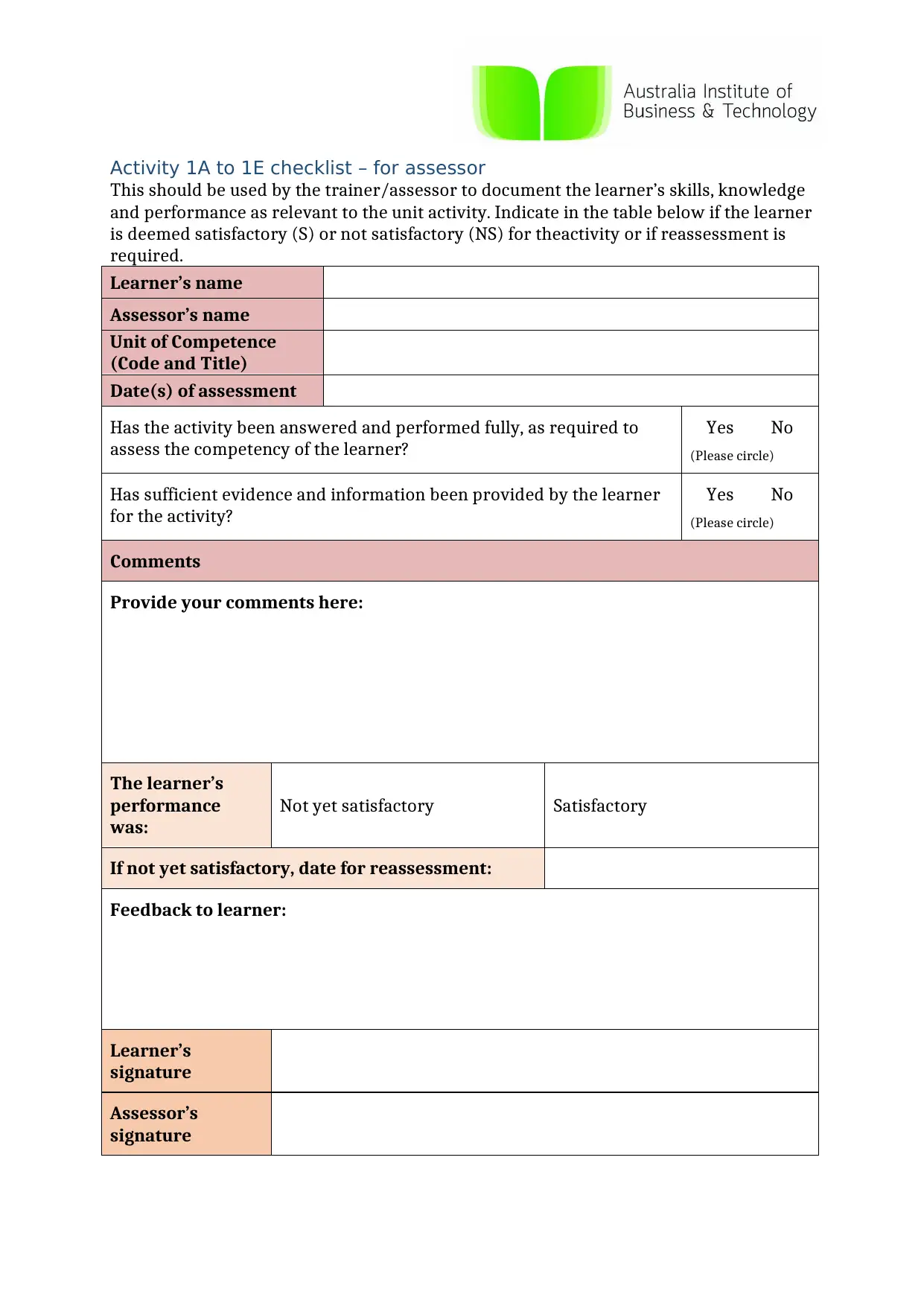
Activity 1A to 1E checklist – for assessor
This should be used by the trainer/assessor to document the learner’s skills, knowledge
and performance as relevant to the unit activity. Indicate in the table below if the learner
is deemed satisfactory (S) or not satisfactory (NS) for theactivity or if reassessment is
required.
Learner’s name
Assessor’s name
Unit of Competence
(Code and Title)
Date(s) of assessment
Has the activity been answered and performed fully, as required to
assess the competency of the learner?
Yes No
(Please circle)
Has sufficient evidence and information been provided by the learner
for the activity?
Yes No
(Please circle)
Comments
Provide your comments here:
The learner’s
performance
was:
Not yet satisfactory Satisfactory
If not yet satisfactory, date for reassessment:
Feedback to learner:
Learner’s
signature
Assessor’s
signature
This should be used by the trainer/assessor to document the learner’s skills, knowledge
and performance as relevant to the unit activity. Indicate in the table below if the learner
is deemed satisfactory (S) or not satisfactory (NS) for theactivity or if reassessment is
required.
Learner’s name
Assessor’s name
Unit of Competence
(Code and Title)
Date(s) of assessment
Has the activity been answered and performed fully, as required to
assess the competency of the learner?
Yes No
(Please circle)
Has sufficient evidence and information been provided by the learner
for the activity?
Yes No
(Please circle)
Comments
Provide your comments here:
The learner’s
performance
was:
Not yet satisfactory Satisfactory
If not yet satisfactory, date for reassessment:
Feedback to learner:
Learner’s
signature
Assessor’s
signature
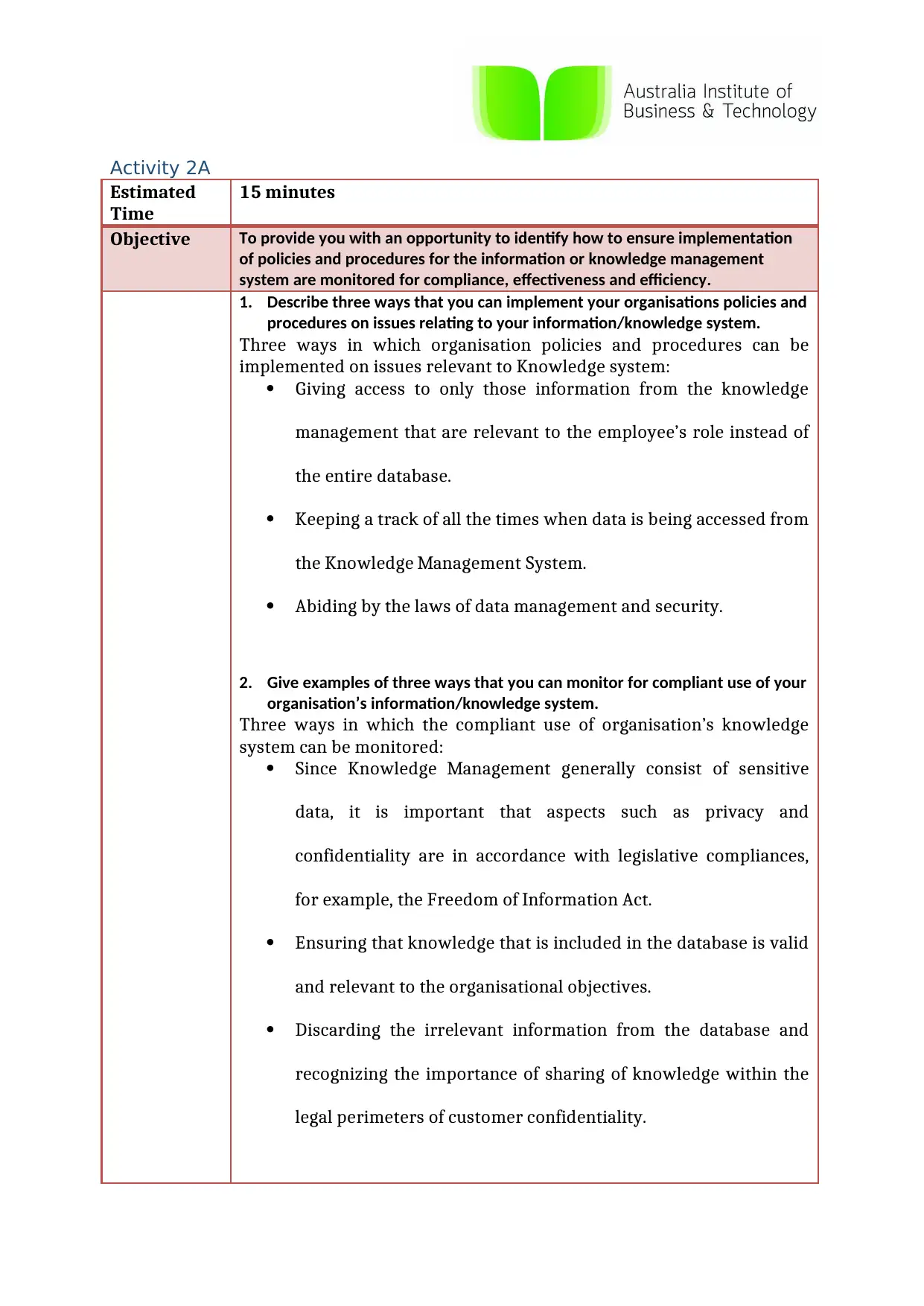
Activity 2A
Estimated
Time
15 minutes
Objective To provide you with an opportunity to identify how to ensure implementation
of policies and procedures for the information or knowledge management
system are monitored for compliance, effectiveness and efficiency.
1. Describe three ways that you can implement your organisations policies and
procedures on issues relating to your information/knowledge system.
Three ways in which organisation policies and procedures can be
implemented on issues relevant to Knowledge system:
Giving access to only those information from the knowledge
management that are relevant to the employee’s role instead of
the entire database.
Keeping a track of all the times when data is being accessed from
the Knowledge Management System.
Abiding by the laws of data management and security.
2. Give examples of three ways that you can monitor for compliant use of your
organisation’s information/knowledge system.
Three ways in which the compliant use of organisation’s knowledge
system can be monitored:
Since Knowledge Management generally consist of sensitive
data, it is important that aspects such as privacy and
confidentiality are in accordance with legislative compliances,
for example, the Freedom of Information Act.
Ensuring that knowledge that is included in the database is valid
and relevant to the organisational objectives.
Discarding the irrelevant information from the database and
recognizing the importance of sharing of knowledge within the
legal perimeters of customer confidentiality.
Estimated
Time
15 minutes
Objective To provide you with an opportunity to identify how to ensure implementation
of policies and procedures for the information or knowledge management
system are monitored for compliance, effectiveness and efficiency.
1. Describe three ways that you can implement your organisations policies and
procedures on issues relating to your information/knowledge system.
Three ways in which organisation policies and procedures can be
implemented on issues relevant to Knowledge system:
Giving access to only those information from the knowledge
management that are relevant to the employee’s role instead of
the entire database.
Keeping a track of all the times when data is being accessed from
the Knowledge Management System.
Abiding by the laws of data management and security.
2. Give examples of three ways that you can monitor for compliant use of your
organisation’s information/knowledge system.
Three ways in which the compliant use of organisation’s knowledge
system can be monitored:
Since Knowledge Management generally consist of sensitive
data, it is important that aspects such as privacy and
confidentiality are in accordance with legislative compliances,
for example, the Freedom of Information Act.
Ensuring that knowledge that is included in the database is valid
and relevant to the organisational objectives.
Discarding the irrelevant information from the database and
recognizing the importance of sharing of knowledge within the
legal perimeters of customer confidentiality.
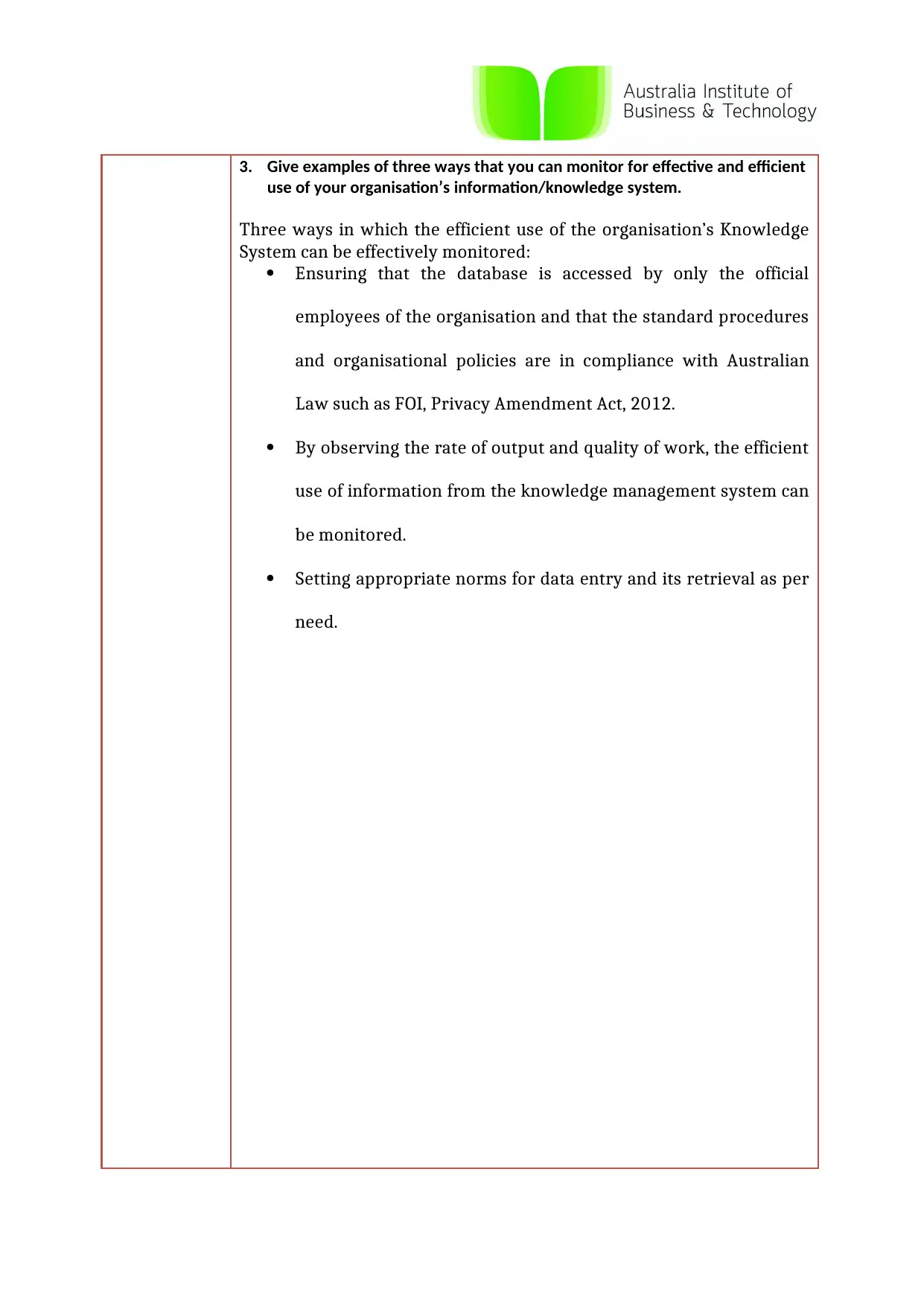
3. Give examples of three ways that you can monitor for effective and efficient
use of your organisation’s information/knowledge system.
Three ways in which the efficient use of the organisation’s Knowledge
System can be effectively monitored:
Ensuring that the database is accessed by only the official
employees of the organisation and that the standard procedures
and organisational policies are in compliance with Australian
Law such as FOI, Privacy Amendment Act, 2012.
By observing the rate of output and quality of work, the efficient
use of information from the knowledge management system can
be monitored.
Setting appropriate norms for data entry and its retrieval as per
need.
use of your organisation’s information/knowledge system.
Three ways in which the efficient use of the organisation’s Knowledge
System can be effectively monitored:
Ensuring that the database is accessed by only the official
employees of the organisation and that the standard procedures
and organisational policies are in compliance with Australian
Law such as FOI, Privacy Amendment Act, 2012.
By observing the rate of output and quality of work, the efficient
use of information from the knowledge management system can
be monitored.
Setting appropriate norms for data entry and its retrieval as per
need.
Secure Best Marks with AI Grader
Need help grading? Try our AI Grader for instant feedback on your assignments.
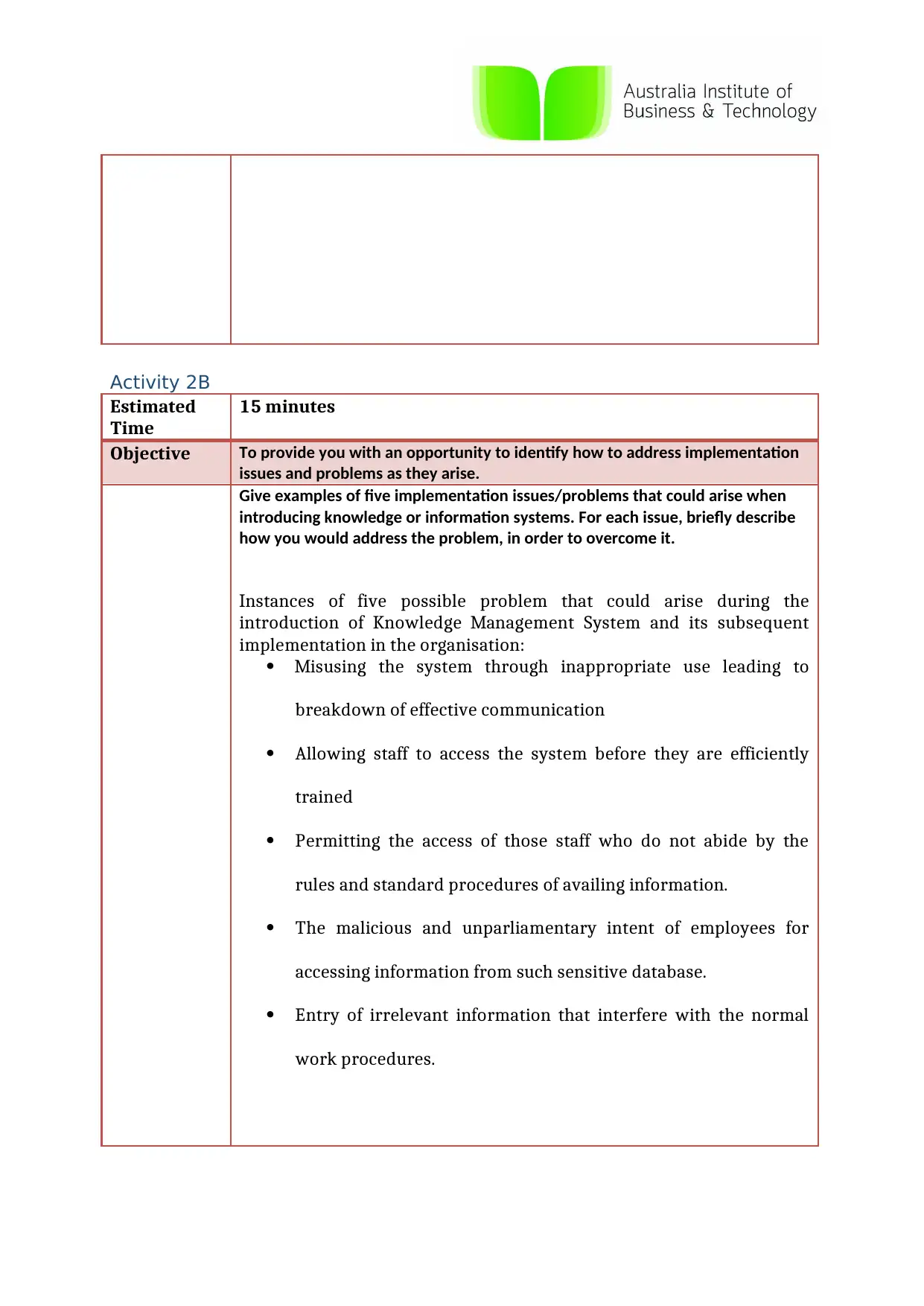
Activity 2B
Estimated
Time
15 minutes
Objective To provide you with an opportunity to identify how to address implementation
issues and problems as they arise.
Give examples of five implementation issues/problems that could arise when
introducing knowledge or information systems. For each issue, briefly describe
how you would address the problem, in order to overcome it.
Instances of five possible problem that could arise during the
introduction of Knowledge Management System and its subsequent
implementation in the organisation:
Misusing the system through inappropriate use leading to
breakdown of effective communication
Allowing staff to access the system before they are efficiently
trained
Permitting the access of those staff who do not abide by the
rules and standard procedures of availing information.
The malicious and unparliamentary intent of employees for
accessing information from such sensitive database.
Entry of irrelevant information that interfere with the normal
work procedures.
Estimated
Time
15 minutes
Objective To provide you with an opportunity to identify how to address implementation
issues and problems as they arise.
Give examples of five implementation issues/problems that could arise when
introducing knowledge or information systems. For each issue, briefly describe
how you would address the problem, in order to overcome it.
Instances of five possible problem that could arise during the
introduction of Knowledge Management System and its subsequent
implementation in the organisation:
Misusing the system through inappropriate use leading to
breakdown of effective communication
Allowing staff to access the system before they are efficiently
trained
Permitting the access of those staff who do not abide by the
rules and standard procedures of availing information.
The malicious and unparliamentary intent of employees for
accessing information from such sensitive database.
Entry of irrelevant information that interfere with the normal
work procedures.

Activity 2C
Estimated
Time
15 minutes
Objective To provide you with an opportunity to identify how to monitor integration and
alignment with data and information systems.
1. Give examples of three ways that you can monitor the integration of a
data/information system.
Three specific ways in which the integration of data in the information
management system can be effectively monitored:
In order to overcome a particular problem it is necessary to
assess the issue.
Determining the employees who could be responsible for
deviating from the legal bindings.
Accumulating sufficient evidence against the miscreant and
deciding on a proper actions against him or her.
2. Give examples of three ways that you can monitor whether a new
information/knowledge system aligns with your organisation and its goals.
Three distinct ways in which it can be monitored that information that
is put into the knowledge management system aligns with the
Organisational goals:
By observing employee performance after implementation of
training based on knowledge management system and finding
out where they are facing relevant issues.
Holding periodic conventions and meetings to discuss the
progress of production and ways in which it could be enhanced.
Congregation by senior stuff to recognise the contribution of the
junior members to the overall organisational goals.
Estimated
Time
15 minutes
Objective To provide you with an opportunity to identify how to monitor integration and
alignment with data and information systems.
1. Give examples of three ways that you can monitor the integration of a
data/information system.
Three specific ways in which the integration of data in the information
management system can be effectively monitored:
In order to overcome a particular problem it is necessary to
assess the issue.
Determining the employees who could be responsible for
deviating from the legal bindings.
Accumulating sufficient evidence against the miscreant and
deciding on a proper actions against him or her.
2. Give examples of three ways that you can monitor whether a new
information/knowledge system aligns with your organisation and its goals.
Three distinct ways in which it can be monitored that information that
is put into the knowledge management system aligns with the
Organisational goals:
By observing employee performance after implementation of
training based on knowledge management system and finding
out where they are facing relevant issues.
Holding periodic conventions and meetings to discuss the
progress of production and ways in which it could be enhanced.
Congregation by senior stuff to recognise the contribution of the
junior members to the overall organisational goals.
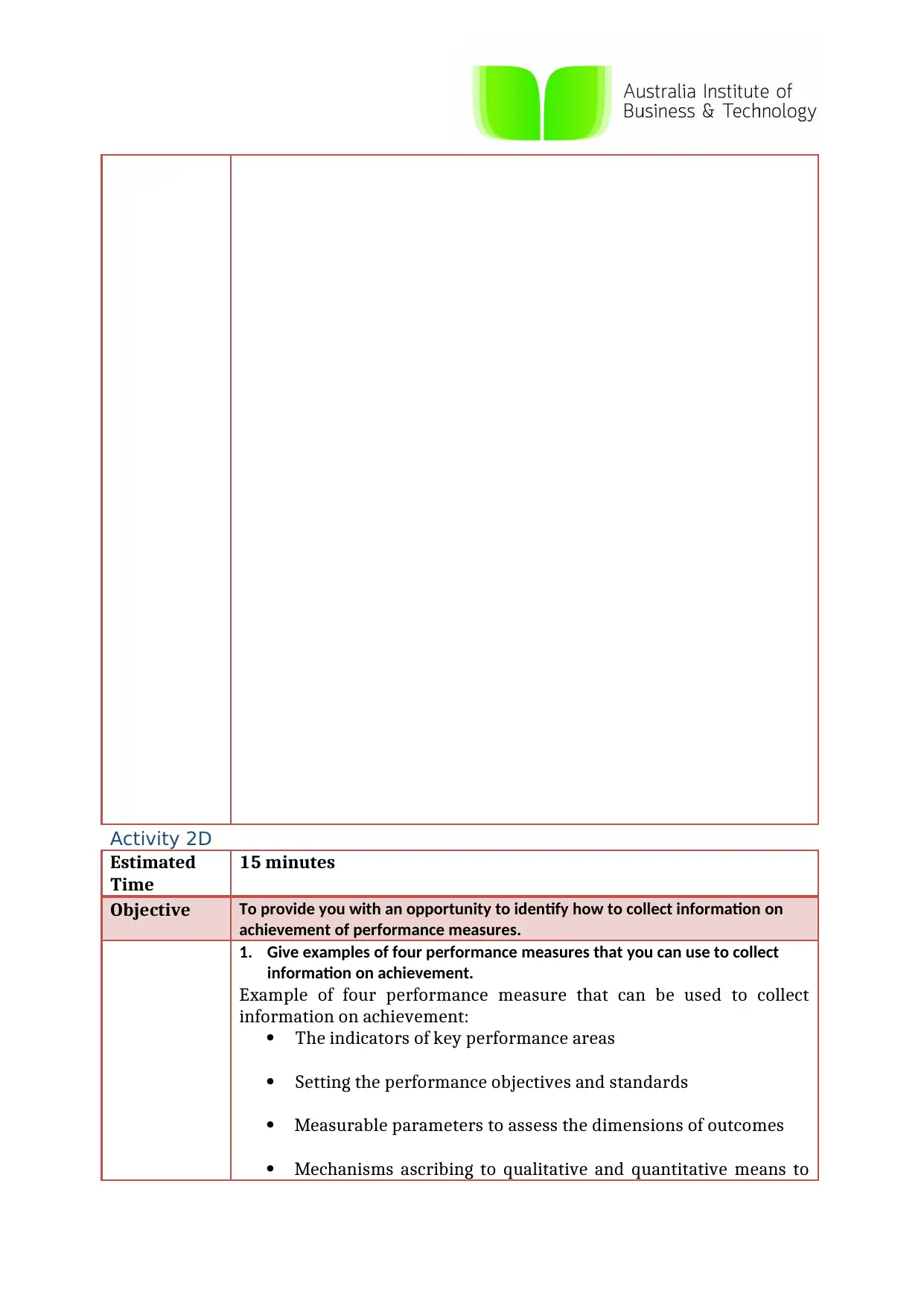
Activity 2D
Estimated
Time
15 minutes
Objective To provide you with an opportunity to identify how to collect information on
achievement of performance measures.
1. Give examples of four performance measures that you can use to collect
information on achievement.
Example of four performance measure that can be used to collect
information on achievement:
The indicators of key performance areas
Setting the performance objectives and standards
Measurable parameters to assess the dimensions of outcomes
Mechanisms ascribing to qualitative and quantitative means to
Estimated
Time
15 minutes
Objective To provide you with an opportunity to identify how to collect information on
achievement of performance measures.
1. Give examples of four performance measures that you can use to collect
information on achievement.
Example of four performance measure that can be used to collect
information on achievement:
The indicators of key performance areas
Setting the performance objectives and standards
Measurable parameters to assess the dimensions of outcomes
Mechanisms ascribing to qualitative and quantitative means to
Paraphrase This Document
Need a fresh take? Get an instant paraphrase of this document with our AI Paraphraser
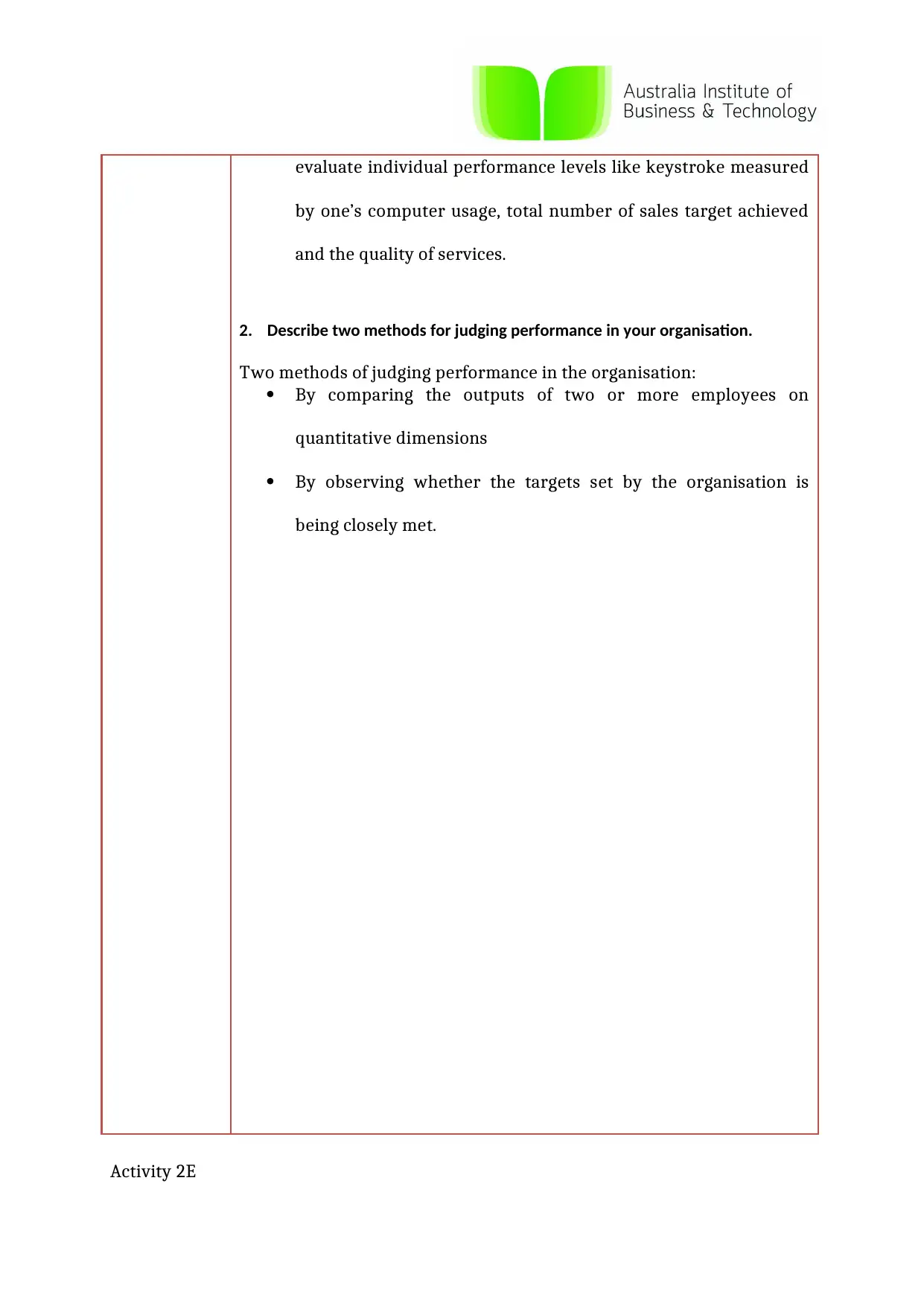
evaluate individual performance levels like keystroke measured
by one’s computer usage, total number of sales target achieved
and the quality of services.
2. Describe two methods for judging performance in your organisation.
Two methods of judging performance in the organisation:
By comparing the outputs of two or more employees on
quantitative dimensions
By observing whether the targets set by the organisation is
being closely met.
Activity 2E
by one’s computer usage, total number of sales target achieved
and the quality of services.
2. Describe two methods for judging performance in your organisation.
Two methods of judging performance in the organisation:
By comparing the outputs of two or more employees on
quantitative dimensions
By observing whether the targets set by the organisation is
being closely met.
Activity 2E

Estimated
Time
15 minutes
Objective To provide you with an opportunity to identify how to manage contingencies
such as system failure or technical difficulties by accessing technical specialist
help as required.
1. Give examples of five contingency strategies that you can use in the event of
system failure or technical difficulties.
Five contingency strategies to use in times of system failure:
Going back to the traditional pen and paper documentation
strategy
Limiting the access in the affected version of database
Making use of intrinsic competencies and insight to solve an
issue
Conveying the reason for slow operation to the suppliers and
stakeholders
Using an alternate information management system.
2. Give three examples of steps that a technical specialist will be able to take
to help deal with a system failure or technical difficulties.
System failures such as server issues or corruption of software or
hardware malfunctions are usually taken up by system specialist who
offer a range of solutions. Three such solutions include:
Taking immediate step to minimise the damage that has already
occurred so as to reduce its likelihood to affect to non-affected
regions.
Enable the saved data from an alternative source
Inform the management regarding how to prevent such
unwanted recurrences.
Time
15 minutes
Objective To provide you with an opportunity to identify how to manage contingencies
such as system failure or technical difficulties by accessing technical specialist
help as required.
1. Give examples of five contingency strategies that you can use in the event of
system failure or technical difficulties.
Five contingency strategies to use in times of system failure:
Going back to the traditional pen and paper documentation
strategy
Limiting the access in the affected version of database
Making use of intrinsic competencies and insight to solve an
issue
Conveying the reason for slow operation to the suppliers and
stakeholders
Using an alternate information management system.
2. Give three examples of steps that a technical specialist will be able to take
to help deal with a system failure or technical difficulties.
System failures such as server issues or corruption of software or
hardware malfunctions are usually taken up by system specialist who
offer a range of solutions. Three such solutions include:
Taking immediate step to minimise the damage that has already
occurred so as to reduce its likelihood to affect to non-affected
regions.
Enable the saved data from an alternative source
Inform the management regarding how to prevent such
unwanted recurrences.
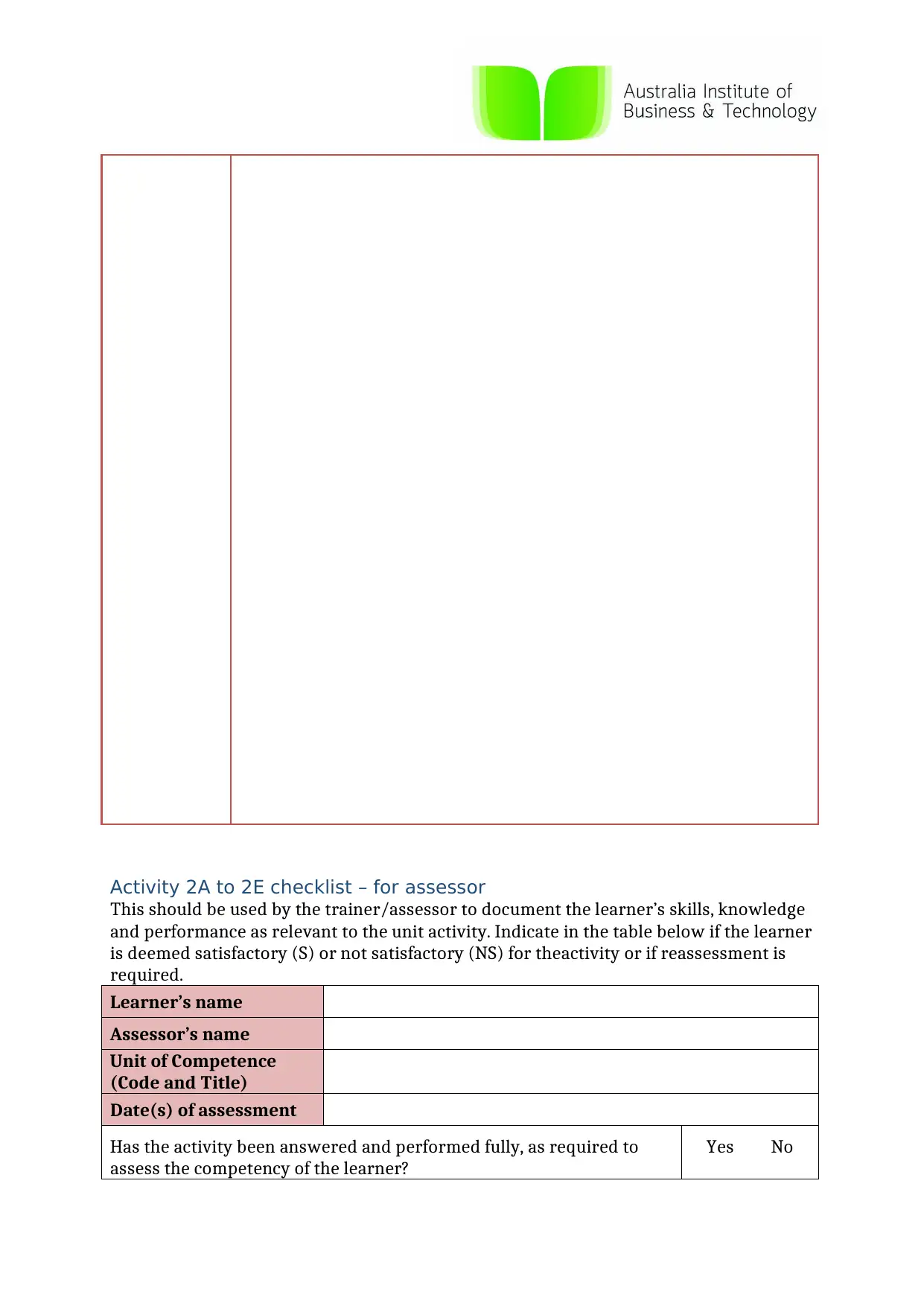
Activity 2A to 2E checklist – for assessor
This should be used by the trainer/assessor to document the learner’s skills, knowledge
and performance as relevant to the unit activity. Indicate in the table below if the learner
is deemed satisfactory (S) or not satisfactory (NS) for theactivity or if reassessment is
required.
Learner’s name
Assessor’s name
Unit of Competence
(Code and Title)
Date(s) of assessment
Has the activity been answered and performed fully, as required to
assess the competency of the learner?
Yes No
This should be used by the trainer/assessor to document the learner’s skills, knowledge
and performance as relevant to the unit activity. Indicate in the table below if the learner
is deemed satisfactory (S) or not satisfactory (NS) for theactivity or if reassessment is
required.
Learner’s name
Assessor’s name
Unit of Competence
(Code and Title)
Date(s) of assessment
Has the activity been answered and performed fully, as required to
assess the competency of the learner?
Yes No
Secure Best Marks with AI Grader
Need help grading? Try our AI Grader for instant feedback on your assignments.
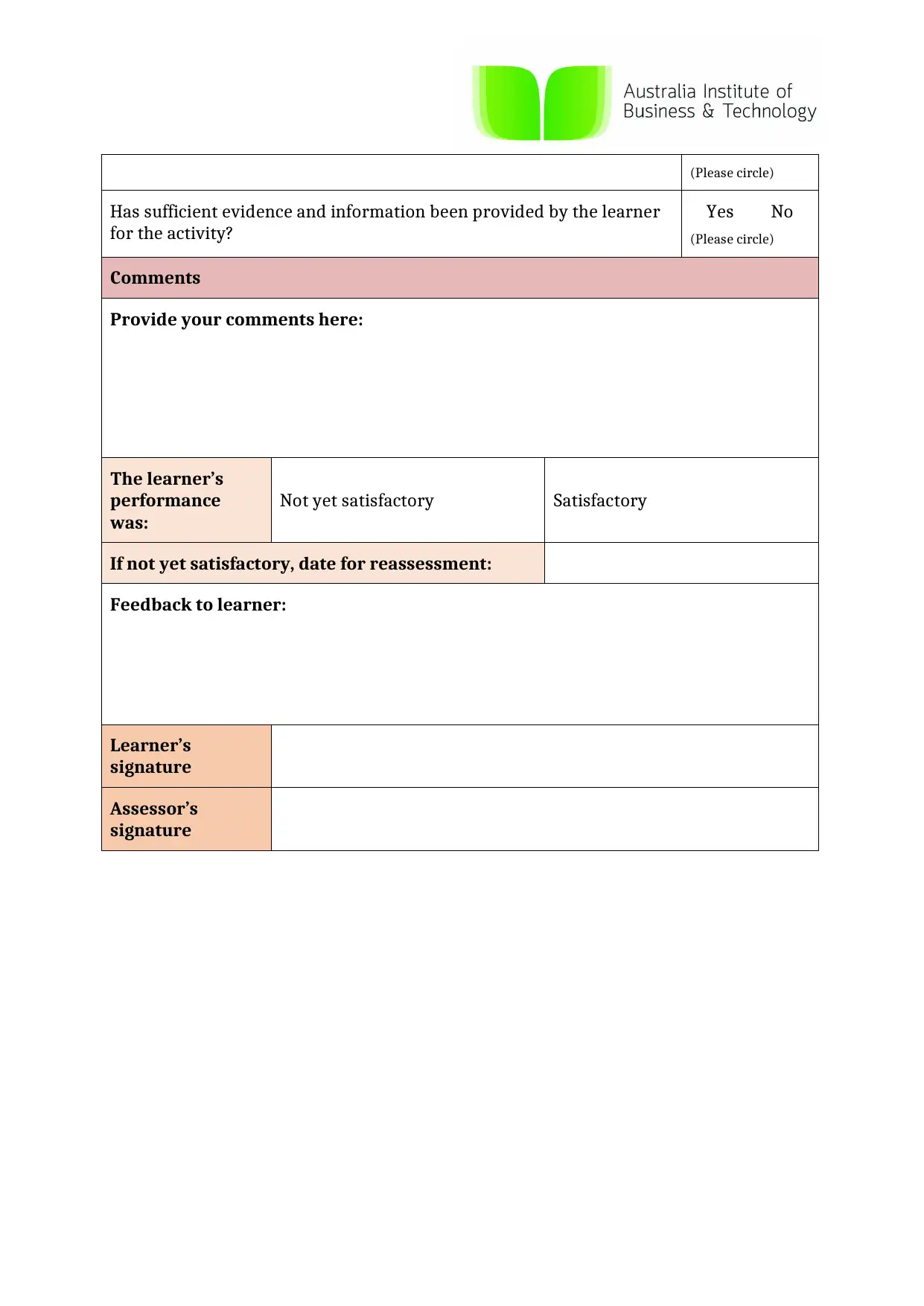
(Please circle)
Has sufficient evidence and information been provided by the learner
for the activity?
Yes No
(Please circle)
Comments
Provide your comments here:
The learner’s
performance
was:
Not yet satisfactory Satisfactory
If not yet satisfactory, date for reassessment:
Feedback to learner:
Learner’s
signature
Assessor’s
signature
Has sufficient evidence and information been provided by the learner
for the activity?
Yes No
(Please circle)
Comments
Provide your comments here:
The learner’s
performance
was:
Not yet satisfactory Satisfactory
If not yet satisfactory, date for reassessment:
Feedback to learner:
Learner’s
signature
Assessor’s
signature

Activity 3A
Estimated
Time
15 minutes
Objective To provide you with an opportunity to identify how to analyse effectiveness of
system and report on strengths and limitations of the system.
1. List five ways that you can analyse the effectiveness of your
information/knowledge system in your organisation.
Five ways to recognise the effectiveness of Information
Management System relevant to an organisational setting:
It can be achieved by primarily communicating the individuals
who are directly associated with the operation and handling of
the system.
Assembling feedback from the relevant resources.
Monitoring the efficiency and compliance of the system with
organisational goals.
Proactively addressing issues of the system whenever it arises.
Learning about ways to solve those issues.
2. Give examples of three methods of reporting on the strengths and
weaknesses of your organisation’s knowledge/information system.
Three methods in which the strengths and weaknesses of an
organisation’s information management system can be reported:
The various strengths and weaknesses can be reviewed using
relevant presentations
Discussing with senior members and stakeholders
By preparing weekly or monthly reports
Estimated
Time
15 minutes
Objective To provide you with an opportunity to identify how to analyse effectiveness of
system and report on strengths and limitations of the system.
1. List five ways that you can analyse the effectiveness of your
information/knowledge system in your organisation.
Five ways to recognise the effectiveness of Information
Management System relevant to an organisational setting:
It can be achieved by primarily communicating the individuals
who are directly associated with the operation and handling of
the system.
Assembling feedback from the relevant resources.
Monitoring the efficiency and compliance of the system with
organisational goals.
Proactively addressing issues of the system whenever it arises.
Learning about ways to solve those issues.
2. Give examples of three methods of reporting on the strengths and
weaknesses of your organisation’s knowledge/information system.
Three methods in which the strengths and weaknesses of an
organisation’s information management system can be reported:
The various strengths and weaknesses can be reviewed using
relevant presentations
Discussing with senior members and stakeholders
By preparing weekly or monthly reports
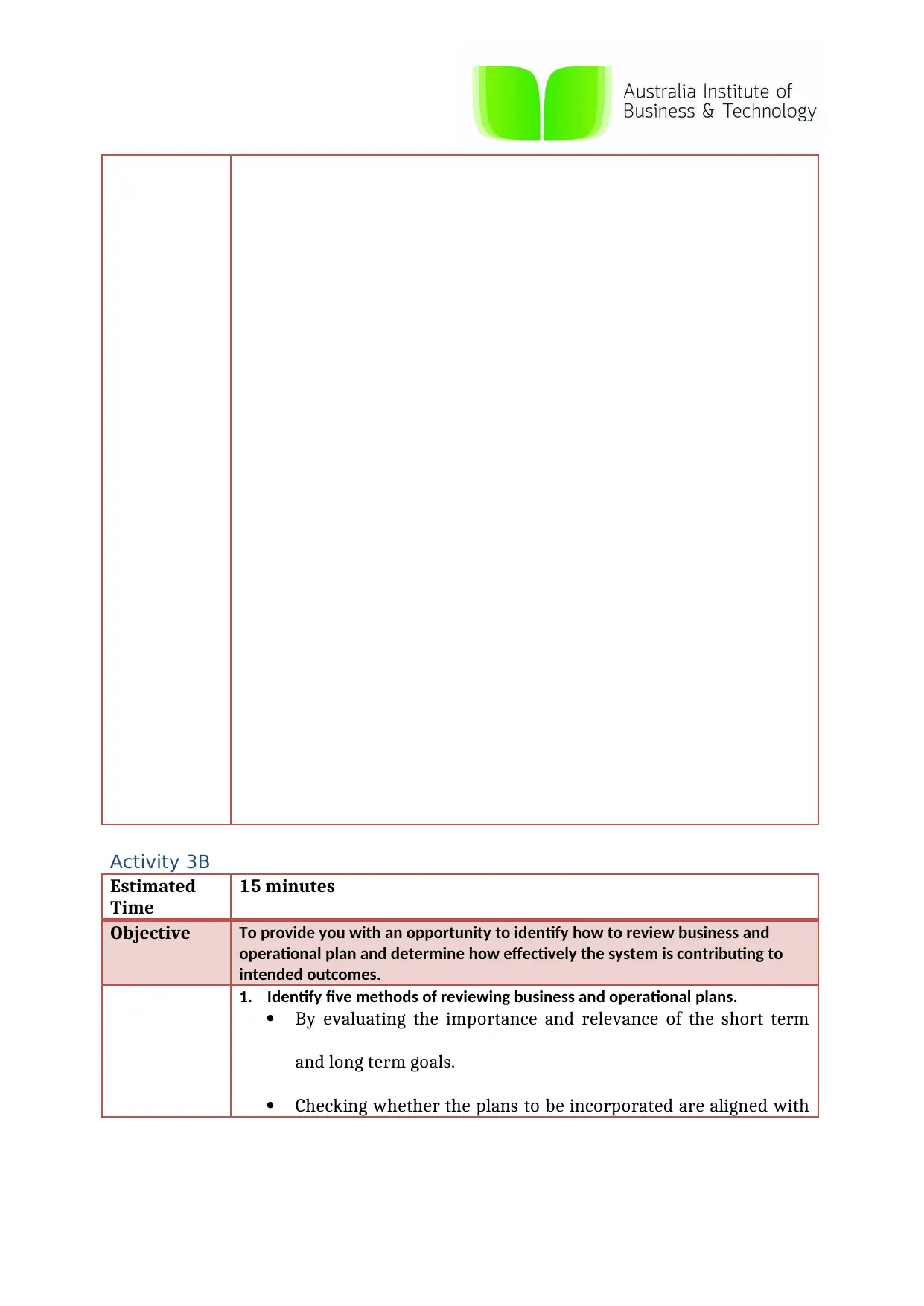
Activity 3B
Estimated
Time
15 minutes
Objective To provide you with an opportunity to identify how to review business and
operational plan and determine how effectively the system is contributing to
intended outcomes.
1. Identify five methods of reviewing business and operational plans.
By evaluating the importance and relevance of the short term
and long term goals.
Checking whether the plans to be incorporated are aligned with
Estimated
Time
15 minutes
Objective To provide you with an opportunity to identify how to review business and
operational plan and determine how effectively the system is contributing to
intended outcomes.
1. Identify five methods of reviewing business and operational plans.
By evaluating the importance and relevance of the short term
and long term goals.
Checking whether the plans to be incorporated are aligned with
Paraphrase This Document
Need a fresh take? Get an instant paraphrase of this document with our AI Paraphraser

the organisational policies, goals, culture and beliefs.
Reviewing the legal compliances corresponding to the
organisational standards.
Conducting comparative analysis on the implementation of
strategic changes.
Reviewing the company’s financial trends and current financial
situation.
2. Identify five measures or signs that indicate that the
knowledge/information system is contributing to intended outcomes in
your organisation.
Five measures that indicate that knowledge system is contributing to
the intended outcome of the organisation:
If the knowledge management system has information aiding in
achievement of the short term and long term goals.
If it is enhancing the speed of overall operations.
It is complying with the organisation’s ethical standards.
If all the employees are being able to use it appropriately.
If it makes the job easier for the employees.
Reviewing the legal compliances corresponding to the
organisational standards.
Conducting comparative analysis on the implementation of
strategic changes.
Reviewing the company’s financial trends and current financial
situation.
2. Identify five measures or signs that indicate that the
knowledge/information system is contributing to intended outcomes in
your organisation.
Five measures that indicate that knowledge system is contributing to
the intended outcome of the organisation:
If the knowledge management system has information aiding in
achievement of the short term and long term goals.
If it is enhancing the speed of overall operations.
It is complying with the organisation’s ethical standards.
If all the employees are being able to use it appropriately.
If it makes the job easier for the employees.

Activity 3C
Estimated
Time
15 minutes
Objective To provide you with an opportunity to identify how to make recommendations
for improvement to system, policy or work practices.
Give examples of five suggestions/recommendations you could make to
improve your organisation’s current system, policies, or work practices.
Five recommendations to improve an organisation’s system, policies
and practices:
Organisation’s employees are appropriately mentored in their
relevant domains
Access to information management system needs to be
restricted or made available depending on the need of the
employees
Methods of information storage need to be more secure and free
from frequent malfunction
Methods of information retrieval as well as entry need to be
maintained
The overall policy for security integration needs to be monitored
appropriately.
Estimated
Time
15 minutes
Objective To provide you with an opportunity to identify how to make recommendations
for improvement to system, policy or work practices.
Give examples of five suggestions/recommendations you could make to
improve your organisation’s current system, policies, or work practices.
Five recommendations to improve an organisation’s system, policies
and practices:
Organisation’s employees are appropriately mentored in their
relevant domains
Access to information management system needs to be
restricted or made available depending on the need of the
employees
Methods of information storage need to be more secure and free
from frequent malfunction
Methods of information retrieval as well as entry need to be
maintained
The overall policy for security integration needs to be monitored
appropriately.
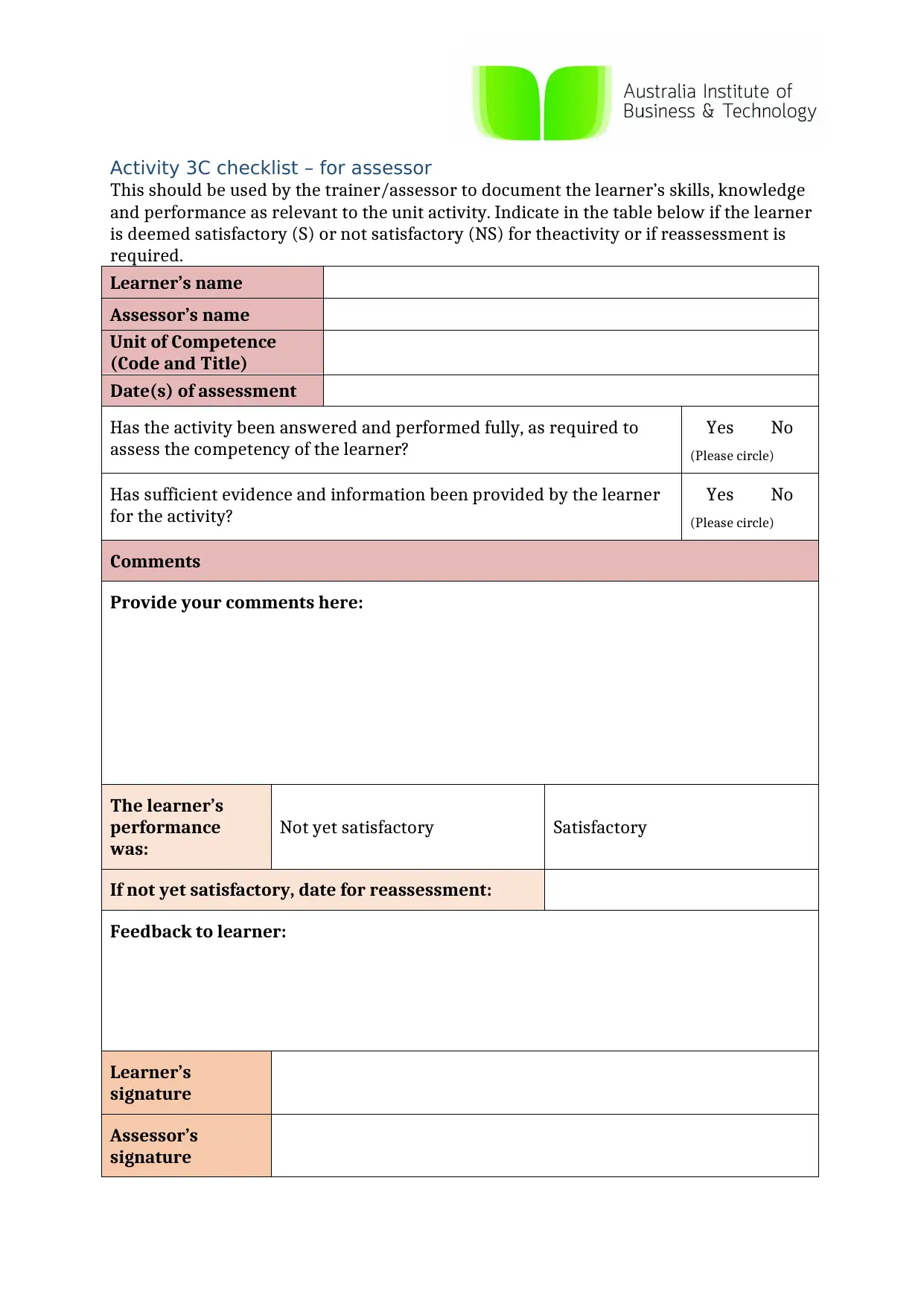
Activity 3C checklist – for assessor
This should be used by the trainer/assessor to document the learner’s skills, knowledge
and performance as relevant to the unit activity. Indicate in the table below if the learner
is deemed satisfactory (S) or not satisfactory (NS) for theactivity or if reassessment is
required.
Learner’s name
Assessor’s name
Unit of Competence
(Code and Title)
Date(s) of assessment
Has the activity been answered and performed fully, as required to
assess the competency of the learner?
Yes No
(Please circle)
Has sufficient evidence and information been provided by the learner
for the activity?
Yes No
(Please circle)
Comments
Provide your comments here:
The learner’s
performance
was:
Not yet satisfactory Satisfactory
If not yet satisfactory, date for reassessment:
Feedback to learner:
Learner’s
signature
Assessor’s
signature
This should be used by the trainer/assessor to document the learner’s skills, knowledge
and performance as relevant to the unit activity. Indicate in the table below if the learner
is deemed satisfactory (S) or not satisfactory (NS) for theactivity or if reassessment is
required.
Learner’s name
Assessor’s name
Unit of Competence
(Code and Title)
Date(s) of assessment
Has the activity been answered and performed fully, as required to
assess the competency of the learner?
Yes No
(Please circle)
Has sufficient evidence and information been provided by the learner
for the activity?
Yes No
(Please circle)
Comments
Provide your comments here:
The learner’s
performance
was:
Not yet satisfactory Satisfactory
If not yet satisfactory, date for reassessment:
Feedback to learner:
Learner’s
signature
Assessor’s
signature
Secure Best Marks with AI Grader
Need help grading? Try our AI Grader for instant feedback on your assignments.
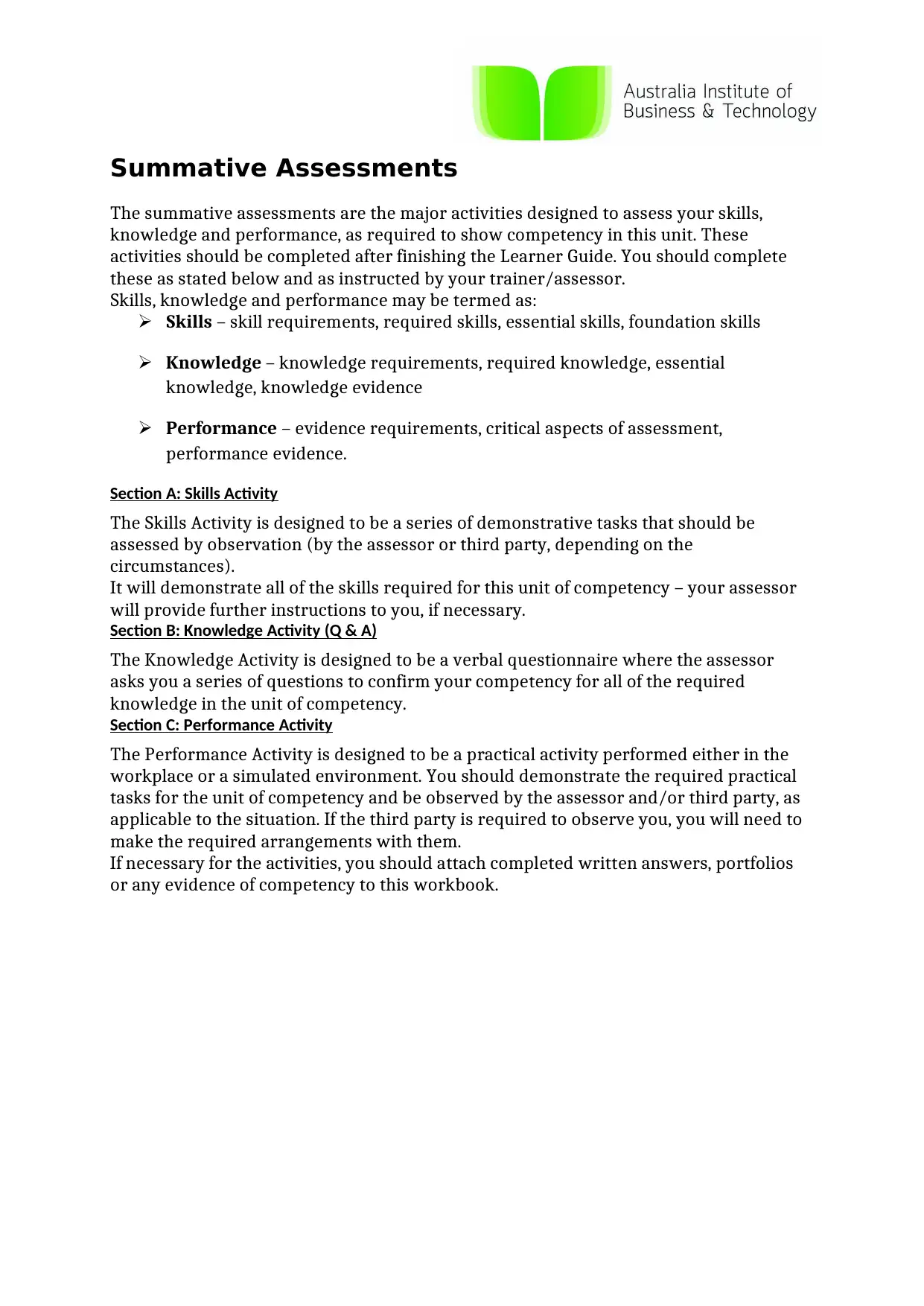
Summative Assessments
The summative assessments are the major activities designed to assess your skills,
knowledge and performance, as required to show competency in this unit. These
activities should be completed after finishing the Learner Guide. You should complete
these as stated below and as instructed by your trainer/assessor.
Skills, knowledge and performance may be termed as:
Skills – skill requirements, required skills, essential skills, foundation skills
Knowledge – knowledge requirements, required knowledge, essential
knowledge, knowledge evidence
Performance – evidence requirements, critical aspects of assessment,
performance evidence.
Section A: Skills Activity
The Skills Activity is designed to be a series of demonstrative tasks that should be
assessed by observation (by the assessor or third party, depending on the
circumstances).
It will demonstrate all of the skills required for this unit of competency – your assessor
will provide further instructions to you, if necessary.
Section B: Knowledge Activity (Q & A)
The Knowledge Activity is designed to be a verbal questionnaire where the assessor
asks you a series of questions to confirm your competency for all of the required
knowledge in the unit of competency.
Section C: Performance Activity
The Performance Activity is designed to be a practical activity performed either in the
workplace or a simulated environment. You should demonstrate the required practical
tasks for the unit of competency and be observed by the assessor and/or third party, as
applicable to the situation. If the third party is required to observe you, you will need to
make the required arrangements with them.
If necessary for the activities, you should attach completed written answers, portfolios
or any evidence of competency to this workbook.
The summative assessments are the major activities designed to assess your skills,
knowledge and performance, as required to show competency in this unit. These
activities should be completed after finishing the Learner Guide. You should complete
these as stated below and as instructed by your trainer/assessor.
Skills, knowledge and performance may be termed as:
Skills – skill requirements, required skills, essential skills, foundation skills
Knowledge – knowledge requirements, required knowledge, essential
knowledge, knowledge evidence
Performance – evidence requirements, critical aspects of assessment,
performance evidence.
Section A: Skills Activity
The Skills Activity is designed to be a series of demonstrative tasks that should be
assessed by observation (by the assessor or third party, depending on the
circumstances).
It will demonstrate all of the skills required for this unit of competency – your assessor
will provide further instructions to you, if necessary.
Section B: Knowledge Activity (Q & A)
The Knowledge Activity is designed to be a verbal questionnaire where the assessor
asks you a series of questions to confirm your competency for all of the required
knowledge in the unit of competency.
Section C: Performance Activity
The Performance Activity is designed to be a practical activity performed either in the
workplace or a simulated environment. You should demonstrate the required practical
tasks for the unit of competency and be observed by the assessor and/or third party, as
applicable to the situation. If the third party is required to observe you, you will need to
make the required arrangements with them.
If necessary for the activities, you should attach completed written answers, portfolios
or any evidence of competency to this workbook.
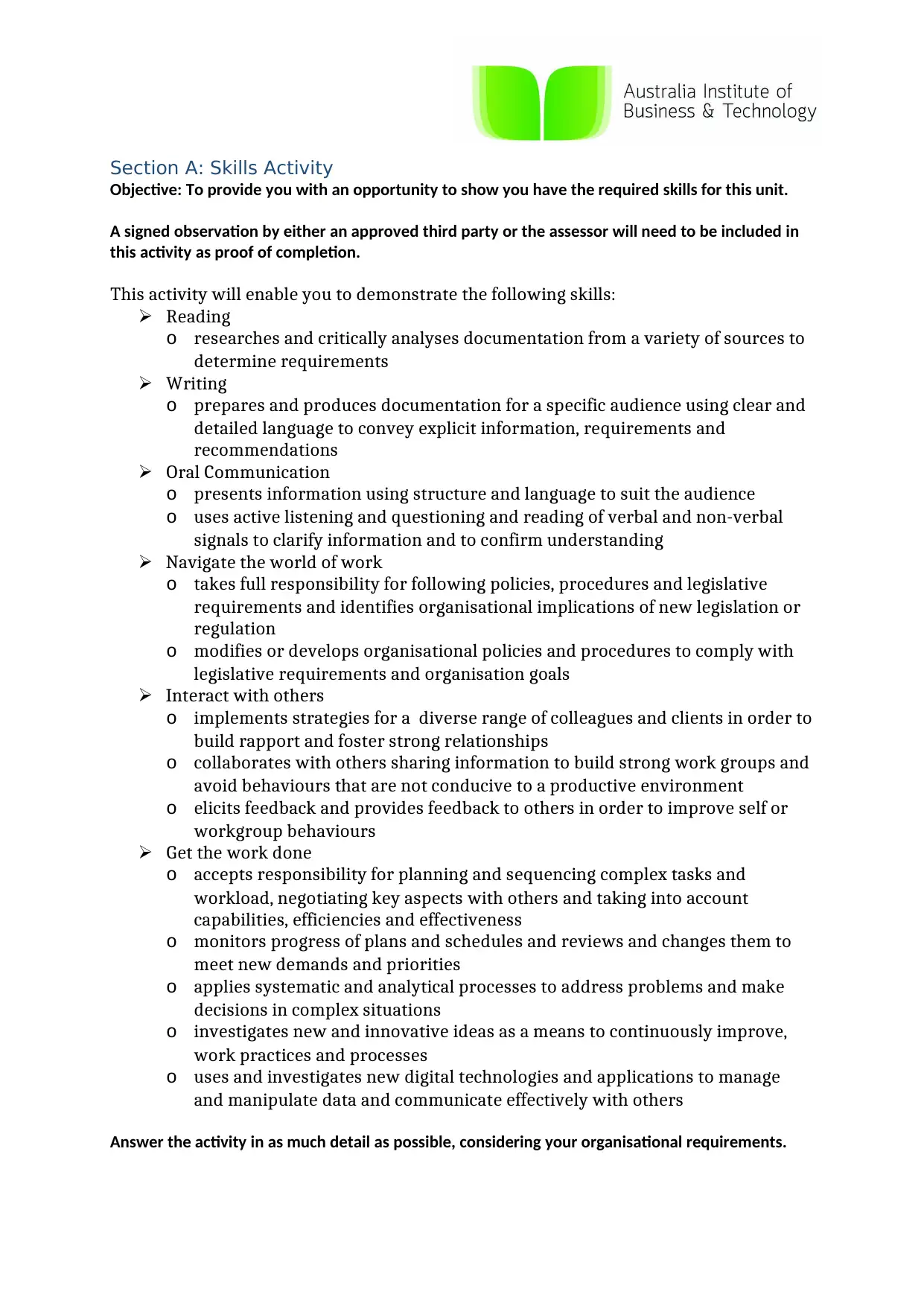
Section A: Skills Activity
Objective: To provide you with an opportunity to show you have the required skills for this unit.
A signed observation by either an approved third party or the assessor will need to be included in
this activity as proof of completion.
This activity will enable you to demonstrate the following skills:
Reading
o researches and critically analyses documentation from a variety of sources to
determine requirements
Writing
o prepares and produces documentation for a specific audience using clear and
detailed language to convey explicit information, requirements and
recommendations
Oral Communication
o presents information using structure and language to suit the audience
o uses active listening and questioning and reading of verbal and non-verbal
signals to clarify information and to confirm understanding
Navigate the world of work
o takes full responsibility for following policies, procedures and legislative
requirements and identifies organisational implications of new legislation or
regulation
o modifies or develops organisational policies and procedures to comply with
legislative requirements and organisation goals
Interact with others
o implements strategies for a diverse range of colleagues and clients in order to
build rapport and foster strong relationships
o collaborates with others sharing information to build strong work groups and
avoid behaviours that are not conducive to a productive environment
o elicits feedback and provides feedback to others in order to improve self or
workgroup behaviours
Get the work done
o accepts responsibility for planning and sequencing complex tasks and
workload, negotiating key aspects with others and taking into account
capabilities, efficiencies and effectiveness
o monitors progress of plans and schedules and reviews and changes them to
meet new demands and priorities
o applies systematic and analytical processes to address problems and make
decisions in complex situations
o investigates new and innovative ideas as a means to continuously improve,
work practices and processes
o uses and investigates new digital technologies and applications to manage
and manipulate data and communicate effectively with others
Answer the activity in as much detail as possible, considering your organisational requirements.
Objective: To provide you with an opportunity to show you have the required skills for this unit.
A signed observation by either an approved third party or the assessor will need to be included in
this activity as proof of completion.
This activity will enable you to demonstrate the following skills:
Reading
o researches and critically analyses documentation from a variety of sources to
determine requirements
Writing
o prepares and produces documentation for a specific audience using clear and
detailed language to convey explicit information, requirements and
recommendations
Oral Communication
o presents information using structure and language to suit the audience
o uses active listening and questioning and reading of verbal and non-verbal
signals to clarify information and to confirm understanding
Navigate the world of work
o takes full responsibility for following policies, procedures and legislative
requirements and identifies organisational implications of new legislation or
regulation
o modifies or develops organisational policies and procedures to comply with
legislative requirements and organisation goals
Interact with others
o implements strategies for a diverse range of colleagues and clients in order to
build rapport and foster strong relationships
o collaborates with others sharing information to build strong work groups and
avoid behaviours that are not conducive to a productive environment
o elicits feedback and provides feedback to others in order to improve self or
workgroup behaviours
Get the work done
o accepts responsibility for planning and sequencing complex tasks and
workload, negotiating key aspects with others and taking into account
capabilities, efficiencies and effectiveness
o monitors progress of plans and schedules and reviews and changes them to
meet new demands and priorities
o applies systematic and analytical processes to address problems and make
decisions in complex situations
o investigates new and innovative ideas as a means to continuously improve,
work practices and processes
o uses and investigates new digital technologies and applications to manage
and manipulate data and communicate effectively with others
Answer the activity in as much detail as possible, considering your organisational requirements.
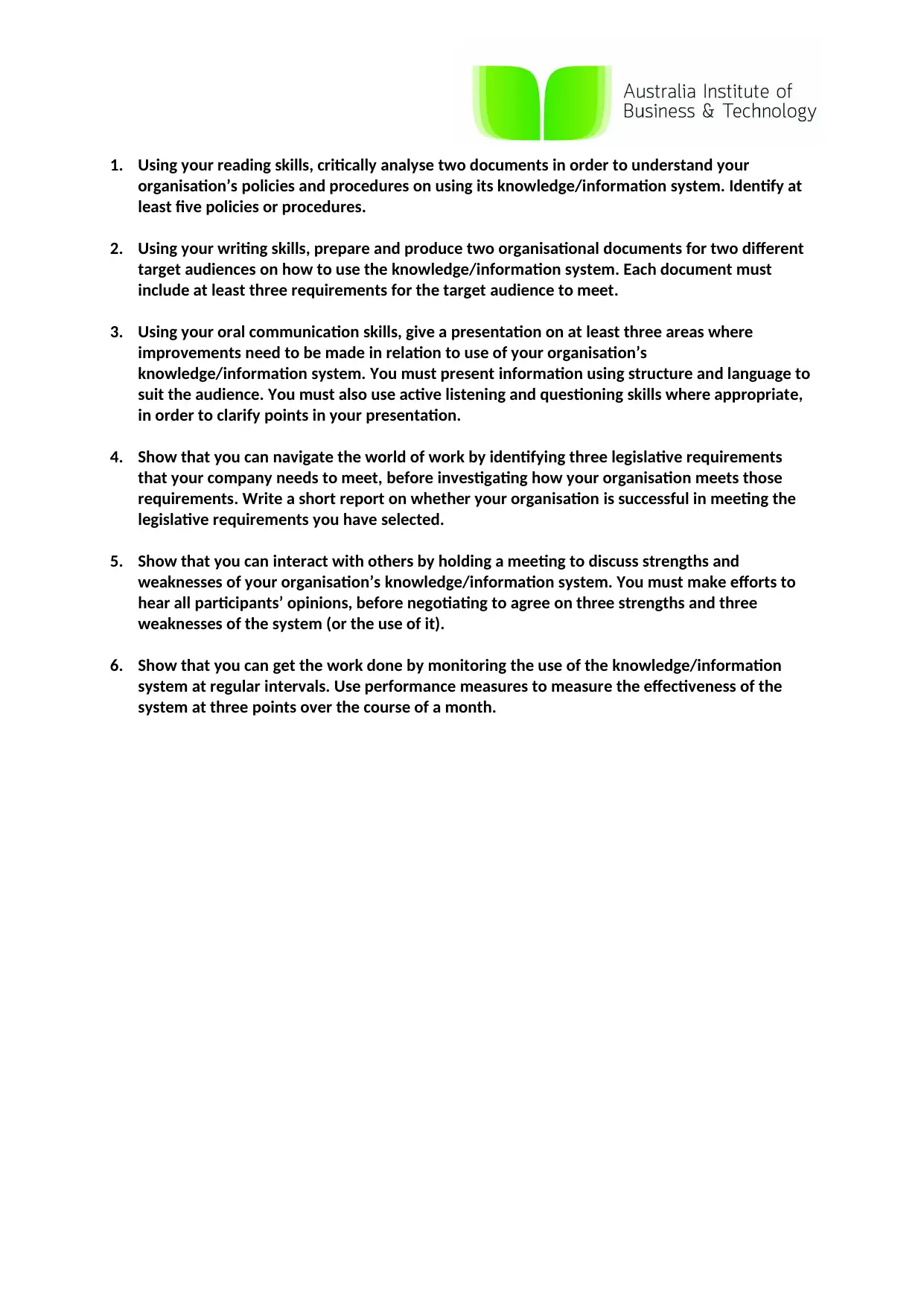
1. Using your reading skills, critically analyse two documents in order to understand your
organisation’s policies and procedures on using its knowledge/information system. Identify at
least five policies or procedures.
2. Using your writing skills, prepare and produce two organisational documents for two different
target audiences on how to use the knowledge/information system. Each document must
include at least three requirements for the target audience to meet.
3. Using your oral communication skills, give a presentation on at least three areas where
improvements need to be made in relation to use of your organisation’s
knowledge/information system. You must present information using structure and language to
suit the audience. You must also use active listening and questioning skills where appropriate,
in order to clarify points in your presentation.
4. Show that you can navigate the world of work by identifying three legislative requirements
that your company needs to meet, before investigating how your organisation meets those
requirements. Write a short report on whether your organisation is successful in meeting the
legislative requirements you have selected.
5. Show that you can interact with others by holding a meeting to discuss strengths and
weaknesses of your organisation’s knowledge/information system. You must make efforts to
hear all participants’ opinions, before negotiating to agree on three strengths and three
weaknesses of the system (or the use of it).
6. Show that you can get the work done by monitoring the use of the knowledge/information
system at regular intervals. Use performance measures to measure the effectiveness of the
system at three points over the course of a month.
organisation’s policies and procedures on using its knowledge/information system. Identify at
least five policies or procedures.
2. Using your writing skills, prepare and produce two organisational documents for two different
target audiences on how to use the knowledge/information system. Each document must
include at least three requirements for the target audience to meet.
3. Using your oral communication skills, give a presentation on at least three areas where
improvements need to be made in relation to use of your organisation’s
knowledge/information system. You must present information using structure and language to
suit the audience. You must also use active listening and questioning skills where appropriate,
in order to clarify points in your presentation.
4. Show that you can navigate the world of work by identifying three legislative requirements
that your company needs to meet, before investigating how your organisation meets those
requirements. Write a short report on whether your organisation is successful in meeting the
legislative requirements you have selected.
5. Show that you can interact with others by holding a meeting to discuss strengths and
weaknesses of your organisation’s knowledge/information system. You must make efforts to
hear all participants’ opinions, before negotiating to agree on three strengths and three
weaknesses of the system (or the use of it).
6. Show that you can get the work done by monitoring the use of the knowledge/information
system at regular intervals. Use performance measures to measure the effectiveness of the
system at three points over the course of a month.
Paraphrase This Document
Need a fresh take? Get an instant paraphrase of this document with our AI Paraphraser
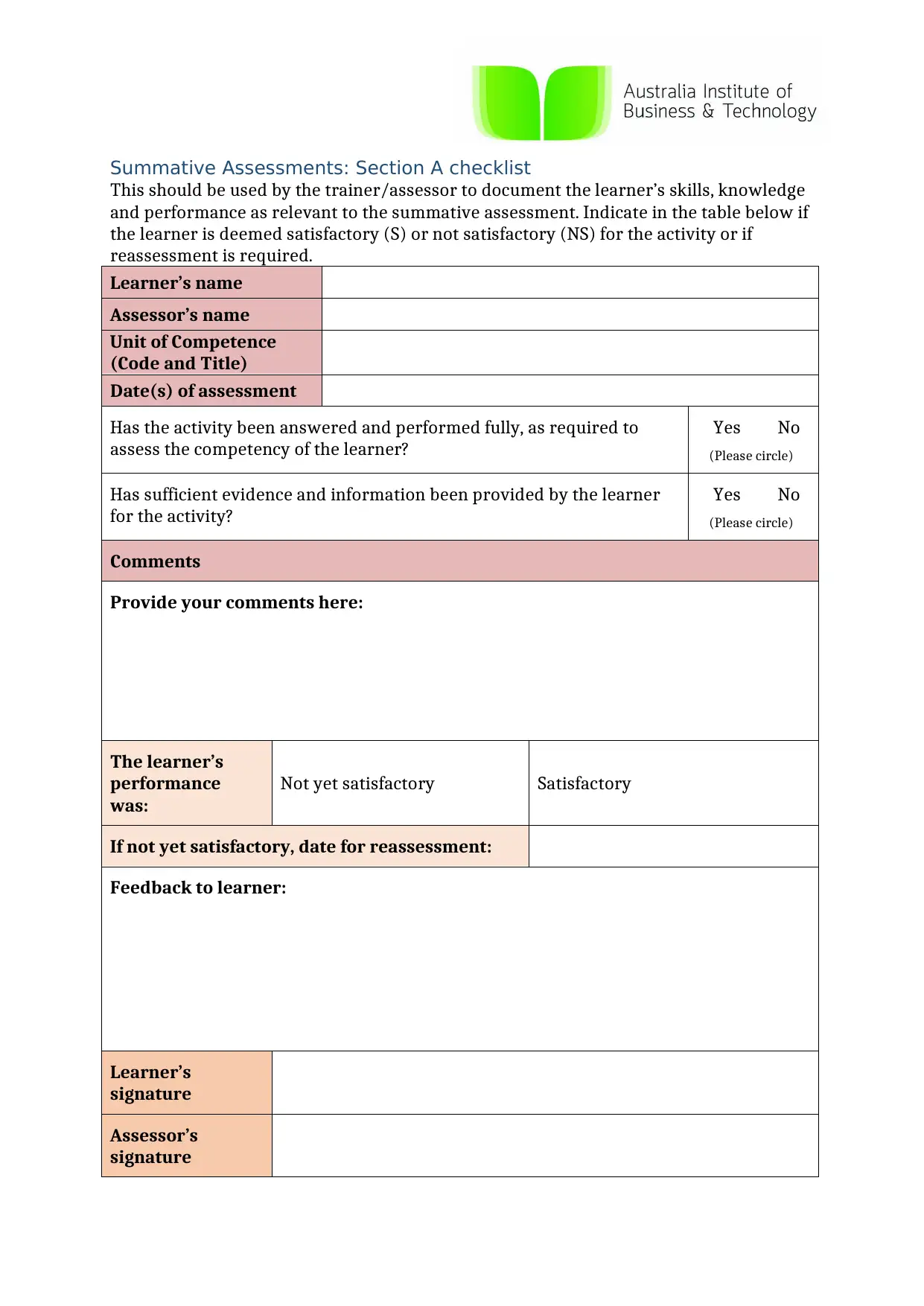
Summative Assessments: Section A checklist
This should be used by the trainer/assessor to document the learner’s skills, knowledge
and performance as relevant to the summative assessment. Indicate in the table below if
the learner is deemed satisfactory (S) or not satisfactory (NS) for the activity or if
reassessment is required.
Learner’s name
Assessor’s name
Unit of Competence
(Code and Title)
Date(s) of assessment
Has the activity been answered and performed fully, as required to
assess the competency of the learner?
Yes No
(Please circle)
Has sufficient evidence and information been provided by the learner
for the activity?
Yes No
(Please circle)
Comments
Provide your comments here:
The learner’s
performance
was:
Not yet satisfactory Satisfactory
If not yet satisfactory, date for reassessment:
Feedback to learner:
Learner’s
signature
Assessor’s
signature
This should be used by the trainer/assessor to document the learner’s skills, knowledge
and performance as relevant to the summative assessment. Indicate in the table below if
the learner is deemed satisfactory (S) or not satisfactory (NS) for the activity or if
reassessment is required.
Learner’s name
Assessor’s name
Unit of Competence
(Code and Title)
Date(s) of assessment
Has the activity been answered and performed fully, as required to
assess the competency of the learner?
Yes No
(Please circle)
Has sufficient evidence and information been provided by the learner
for the activity?
Yes No
(Please circle)
Comments
Provide your comments here:
The learner’s
performance
was:
Not yet satisfactory Satisfactory
If not yet satisfactory, date for reassessment:
Feedback to learner:
Learner’s
signature
Assessor’s
signature
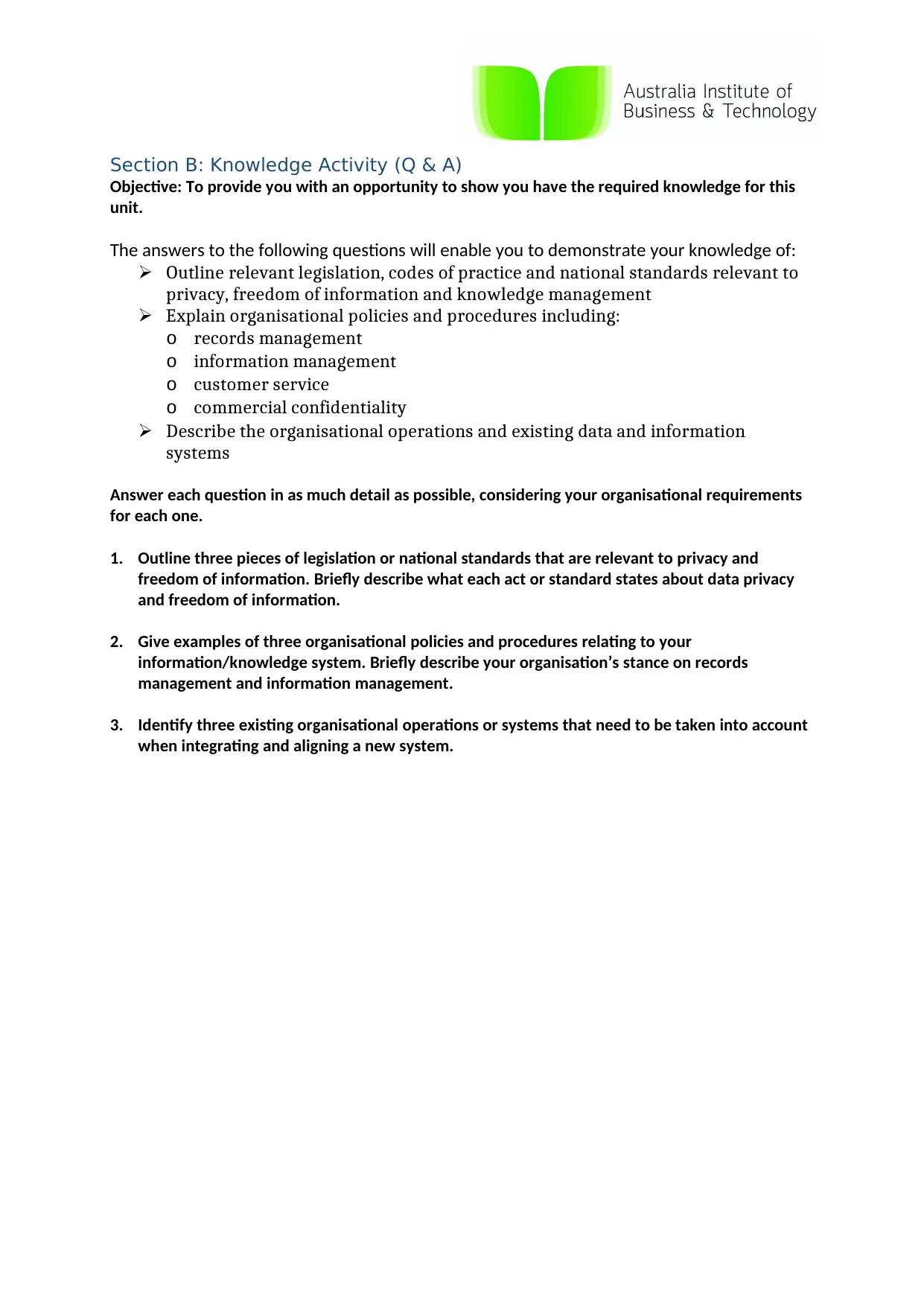
Section B: Knowledge Activity (Q & A)
Objective: To provide you with an opportunity to show you have the required knowledge for this
unit.
The answers to the following questions will enable you to demonstrate your knowledge of:
Outline relevant legislation, codes of practice and national standards relevant to
privacy, freedom of information and knowledge management
Explain organisational policies and procedures including:
o records management
o information management
o customer service
o commercial confidentiality
Describe the organisational operations and existing data and information
systems
Answer each question in as much detail as possible, considering your organisational requirements
for each one.
1. Outline three pieces of legislation or national standards that are relevant to privacy and
freedom of information. Briefly describe what each act or standard states about data privacy
and freedom of information.
2. Give examples of three organisational policies and procedures relating to your
information/knowledge system. Briefly describe your organisation’s stance on records
management and information management.
3. Identify three existing organisational operations or systems that need to be taken into account
when integrating and aligning a new system.
Objective: To provide you with an opportunity to show you have the required knowledge for this
unit.
The answers to the following questions will enable you to demonstrate your knowledge of:
Outline relevant legislation, codes of practice and national standards relevant to
privacy, freedom of information and knowledge management
Explain organisational policies and procedures including:
o records management
o information management
o customer service
o commercial confidentiality
Describe the organisational operations and existing data and information
systems
Answer each question in as much detail as possible, considering your organisational requirements
for each one.
1. Outline three pieces of legislation or national standards that are relevant to privacy and
freedom of information. Briefly describe what each act or standard states about data privacy
and freedom of information.
2. Give examples of three organisational policies and procedures relating to your
information/knowledge system. Briefly describe your organisation’s stance on records
management and information management.
3. Identify three existing organisational operations or systems that need to be taken into account
when integrating and aligning a new system.
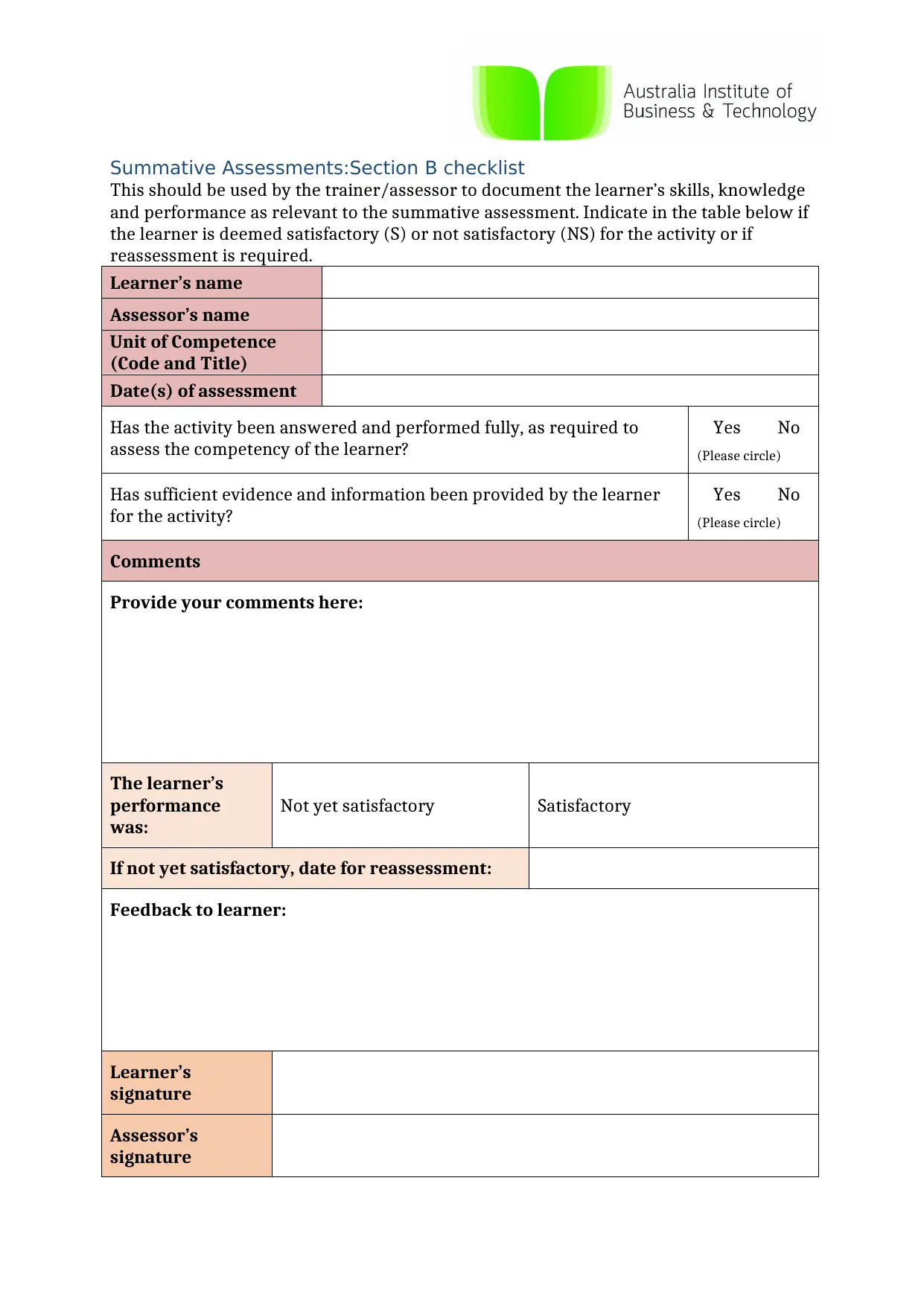
Summative Assessments:Section B checklist
This should be used by the trainer/assessor to document the learner’s skills, knowledge
and performance as relevant to the summative assessment. Indicate in the table below if
the learner is deemed satisfactory (S) or not satisfactory (NS) for the activity or if
reassessment is required.
Learner’s name
Assessor’s name
Unit of Competence
(Code and Title)
Date(s) of assessment
Has the activity been answered and performed fully, as required to
assess the competency of the learner?
Yes No
(Please circle)
Has sufficient evidence and information been provided by the learner
for the activity?
Yes No
(Please circle)
Comments
Provide your comments here:
The learner’s
performance
was:
Not yet satisfactory Satisfactory
If not yet satisfactory, date for reassessment:
Feedback to learner:
Learner’s
signature
Assessor’s
signature
This should be used by the trainer/assessor to document the learner’s skills, knowledge
and performance as relevant to the summative assessment. Indicate in the table below if
the learner is deemed satisfactory (S) or not satisfactory (NS) for the activity or if
reassessment is required.
Learner’s name
Assessor’s name
Unit of Competence
(Code and Title)
Date(s) of assessment
Has the activity been answered and performed fully, as required to
assess the competency of the learner?
Yes No
(Please circle)
Has sufficient evidence and information been provided by the learner
for the activity?
Yes No
(Please circle)
Comments
Provide your comments here:
The learner’s
performance
was:
Not yet satisfactory Satisfactory
If not yet satisfactory, date for reassessment:
Feedback to learner:
Learner’s
signature
Assessor’s
signature
Secure Best Marks with AI Grader
Need help grading? Try our AI Grader for instant feedback on your assignments.
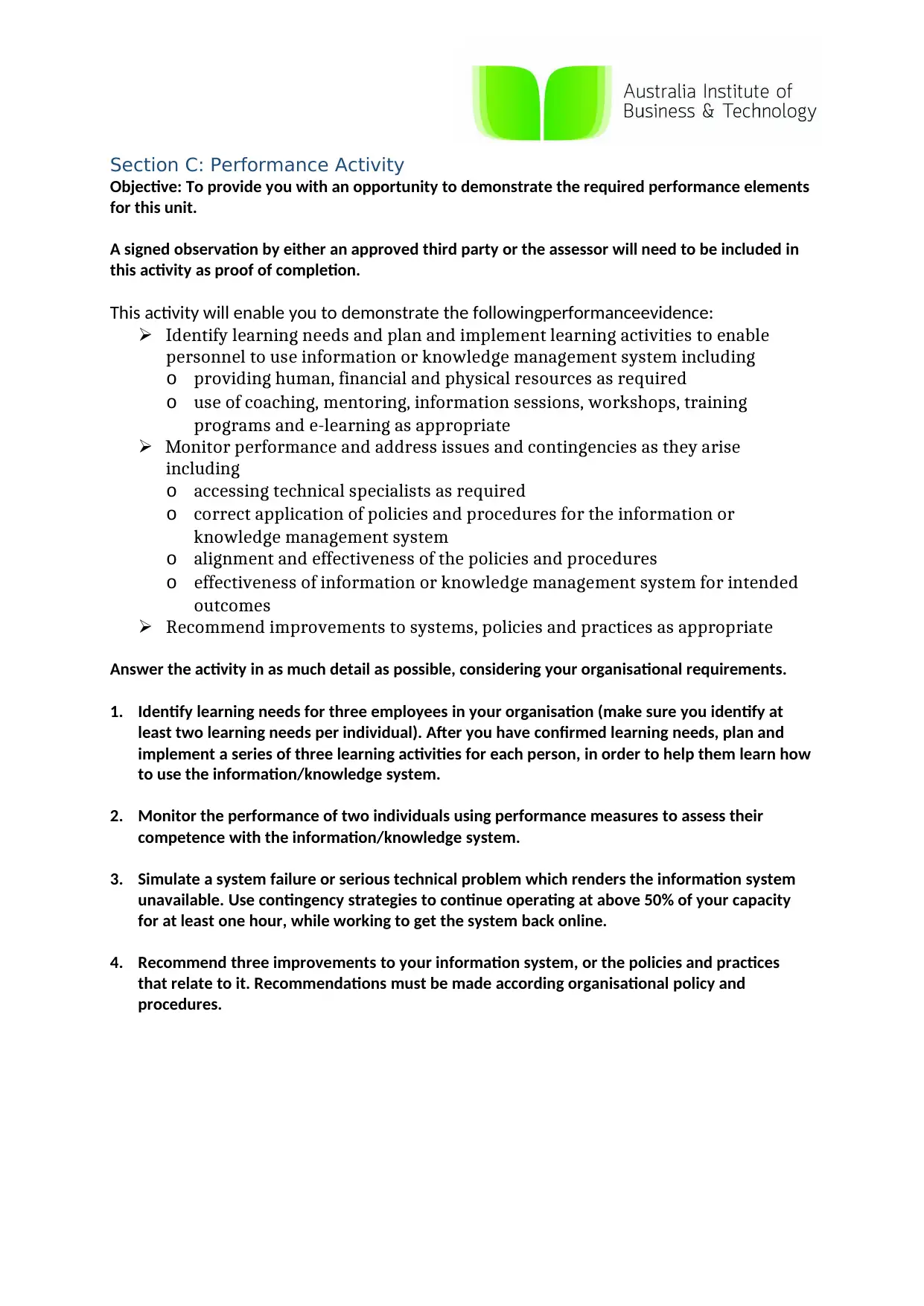
Section C: Performance Activity
Objective: To provide you with an opportunity to demonstrate the required performance elements
for this unit.
A signed observation by either an approved third party or the assessor will need to be included in
this activity as proof of completion.
This activity will enable you to demonstrate the followingperformanceevidence:
Identify learning needs and plan and implement learning activities to enable
personnel to use information or knowledge management system including
o providing human, financial and physical resources as required
o use of coaching, mentoring, information sessions, workshops, training
programs and e-learning as appropriate
Monitor performance and address issues and contingencies as they arise
including
o accessing technical specialists as required
o correct application of policies and procedures for the information or
knowledge management system
o alignment and effectiveness of the policies and procedures
o effectiveness of information or knowledge management system for intended
outcomes
Recommend improvements to systems, policies and practices as appropriate
Answer the activity in as much detail as possible, considering your organisational requirements.
1. Identify learning needs for three employees in your organisation (make sure you identify at
least two learning needs per individual). After you have confirmed learning needs, plan and
implement a series of three learning activities for each person, in order to help them learn how
to use the information/knowledge system.
2. Monitor the performance of two individuals using performance measures to assess their
competence with the information/knowledge system.
3. Simulate a system failure or serious technical problem which renders the information system
unavailable. Use contingency strategies to continue operating at above 50% of your capacity
for at least one hour, while working to get the system back online.
4. Recommend three improvements to your information system, or the policies and practices
that relate to it. Recommendations must be made according organisational policy and
procedures.
Objective: To provide you with an opportunity to demonstrate the required performance elements
for this unit.
A signed observation by either an approved third party or the assessor will need to be included in
this activity as proof of completion.
This activity will enable you to demonstrate the followingperformanceevidence:
Identify learning needs and plan and implement learning activities to enable
personnel to use information or knowledge management system including
o providing human, financial and physical resources as required
o use of coaching, mentoring, information sessions, workshops, training
programs and e-learning as appropriate
Monitor performance and address issues and contingencies as they arise
including
o accessing technical specialists as required
o correct application of policies and procedures for the information or
knowledge management system
o alignment and effectiveness of the policies and procedures
o effectiveness of information or knowledge management system for intended
outcomes
Recommend improvements to systems, policies and practices as appropriate
Answer the activity in as much detail as possible, considering your organisational requirements.
1. Identify learning needs for three employees in your organisation (make sure you identify at
least two learning needs per individual). After you have confirmed learning needs, plan and
implement a series of three learning activities for each person, in order to help them learn how
to use the information/knowledge system.
2. Monitor the performance of two individuals using performance measures to assess their
competence with the information/knowledge system.
3. Simulate a system failure or serious technical problem which renders the information system
unavailable. Use contingency strategies to continue operating at above 50% of your capacity
for at least one hour, while working to get the system back online.
4. Recommend three improvements to your information system, or the policies and practices
that relate to it. Recommendations must be made according organisational policy and
procedures.
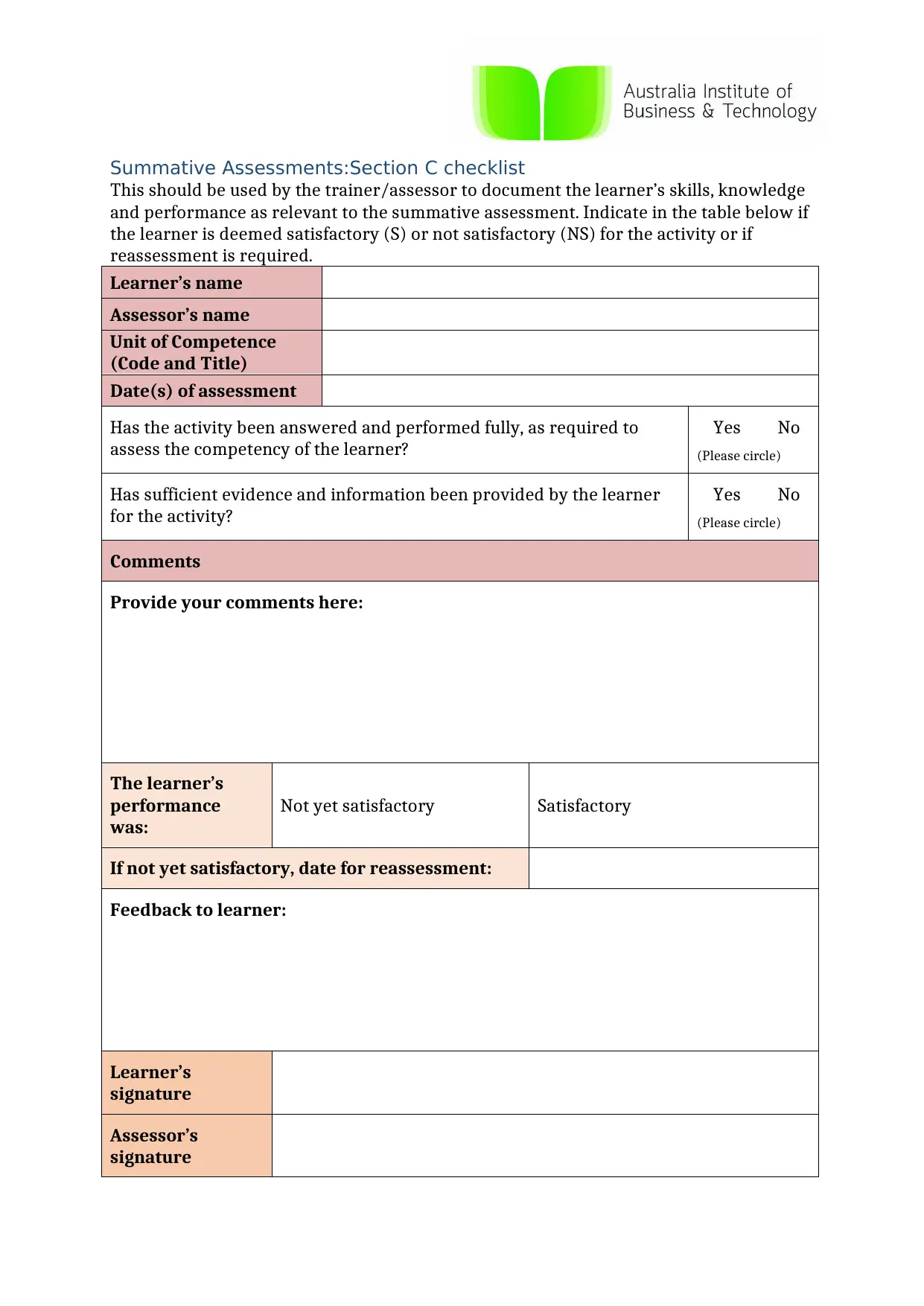
Summative Assessments:Section C checklist
This should be used by the trainer/assessor to document the learner’s skills, knowledge
and performance as relevant to the summative assessment. Indicate in the table below if
the learner is deemed satisfactory (S) or not satisfactory (NS) for the activity or if
reassessment is required.
Learner’s name
Assessor’s name
Unit of Competence
(Code and Title)
Date(s) of assessment
Has the activity been answered and performed fully, as required to
assess the competency of the learner?
Yes No
(Please circle)
Has sufficient evidence and information been provided by the learner
for the activity?
Yes No
(Please circle)
Comments
Provide your comments here:
The learner’s
performance
was:
Not yet satisfactory Satisfactory
If not yet satisfactory, date for reassessment:
Feedback to learner:
Learner’s
signature
Assessor’s
signature
This should be used by the trainer/assessor to document the learner’s skills, knowledge
and performance as relevant to the summative assessment. Indicate in the table below if
the learner is deemed satisfactory (S) or not satisfactory (NS) for the activity or if
reassessment is required.
Learner’s name
Assessor’s name
Unit of Competence
(Code and Title)
Date(s) of assessment
Has the activity been answered and performed fully, as required to
assess the competency of the learner?
Yes No
(Please circle)
Has sufficient evidence and information been provided by the learner
for the activity?
Yes No
(Please circle)
Comments
Provide your comments here:
The learner’s
performance
was:
Not yet satisfactory Satisfactory
If not yet satisfactory, date for reassessment:
Feedback to learner:
Learner’s
signature
Assessor’s
signature
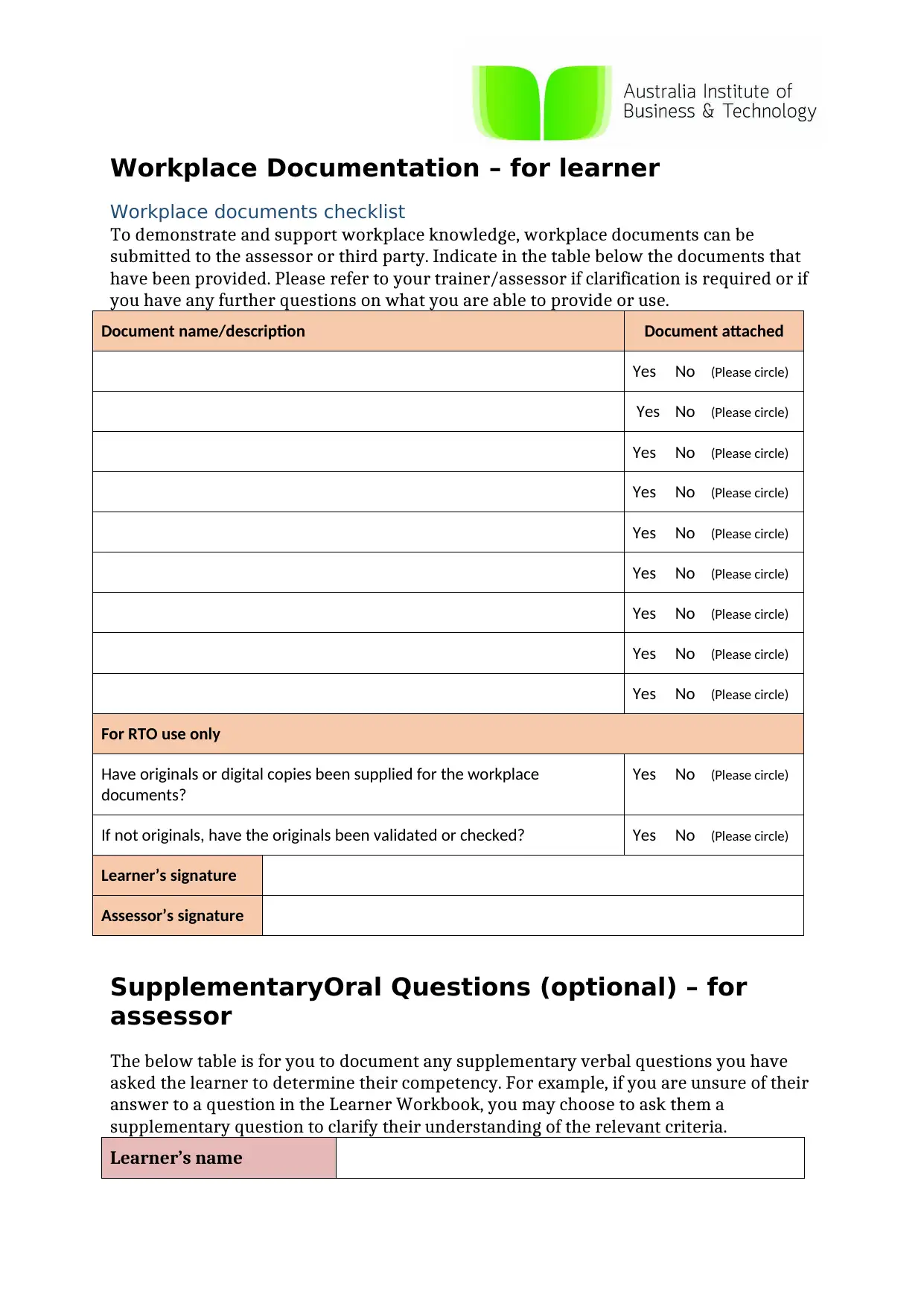
Workplace Documentation – for learner
Workplace documents checklist
To demonstrate and support workplace knowledge, workplace documents can be
submitted to the assessor or third party. Indicate in the table below the documents that
have been provided. Please refer to your trainer/assessor if clarification is required or if
you have any further questions on what you are able to provide or use.
Document name/description Document attached
Yes No (Please circle)
Yes No (Please circle)
Yes No (Please circle)
Yes No (Please circle)
Yes No (Please circle)
Yes No (Please circle)
Yes No (Please circle)
Yes No (Please circle)
Yes No (Please circle)
For RTO use only
Have originals or digital copies been supplied for the workplace
documents?
Yes No (Please circle)
If not originals, have the originals been validated or checked? Yes No (Please circle)
Learner’s signature
Assessor’s signature
SupplementaryOral Questions (optional) – for
assessor
The below table is for you to document any supplementary verbal questions you have
asked the learner to determine their competency. For example, if you are unsure of their
answer to a question in the Learner Workbook, you may choose to ask them a
supplementary question to clarify their understanding of the relevant criteria.
Learner’s name
Workplace documents checklist
To demonstrate and support workplace knowledge, workplace documents can be
submitted to the assessor or third party. Indicate in the table below the documents that
have been provided. Please refer to your trainer/assessor if clarification is required or if
you have any further questions on what you are able to provide or use.
Document name/description Document attached
Yes No (Please circle)
Yes No (Please circle)
Yes No (Please circle)
Yes No (Please circle)
Yes No (Please circle)
Yes No (Please circle)
Yes No (Please circle)
Yes No (Please circle)
Yes No (Please circle)
For RTO use only
Have originals or digital copies been supplied for the workplace
documents?
Yes No (Please circle)
If not originals, have the originals been validated or checked? Yes No (Please circle)
Learner’s signature
Assessor’s signature
SupplementaryOral Questions (optional) – for
assessor
The below table is for you to document any supplementary verbal questions you have
asked the learner to determine their competency. For example, if you are unsure of their
answer to a question in the Learner Workbook, you may choose to ask them a
supplementary question to clarify their understanding of the relevant criteria.
Learner’s name
Paraphrase This Document
Need a fresh take? Get an instant paraphrase of this document with our AI Paraphraser
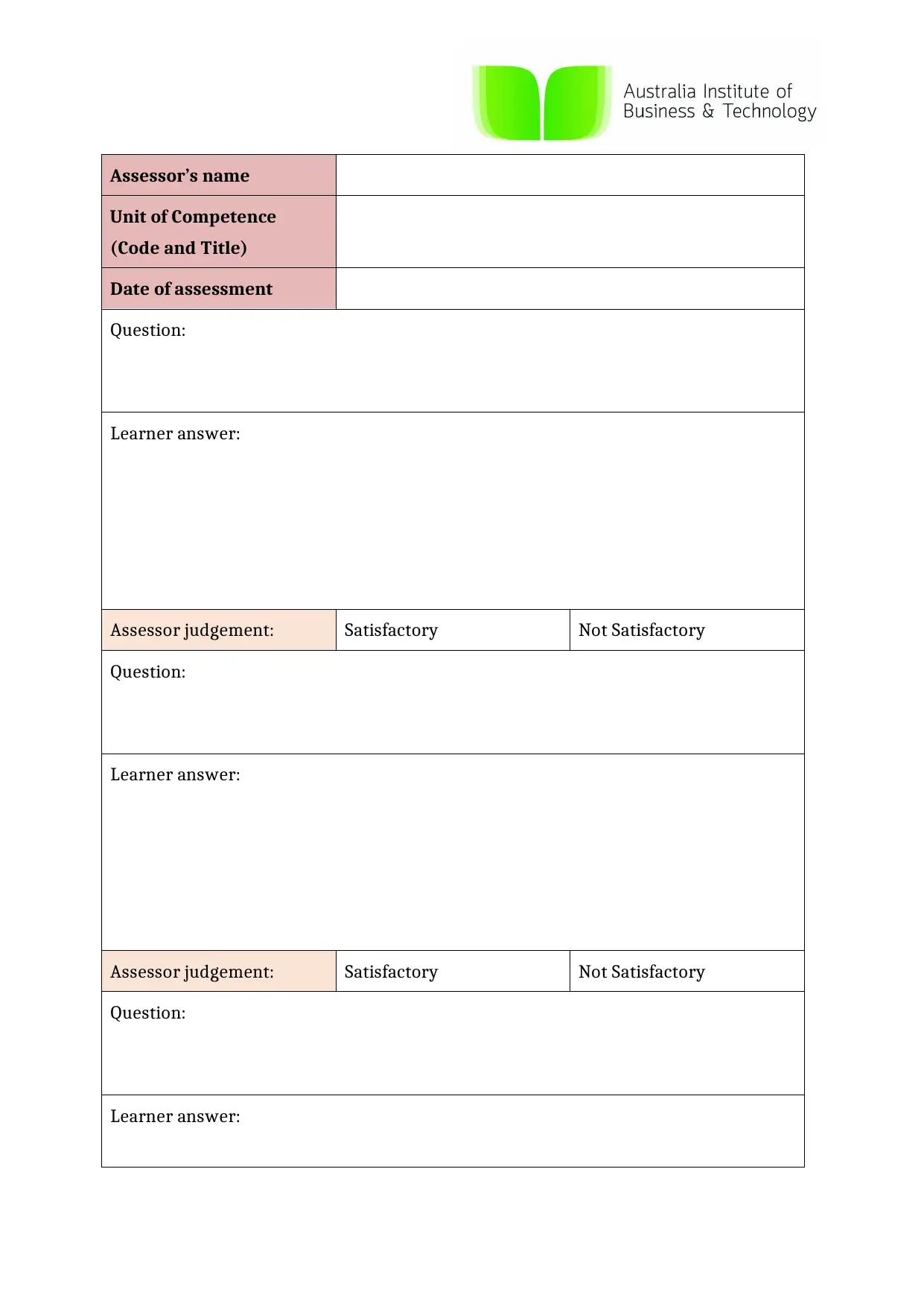
Assessor’s name
Unit of Competence
(Code and Title)
Date of assessment
Question:
Learner answer:
Assessor judgement: Satisfactory Not Satisfactory
Question:
Learner answer:
Assessor judgement: Satisfactory Not Satisfactory
Question:
Learner answer:
Unit of Competence
(Code and Title)
Date of assessment
Question:
Learner answer:
Assessor judgement: Satisfactory Not Satisfactory
Question:
Learner answer:
Assessor judgement: Satisfactory Not Satisfactory
Question:
Learner answer:
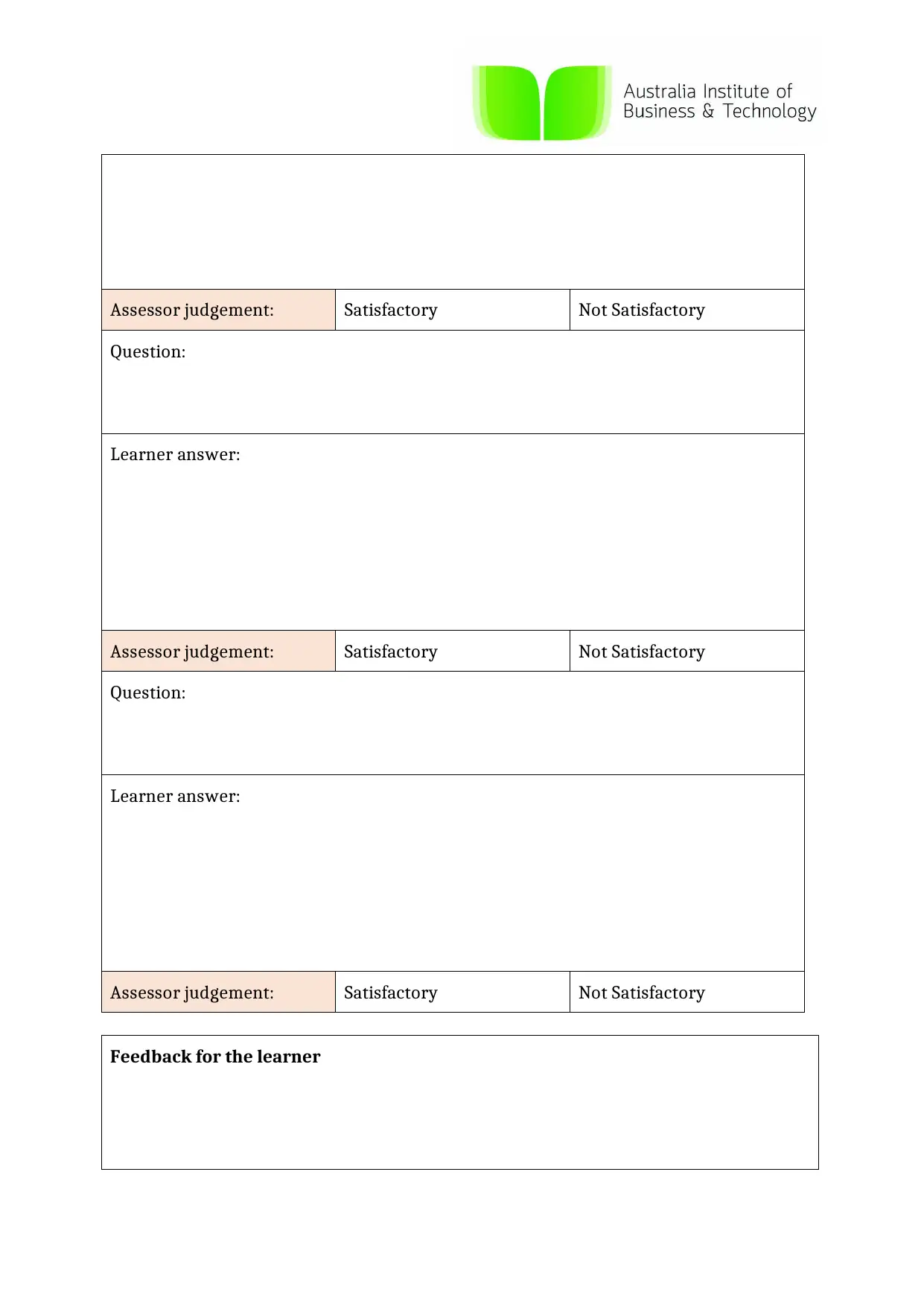
Assessor judgement: Satisfactory Not Satisfactory
Question:
Learner answer:
Assessor judgement: Satisfactory Not Satisfactory
Question:
Learner answer:
Assessor judgement: Satisfactory Not Satisfactory
Feedback for the learner
Question:
Learner answer:
Assessor judgement: Satisfactory Not Satisfactory
Question:
Learner answer:
Assessor judgement: Satisfactory Not Satisfactory
Feedback for the learner
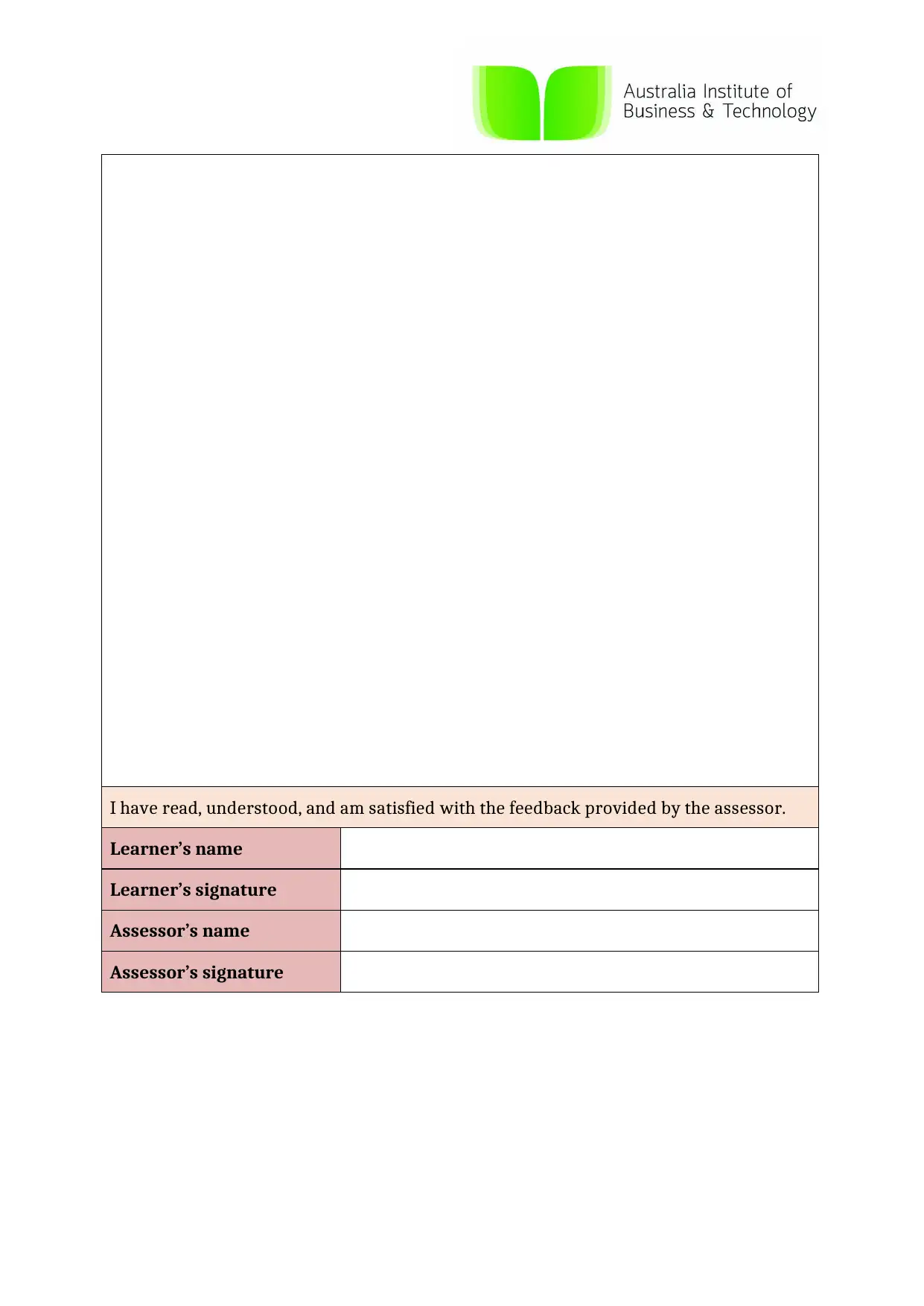
I have read, understood, and am satisfied with the feedback provided by the assessor.
Learner’s name
Learner’s signature
Assessor’s name
Assessor’s signature
Learner’s name
Learner’s signature
Assessor’s name
Assessor’s signature
Secure Best Marks with AI Grader
Need help grading? Try our AI Grader for instant feedback on your assignments.
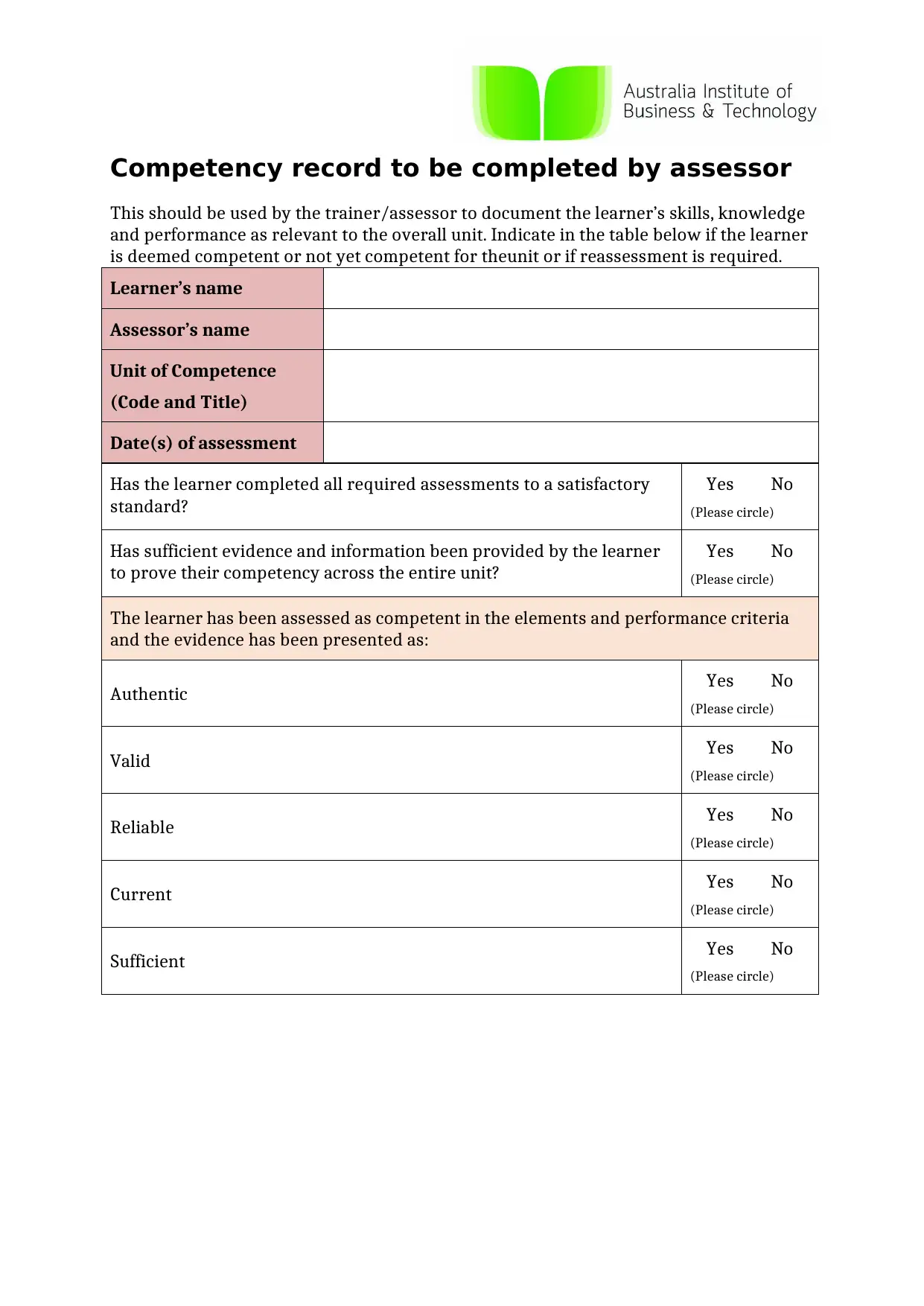
Competency record to be completed by assessor
This should be used by the trainer/assessor to document the learner’s skills, knowledge
and performance as relevant to the overall unit. Indicate in the table below if the learner
is deemed competent or not yet competent for theunit or if reassessment is required.
Learner’s name
Assessor’s name
Unit of Competence
(Code and Title)
Date(s) of assessment
Has the learner completed all required assessments to a satisfactory
standard?
Yes No
(Please circle)
Has sufficient evidence and information been provided by the learner
to prove their competency across the entire unit?
Yes No
(Please circle)
The learner has been assessed as competent in the elements and performance criteria
and the evidence has been presented as:
Authentic Yes No
(Please circle)
Valid Yes No
(Please circle)
Reliable Yes No
(Please circle)
Current Yes No
(Please circle)
Sufficient Yes No
(Please circle)
This should be used by the trainer/assessor to document the learner’s skills, knowledge
and performance as relevant to the overall unit. Indicate in the table below if the learner
is deemed competent or not yet competent for theunit or if reassessment is required.
Learner’s name
Assessor’s name
Unit of Competence
(Code and Title)
Date(s) of assessment
Has the learner completed all required assessments to a satisfactory
standard?
Yes No
(Please circle)
Has sufficient evidence and information been provided by the learner
to prove their competency across the entire unit?
Yes No
(Please circle)
The learner has been assessed as competent in the elements and performance criteria
and the evidence has been presented as:
Authentic Yes No
(Please circle)
Valid Yes No
(Please circle)
Reliable Yes No
(Please circle)
Current Yes No
(Please circle)
Sufficient Yes No
(Please circle)

Learner is
deemed: Not yet competent Competent
If not yet competent, date for re-assessment:
Comments from trainer/assessor:
Learner’s
signature
Assessor’s
signature
deemed: Not yet competent Competent
If not yet competent, date for re-assessment:
Comments from trainer/assessor:
Learner’s
signature
Assessor’s
signature

Paraphrase This Document
Need a fresh take? Get an instant paraphrase of this document with our AI Paraphraser
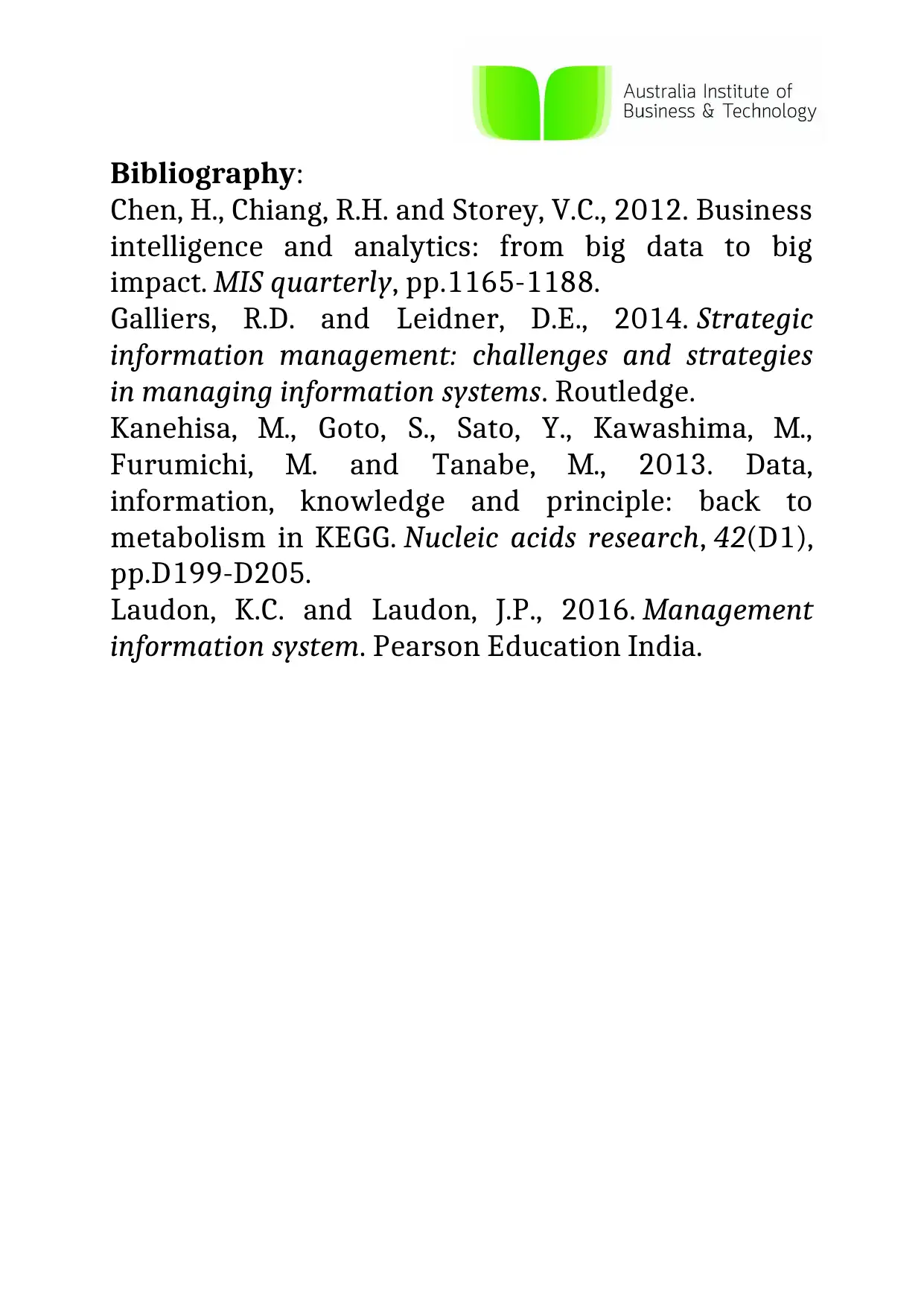
Bibliography:
Chen, H., Chiang, R.H. and Storey, V.C., 2012. Business
intelligence and analytics: from big data to big
impact. MIS quarterly, pp.1165-1188.
Galliers, R.D. and Leidner, D.E., 2014. Strategic
information management: challenges and strategies
in managing information systems. Routledge.
Kanehisa, M., Goto, S., Sato, Y., Kawashima, M.,
Furumichi, M. and Tanabe, M., 2013. Data,
information, knowledge and principle: back to
metabolism in KEGG. Nucleic acids research, 42(D1),
pp.D199-D205.
Laudon, K.C. and Laudon, J.P., 2016. Management
information system. Pearson Education India.
Chen, H., Chiang, R.H. and Storey, V.C., 2012. Business
intelligence and analytics: from big data to big
impact. MIS quarterly, pp.1165-1188.
Galliers, R.D. and Leidner, D.E., 2014. Strategic
information management: challenges and strategies
in managing information systems. Routledge.
Kanehisa, M., Goto, S., Sato, Y., Kawashima, M.,
Furumichi, M. and Tanabe, M., 2013. Data,
information, knowledge and principle: back to
metabolism in KEGG. Nucleic acids research, 42(D1),
pp.D199-D205.
Laudon, K.C. and Laudon, J.P., 2016. Management
information system. Pearson Education India.
1 out of 50
Related Documents
Your All-in-One AI-Powered Toolkit for Academic Success.
+13062052269
info@desklib.com
Available 24*7 on WhatsApp / Email
![[object Object]](/_next/static/media/star-bottom.7253800d.svg)
Unlock your academic potential
© 2024 | Zucol Services PVT LTD | All rights reserved.




